
Our Wanders

10 Things To Know Before Visiting North Macedonia

We’ve been planning a Balkan road trip for years, and we just kept postponing it for several reasons. Then we jumped into it with the random idea that instead of Montenegro and Bosnia and maybe Albania, let’s visit North Macedonia. Why not? It has Lake Ohrid – and it does have Lake Ohrid, and it’s beautiful! But this country has much more to offer – without the crowds, because it’s among the most underrated countries in Europe.
What do you actually know about it? And what should you know about it to decide whether you’d like a visit there, and how to make the most of it? We’re here to tell you. This post is all about the useful things to know before traveling to North Macedonia.
Where is North Macedonia located?

North Macedonia is one of the countries of the Balkan Peninsula , bordering Bulgaria to the east, Greece to the south, Serbia and Kosovo to the north and Albania to the west.
Though it’s in Europe, it’s not part of the European Union. For travelers it comes with both advantages and disadvantages. It’s not part of the Schengen zone, so it doesn’t count towards the days you can spend there. But it has its own currency: Macedonian Denar – and I recommend you to exchange some cash, because accepting cards is not exactly the norm there.
If you live in the EU (or have a SIM card from one of the EU countries) and enjoy no additional charges to use your mobile phone in other EU countries, then don’t forget it won’t apply to North Macedonia. You better buy a local SIM card to avoid high roaming fees.
We spent about 40 minutes at a gas station to buy a physical SIM card, and without the help of the kind shop assistant we wouldn’t have succeeded, as activating it involved long discussion with the company via phone in Macedonian. Since then we know a much easier solution that only takes a few clicks: get an eSIM .
The name: North Macedonia

Then the name of the country – and a statement: while we use the name North Macedonia, this is not a political statement, we merely use the official name of the country.
But it was called Macedonia until February 2019 , the renaming happened mainly in order to stop Greece from vetoing Macedonia’s entrance to the European Union. And it happened after years of UN-mediated negotiations between Greece and Macedonia, and also after a referendum which was boycotted by nearly 65% of the Macedonians. Hence it’s a sensitive and controversial topic, and many locals don’t accept the new name.
We are not here to summarize such a complex issue in a few sentences, but we’re telling you whether you call this country Macedonia or North Macedonia, someone will get offended. Since you can’t really avoid calling it something , we encourage you to be open and listen to the opinions and stories of local people – and also to do a bit of research about the history of this region when you plan a trip to Macedonia. Or North Macedonia.
It’s the land of mountains

If you love mountains, this is your country as 85% of its territory is covered in mountains . With more than 30 peaks rising above 2000 metres, North Macedonia offers challenges, countless trails and pretty panoramic views. Ski resorts, too, in the winter. Its three national parks are all located in mountains: Pelister , Mavrovo and Galičica National Parks. Visiting them is among the best things to do in North Macedonia.
It’s really off the beaten path
We know it’s such a cliché, but it’s also very accurate in this case. Europe in general is touristy. Balkan countries are gaining popularity, and some of them are also very touristy. North Macedonia is not one of them – yet. Even people who take a road trip in the Balkans often only include a short stop in Skopje or at Lake Ohrid in their itinerary.
Our opinion is that this country deserves to be more than just a stop on your way to somewhere else. A North Macedonia road trip can stand on his own.
But being so undiscovered by tourists comes with both advantages and disadvantages. It’s not flooded with tourists, that’s the obvious advantage. In fact, we barely met any foreign visitors during the two weeks we spent there. We know it was partially due to COVID (in 2021), but we also know that lots of people don’t have a clue what’s worth seeing in North Macedonia.
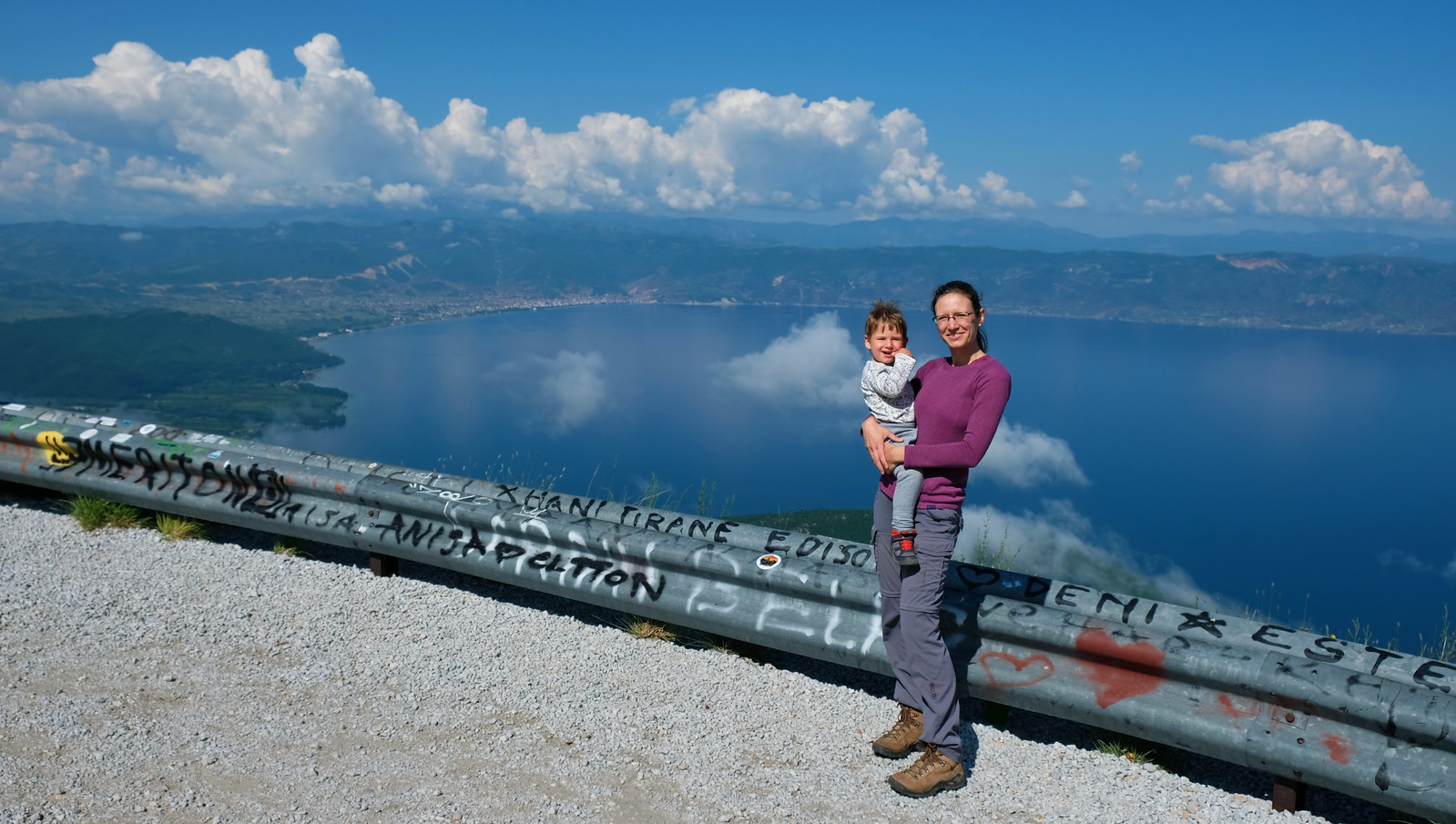
And there’s a lot to see, both natural and cultural attractions! But since it’s off the beaten path, sights are often not easy to research online, and detailed road and trail information is especially hard to come by. (Hey, adventurers, you can really explore here!)
Once we turned back on a dirt mountain road that our car was just not suitable for. Once we turned back on a trail which was so poorly marked and maintained that we spent more than half an hour looking for the next marker and didn’t manage to find it.
We tell this not to scare you away from this beautiful country, but you need flexibility and an adventurous soul to enjoy exploring its lesser known areas. With that said, there are easily navigable areas like Skopje, Matka Canyon or Lake Ohrid. And you can also find local guides and tour companies , if you’re not confident to explore on your own.
If you’re not sure what to see in North Macedonia and would like me to help you put together your best North Macedonia itinerary, click here and let’s get started!
It’s a country where different cultures meet

East and West. Asia and Europe. Islam and Christianity.
Religion is tied to ethnic and national identity here, and North Macedonia is mostly populated by Macedonians who are of Slavic origin and are Orthodox Christians, and by Albanians who are Muslims. Albanians are the largest minority, one-third of the inhabitants. Hence North Macedonia is a border zone of different cultures and traditions, and rich in both churches and mosques.
Does North Macedonia have beaches?

Unlike Albania or Montenegro, North Macedonia doesn’t have any seashore. But it has Lake Ohrid! You might think “well, fine, but that’s still only a lake at the end”. Yes and no. It’s a lake, one of Europe’s deepest and oldest lakes, that Macedonia shares with Albania. While we’ve seen many lakes before, Lake Ohrid still knocked us off our feet .
It’s really that beautiful! Some of its bays can be mistaken for the bays of the Adriatic Sea. The water is clear and has an incredibly blue shade. Its beaches are pebbly or rocky, and you can swim in the water. The best beaches in North Macedonia are to be found on the shore of Lake Ohrid.
Lake Prespa is not comparable to Lake Ohrid
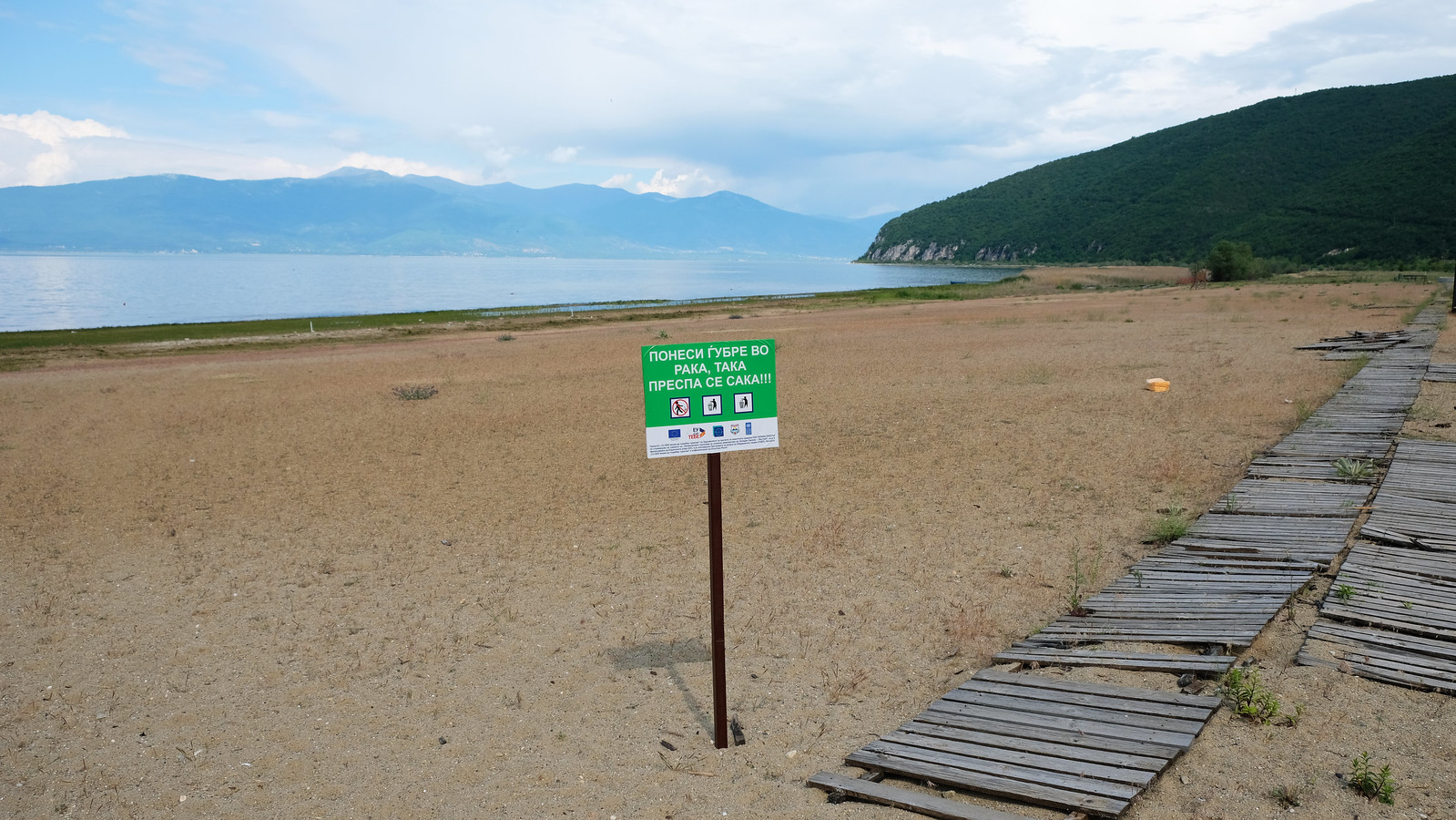
They’re the two largest lakes in the country, they’re both tectonic lakes, and their source is the same, too. Yet if you consider from a visitor’s point of view, you can easily spend a week at Lake Ohrid, swimming, paddleboarding, hiking, taking boat tours, visiting the town of Ohrid or the monastery of Saint Naum, while Lake Prespa doesn’t offer much . What we liked about it the most was the views of the lake from Galičica and Pelister National Parks.
We also stopped at Stenje Beach and Slivnica Beach on the shore of Lake Prespa, but we found them disappointing. They’re abandoned and look lifeless. The jetty is broken, the toys on the playgrounds are broken, and the shore of the lake is swampy. We don’t know if anyone uses these beaches anymore, but they gave us the impression that they don’t, and it was not hard to understand why. It was a sad sight, no one was there on that hot June day, and we, too, quickly continued our way towards Bitola.
Skopje, the capital is both very old and new
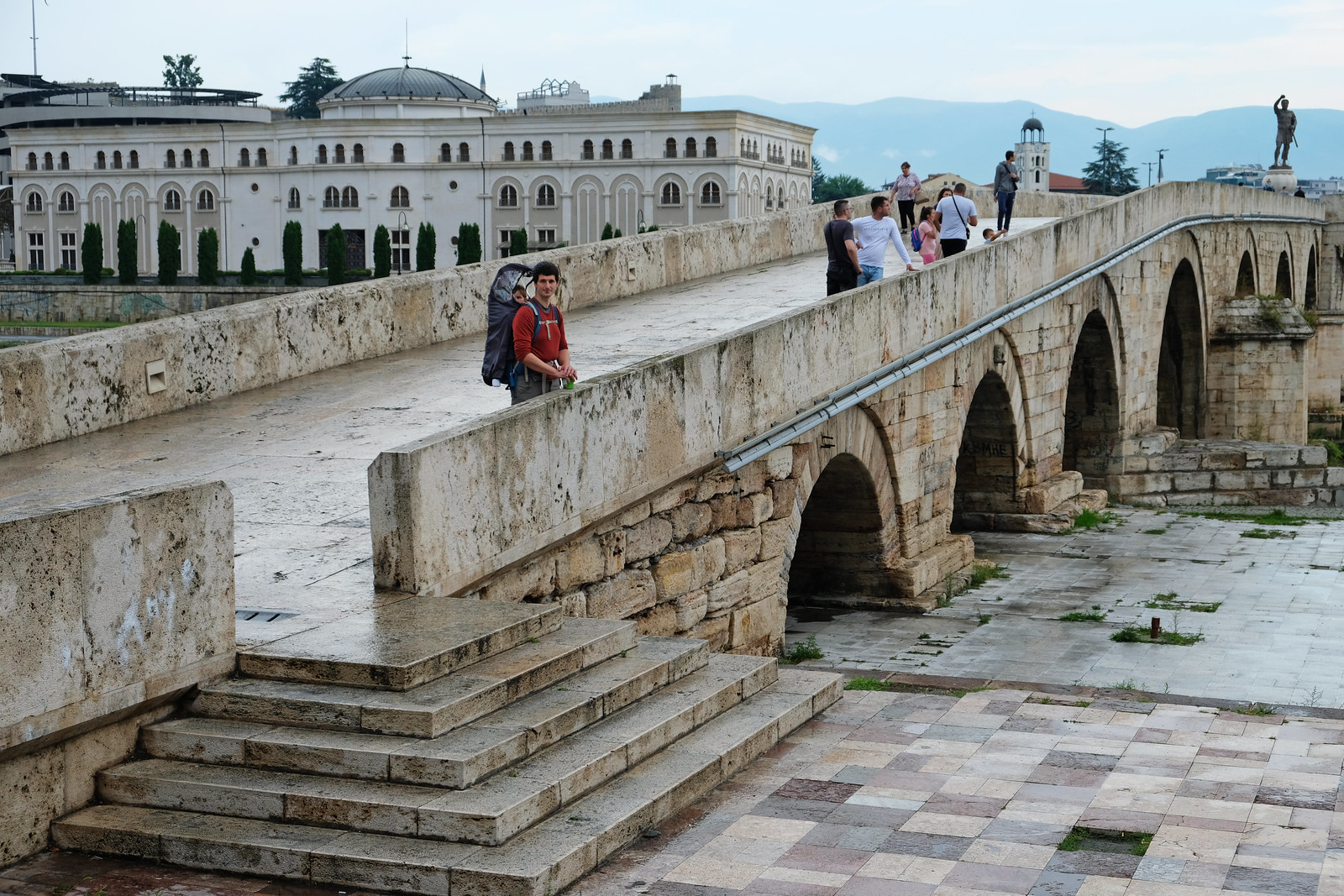
Skopje is an ancient city, it’s inhabited since at least 4000 BC. Remains of this ancient settlement can be found within the old Kale Fortress. The Stone Bridge that connects the main square, Macedonia Square to the Old Bazaar was built on Roman foundations.
But an earthquake destroyed approximately 80% of the city in 1963, hence a project called Skopje 2014 was introduced to give back the classical appeal of Skopje. Between 2010 and 2014, 136 structures were built. The project was heavily criticized though, stating it was too expensive and a waste of resources, and also that it was an attempt to change the nation’s history. Of course, some criticized the aesthetics of the buildings, too.
Whatever you think or know about Skopje 2014, you’ll definitely notice these new classical buildings when walking around in Skopje’s center.
Sign up for a full day guided tour to see the highlights of Skopje – and this one also includes visiting nearby Matka Canyon.
Hospitality

Traveling a lot in Europe and living in Budapest, a city that struggles with overtourism (not in the years of COVID, but in general), we got used to the fact that people are often neutral or even irritated with tourists. Well, not in North Macedonia. We felt welcomed, we felt that locals were happy to see us there, exploring their country.
Some of them spoke English, many of them not, but they were all eager to know where we came from or what places we visited in the country. They were also very warm and friendly towards our little Tomi, asking his name, showing him cute kittens that he can cuddle or giving him chocolate. (Here I have to confess that I ate that chocolate, all of it. 😛 We haven’t given Tomi any chocolate yet, and want to keep it that way until we can.)
The thing we liked the least: driving in North Macedonia

No, it’s not even the roads. Though the roads are of varied quality, most of the roads we took were acceptable, and the motorway was fine. (But don’t count on Google Maps! It may tell you to drive on “roads” that are actually trails.)
Our problem was the driving culture. We barely managed to avoid two accidents, caused by careless drivers who passed other cars on mountain roads where one can’t even see whether another car is coming. It looked like they didn’t even care, even though we were coming , and luckily we pulled our car off the road both times to avoid a head-on collision – and luckily, there was a grassy area and a small parking area (for the second time) where we could actually pull off safely.
We know it’s not a typical North Macedonia thing, rather typical to all Balkan countries. Speed limits, lanes, prohibition signs seem to be optional to a lot of people, and they often simply ignore it. Be very careful and vigilant, especially on narrow mountain roads! (And we know, it’s not enough for you to be careful, others should be, too.)
So is North Macedonia worth a visit?
This post is far from being a North Macedonia travel guide, but it’s a good intro. And you already know our opinion: yes, North Macedonia is worth a visit, and we’ve written several posts about our favorite places in the country – check them out here.
Have you been to the Balkans? Which are your favorite places there?
Disclosure: Please note that affiliate links are used in this post, and at no additional cost to you, we earn a commission if you make a purchase. Thank you!
By Beata Urmos
Bea is a travel writer and the co-founder of Our Wanders, an adventurous family travel blog. She’s been traveling for more than 10 years, seeking outdoor adventures, fairy tale castles and unique experiences. She's passionate about sharing all she has learned along the way, and she's an expert in planning trips of any length. She’d love to help you plan your own amazing trip, too.
Leave a comment Cancel reply
Your email address will not be published. Required fields are marked *
Save my name, email, and website in this browser for the next time I comment.
This site uses Akismet to reduce spam. Learn how your comment data is processed .
9 Things to Know Before Visiting North Macedonia

Disclosure: This post (probably) contains affiliate links. If you click on one, I may make a small commission. Of course, this will come at no extra cost to you and helps keep this site running.
While I do like to do my research before visiting a country, I was struggling to find much on the small landlocked Balkan nation of Macedonia , now North Macedonia . Other than a recommendation during my travels to visit Lake Ohrid and knowledge that the country’s capital is Skopje , I was mostly flying blind. This country is quite low-key and it’s only by visiting Macedonia that you get a chance to find out what a fun, intriguing place it is.
I think in part why so few people tend to travel to North Macedonia, is that it simply hasn’t been put on their radar. This is a real shame as I do feel that does manage to meet many tourists’ needs, despite its underdeveloped tourism infrastructure. Sharing my stories and photos of my time visiting Macedonia has been a lot of fun because of the responses they’ve gotten, from travellers getting a chance to see what the country is about, to local Macedonians being glad to see their country promoted.
In the hopes that I can further encourage you to give visiting North Macedonia a try, here are 9 useful or fun things to know about travelling to the country.
Table of Contents
1. A “Hidden Gem”

I generally avoid using phrases like “hidden gem” or “off the beaten path” because I think they’re overused when people talk about travel. Also, probably a lot of the places I write about qualify. Either way, know that when I say the Republic of Macedonia is a hidden gem, I mean it.
While more and more of the Balkans are becoming popular with tourists (think Croatia), Macedonia seems remarkably unaffected. Sure, there are decent tourist numbers at Lake Ohrid and to a lesser extent Skopje, but that seems pretty much it.
So that’s the hidden, but what about the gem? Well, Macedonia is home to a range of interesting sights and things for tourists from landscapes, to historical and cultural landmarks. There’s the “Pearl of Macedonia” in the gorgeous Lake Ohrid , to the rugged hills outside Prilep.
The country has plenty of gripping historical sites too, like Heraclea Lyncestis or its numerous medieval fortresses. Then there’s all the wonderful cultural insights you’re able to find, from the tobacco production in Prilep to countless bazaars, to the intriguing remnants of its communist past. Macedonia has plenty to offer those who choose to visit it.
2. Entry and Visa
The Republic of Macedonia is not part of the European Union, nor is it part of the Schengen Area that allows free movement between countries, something many EU countries currently benefit from.
This could make it a challenge to visit but it isn’t too bad. In effect, if you’re from an EU member country, a valid ID is all that’s needed while if you would normally fit under the Schengen Agreement, then you have up to 15 days visa-free. For visa information, here is one place to start .
Crossing the border from Bulgaria to Macedonia, our minibus was stopped and we walked up to the border guard booth. One by one, we had our passports checked and then we simply met back up with our bus. Couldn’t have been more straightforward.
3. Getting Around

Sticking with my general rule of thumb for the Balkans, I went by bus all the way during my stay in Macedonia. I honestly don’t know if there is an operating train network presently, but I was content with the decent bus network. As would be expected, Skopje and Ohrid have the most connections but there are enough that you shouldn’t find getting about too hard.
Bus fares are dirt cheap (see #5), running between 3-8€ depending on the distance. Information can be found online at Balkan Viator , but it always pays to check at the station as I encountered the occasional discrepancy.
Another way to get about, at least short distances in share taxis which are quite common in the Balkans. I only took the one in Macedonia from Ohrid to Struga and while it was more than the bus fare, it was quicker and I got to have a nice chat with the driver about various things. It seems to be that they wait near bus stops to gather fares, so that’s really my only advice for finding one.
4. Friendly People

I don’t think I can overstate this enough: Macedonians have to be some of the kindest and friendliest people I have met in Europe. I’ve already shared how my arrival into the country was met with the utmost kindness in Warmest of Welcomes in Strumica . But it didn’t stop there. Everywhere I went, the people I met were always happy to help in whatever way they could. Perhaps it was because they were grateful for having a tourist there, who knows.
At one point, I stumbled into what turned out to be a man’s yard to take a photo in Prilep. Rather than getting upset, he began to chat with me and this willingness to chat was constant.
From the taxi driver to Struga who was happy to tell me about sights to see and the economy, despite having 3 other passengers in the car; to the school kids in Tetovo who were keen to practice their English; there was a genuine desire to connect and share their country which I think is something that often gets suppressed by mass tourism. If I remember nothing else about the country, it would be the hospitality of the people.
5. Super Cheap
It’s generally fair to say that Eastern Europe and the Balkans are the cheapest regions in Europe. I always loved the value you could get in countries like Bosnia Herzegovina or Bulgaria. And yet, visiting Macedonia beats them all. I’ve yet to encounter a country as affordable to visit as Macedonia. Even in the resort town of Ohrid – while more expensive than everywhere else I went – was still reasonable compared to anywhere in Western or Central Europe.
To put things in perspective, I only once spent over 10€ for dinner in my time there. Coffee usually runs around 40mkd (0.65€) and spacious rooms at nice guesthouses and hotels came to around 25€, which is generally unheard of. If you’re looking for a budget getaway in Europe, Macedonia has to be at the top of your list.
6. The Two Macedonias

This one is a little bit politically contentious, so I’ll do my best to explain this as carefully as possible. It comes down to a naming dispute over the name “Macedonia” between the Republic of Macedonia and Greece. After breaking free from Yugoslavia, the country was named the Republic of Macedonia, rather than simply Macedonia. This is because Greece has a region also named “Macedonia” and laid claim to the title.
The name “Macedonia” comes from the ancient kingdom of Macedon, home to legendary figures like Alexander the Great. Both countries trace their heritage partly or wholly to this kingdom, hence the struggle for the name. In 2019, the Republic of Macedonia adopted a new name, North Macedonia as a solution to this contentious issue. So just be mindful about what you call where when around Greeks or Macedonians.
7. Language
When it comes to the language of Macedonia, it shouldn’t be any surprise that they speak Macedonian . This Slavic language has quite a few similarities with its Balkan neighbours and yet is still very much its own language. As such, it’s not the easiest of languages to swiftly pick up by English speakers.
Thankfully, I was quite surprised to find quite some people who spoke conversational English and not always younger people. So English actually may be enough to get by, although when in doubt there are always hand gestures.
The real hurdle for tourists is that Macedonia uses the Cyrillic Alphabet . While probably best known for its use in Russia, Cyrillic is widely used throughout Eastern Europe. After time in both Bulgaria and Macedonia, I got halfway decent at reading Cyrillic even if I had to sound it out one letter at a time.
It will take some getting used to, but to help you start the following letters are the same as they are in Latin: ‘ A ‘, ‘ E ‘, ‘ K ‘, ‘ M ‘, ‘ O ‘, ‘ T ‘. Also, the following is translated easily: a Cyrillic ‘ P ‘ is latin ‘ R ‘, ‘ C ‘ is ‘ S ‘, ‘ H ‘ is ‘ N ‘, ‘ X ‘ is ‘ H ‘. So for example, you now know the first 4 letters of ‘HOTEL’ in Cyrillic are “XOTE”. Good luck with the rest!
Now, a few basic phrases to help you get by include Zdravo which means ‘Hello’; Blagodaram or Fala for ‘Thank you’; Ve Molim for ‘Please’; and Da and Ne for ‘Yes’ and ‘No’.
8. You’re Australian? Meh.
As an Australian in Europe, you tend to get a decent reaction when people find out where you’re from (ok, maybe not in the UK). Whether it’s a “Wow!” or “So far away!”, it’s generally a nice and positive response. Which makes the Macedonian response rather amusing.
From my experience, Macedonians are pretty apathetic to Australians. This seems to be because they often know people who have emigrated to Australia and see plenty of Australians return to Macedonia to visit family. Don’t expect to feel special simply for being an Aussie visiting Macedonia.
9. The “Macedonian Pour”

This one might seem obscure and requires an explanation of an Australian custom but I found it quite fascinating. So, in Australia when we drink beer we generally like it with not too much head, different from say Belgian or German drinking custom. This means angling the glass while pouring. Possibly nothing infuriates an Australian more than someone pouring beer into a straight glass.
Now to my point. The Macedonians have a rather unusual, but effective way of pouring beer. The first time I encountered it in Prilep, I was a little alarmed. The waiter lowered the bottle to the glass sitting on the table, but rather than immediately pouring, he hooked the lip of the bottle on the rim of the glass. He then pressed downward, using the bottle to tilt the glass, resulting in a well-poured beer. Sometimes it’s how we do the little things differently that I find particularly fascinating.
Resources for Visiting Macedonia

- Getting There: To find the cheapest and most convenient flights to North Macedonia make sure to check Kayak .
- Accommodation: Here you can find hotels, apartments and guesthouses across Macedonia, plus don’t forget Airbnb.
- Tours: There are quite a few day trips and sightseeing tours available in North Macedonia.
- Car Hire: If you want to travel more independently, consider renting a car to drive yourself about.
- Guide Books: Lastly, if you’re after a physical guide to take with you then you can’t beat a Lonely Planet Guide.
What other things would you like to know before visiting Macedonia? Have you visited Macedonia and have other insights to share? Please share them in the comments below.
David is the author behind the Travelsewhere travel blog and is always on the search for the quieter, less-visited corners of the world.
You may also like
9 things to do in ohrid to make your visit..., the many surprises of visiting tetovo, north macedonia, visiting prilep, the tobacco capital of north macedonia, warmest of welcomes in strumica, north macedonia, the southern border crossing to north macedonia, 5 reasons to visit skopje, north macedonia, 10 comments.
This is incredibly useful for when we go! Thanks for writing this and sharing it! Hope you have a great time in OZ! Happy holidays! #Wkendtravelinspiration

I have not been to Macedonia but it does sound interesting. I like the less developed tourism infrastructure. It makes for a more genuine experience.
This is very helpful. I have not been to Macedonia but hope to make it there someday. I love that you explained the cyrillic alphabet and common phrases in Macedonian. Very useful! #wkendtravelinspiration
Your comment on not to expect a Macedonian to be impressed that you are Australian is funny. I had a similar experience with a Macedonian friend on our first meeting. I had enthusiastically told her that she was the first Macedonian I knew and she replied with a very unimpressed air, “Really? I know many Sri Lankans in Macedonia.” Thanks for sharing your tips on visiting the country! #wkndtravelinspiration
I’m sold, would love to visit Macedonia. It so nice to hear that the people speak English and are friendly, that makes a big difference. Plus, love that it is still cheap! Thanks for sharing on #TheWeeklyPostcard.
Thanks for opening this whole new place Macedonia to me. It has been fascinating to follow your journey through this Country. Before I did not know that much information about it and would love to visit there one day. You pictures awesome and thanks for sharing 🙂 #feetdotravel
Thanks for offering your insights about the country. Agree there is probably not a lot of info out there on what to see outside the main tourist spots. I am happy you enjoyed the country. I feel like it is a place i would like too. #TheWeeklyPostcard
I have heard of Macedonia but only just. I’m going to have to look it up on Google Maps to fine out exactly where it is. It sounds perfect – interesting, friendly and undiscovered.
I’ve never visited Macedonia, even though I really want to, despite not knowing too many things about it. I’d love to visit Ohrid though. You paint a very pretty picture, bookmarked for future reference. 😀
That first photo is perfect! We’d want to visit just to see that. Beautiful. But you’re right, it is kind of off the radar. We have some friends from Macedonia who complain there’s no reason to visit because there’s no beach and no nightlife and no… From what I can tell, it’s beautiful and, as you mention, rich in history and culture. I’m starting to think our friends just want to keep it to themselves. 😉
Leave a Reply Cancel reply
This site uses Akismet to reduce spam. Learn how your comment data is processed .
- Email [email protected]
- Toll Free 1.888.805.0061
Destination
- N. Macedonia
- Machu Picchu
- Easter Island
10 Reasons To Add North Macedonia To Your Travel Bucket List
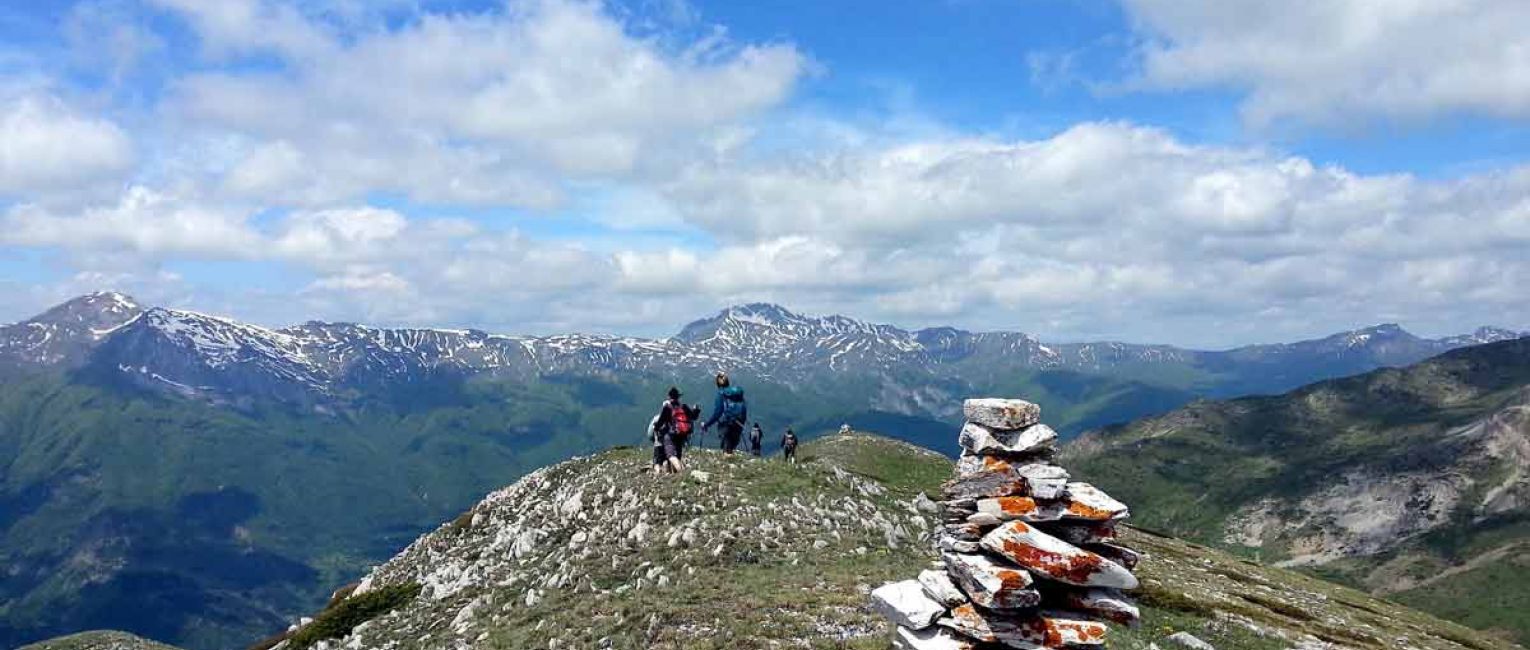
Is Macedonia Worth Visiting?
This hidden gem of the Balkans is a destination well worth visiting. North Macedonia has something special to offer everyone, from adventure travelers looking for outdoor adventure and cultural exploration to those looking to soak up the region's rich history and culture.
North Macedonia, located at the crossroads between the East and West and Christianity and Islam, has long been a melting pot of civilizations. While North Macedonia has many notable similarities to both Greece and Turkey, this emerging Baltic destination retains an unmatched level of authenticity.
It is an incredible place for those who crave adventure that is off the beaten path and less visited by tourists.
Here are my top 10 reasons to visit North Macedonia.
1. North Macedonia Is One Of Europe's Rising Destinations.
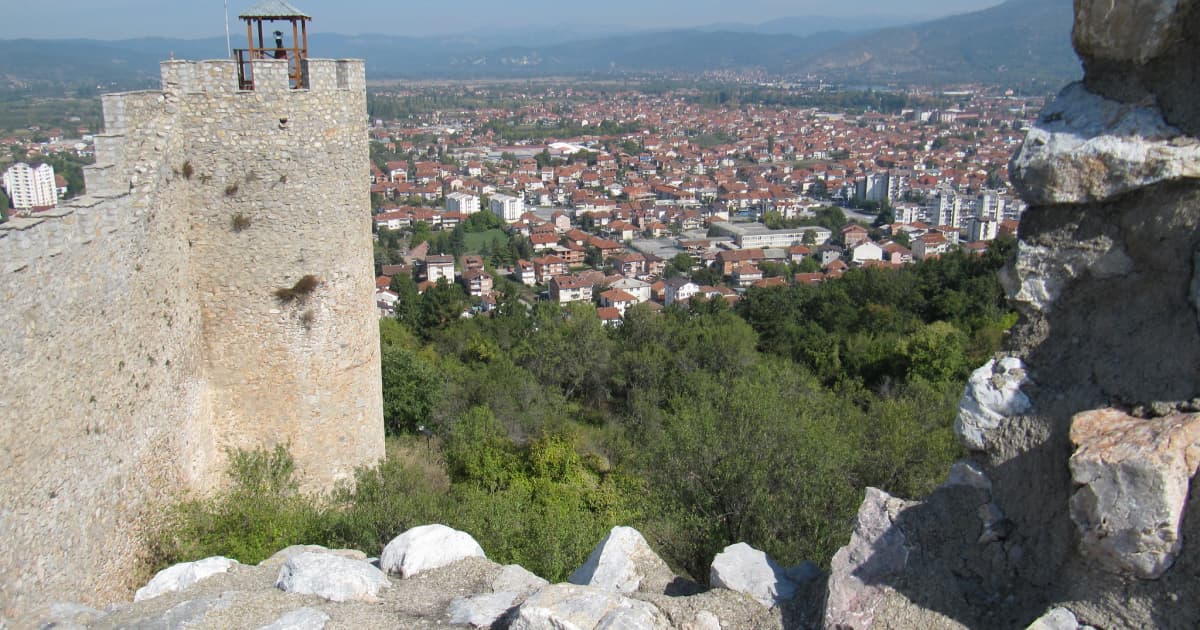
North Macedonia is becoming one of Europe's rising destinations for tourism. In fact, 2021 saw a 50% increase in tourists .
Even still, the country is relatively unexplored and untouched by mass tourism.
There are plenty of days you might go without seeing another tourist, especially when out on some of the remote hiking trails or mountain routes.
Chances are you will have the hiking trails to yourselves, even at peak times.
When I arrived at the International Airport in Skopje, my plane was the only one in sight. That shows how little traffic is arriving by air.
After I visited this country, I definitely understood the tourism potential here.
With overtourism causing travelers to look for “quieter” destinations away from the crowds, smaller destinations like North Macedonia have started to look very attractive for smaller groups.
2. Ancient Culture & Rich History.
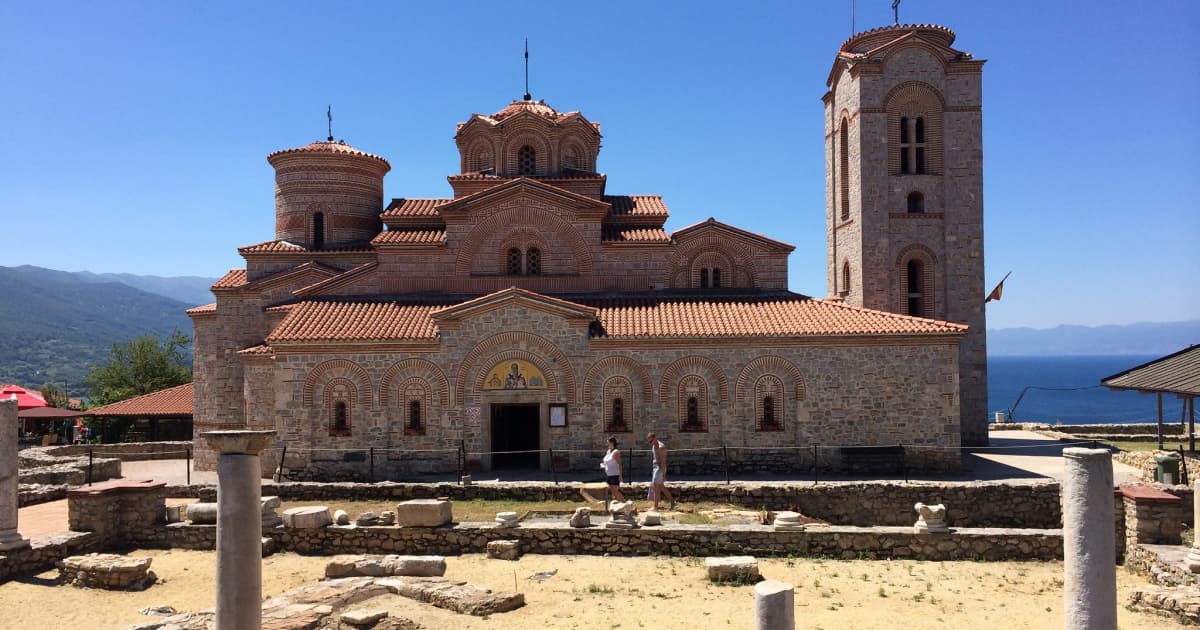
While the great outdoors provides ample opportunity for exploration, North Macedonia also boasts numerous archaeological sites filled with ancient ruins as well as charming cities where you can admire local artisanship or savor the traditional flavors of Macedonian cuisine.
This unique corner of the Balkan Peninsula boasts an eclectic mix of ancient cultures and rich history.
Visitors can explore monuments that have stood for centuries, including medieval castles and grand monasteries.
The North Macedonian culture has been shaped over millennia, from Greek heritage in antiquity to Roman rule during the Middle Ages to Ottoman influence in recent centuries.
And if you're interested in immersing yourself deeper into local culture, North Macedonia has several small villages scattered throughout its countryside that provide an authentic glimpse into rural life in this Balkan nation.
Here, locals will often enthusiastically welcome travelers with open arms, eager to share stories about their homeland over coffee or food at home-style restaurants known as ‘kafana’s'.
For the cultural travelers, no trip is complete without a visit to the old town of Ohrid.
> Old Town Of Ohrid
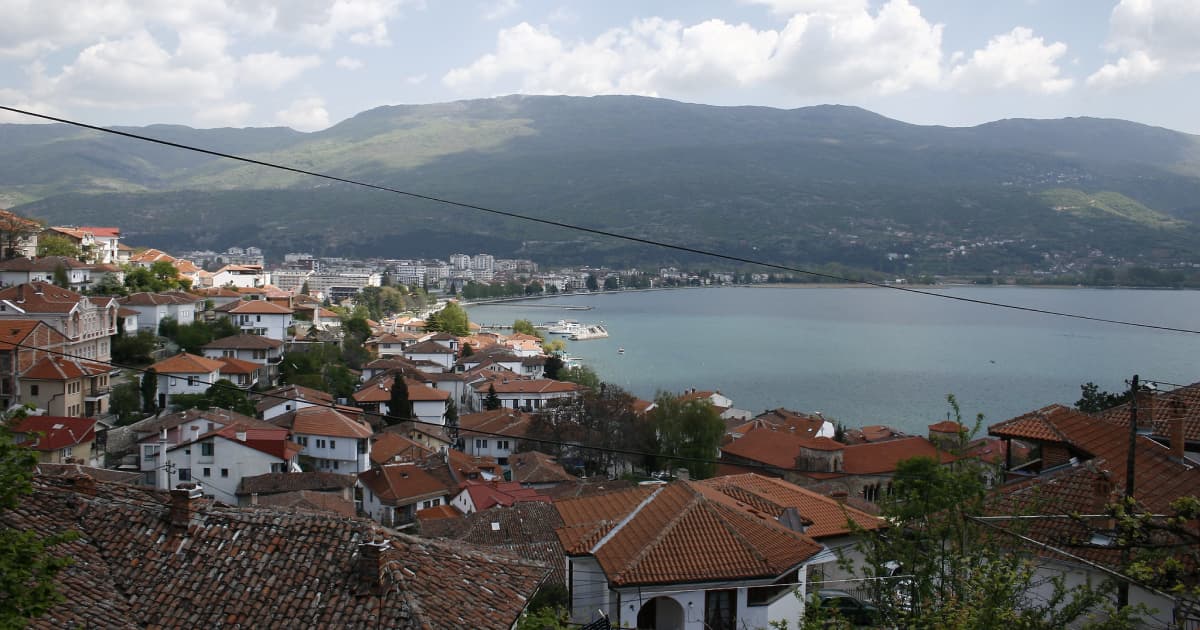
Listed as a UNESCO Heritage Site, the old town of Ohrid is located on the lake of the same name. The town has a beautiful old quarter with cobblestone streets, markets, old city gates, medieval churches, and lively restaurants and bars.
Ohrid is one of the oldest settlements in Europe.
I highly recommend visiting Samuel’s Fortress, perched on a hilltop, for great views of the city and lake.
3. Plenty of Nature
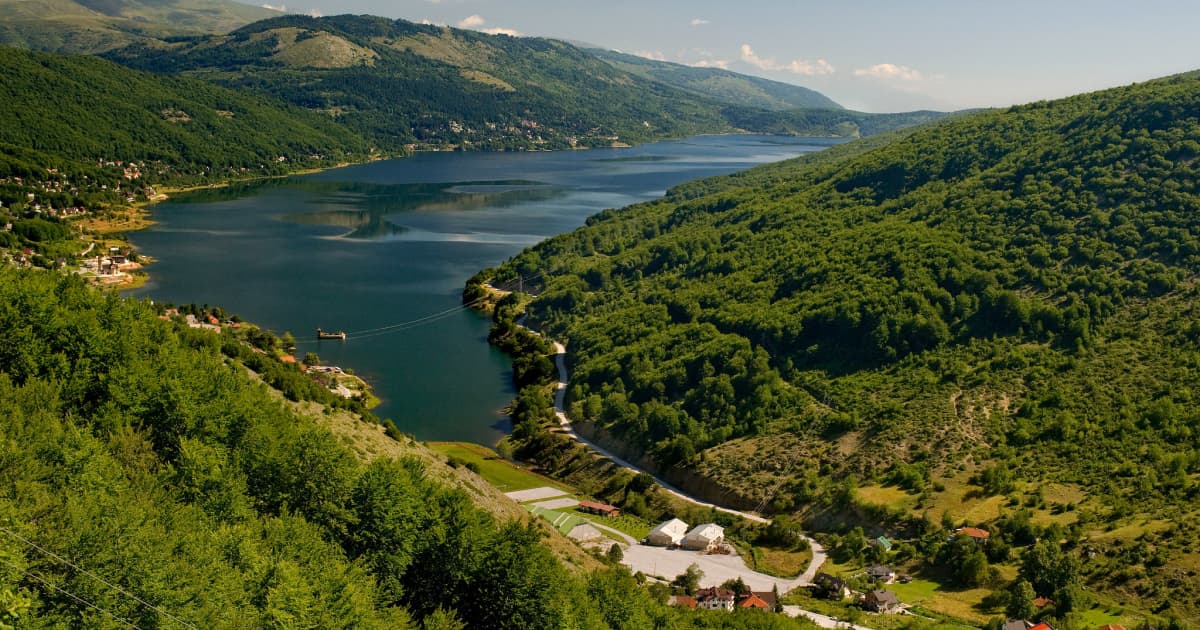
There's plenty of nature to explore in North Macedonia to satisfy any adventure traveler.
From lush mountain forests and crystal clear lakes to stunning coastal views and quaint rural villages.
The abundance of nature and green space in North Macedonia also offers plenty of opportunities for outdoor adventure.
Hike in one of the mountainous national parks, kayak in Matka Canyon & Lake Ohrid, bike through vineyards and past villages with centuries-old village houses, and even ski at one of the country’s many ski resorts.
For those looking to embrace nature in Macedonia, I recommend a visit to Mavrovo National Park.
> Mavrovo National Park
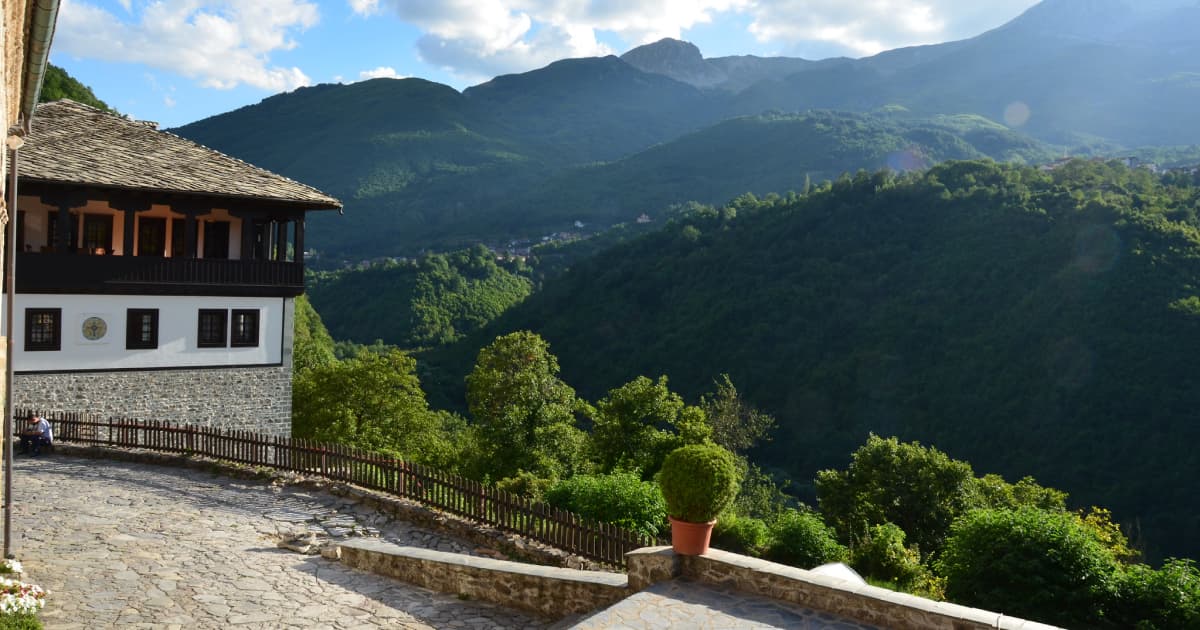
This park is located in the western part of the country and is the largest of the three national parks in North Macedonia.
The park is characterized by mountains, lakes, dense forests, rivers, and canyons and is home to a vast array of wildlife from bears, deer, wolves, and over 100 species of birds.
And most importantly, there are plenty of hiking trails around the park to soak it all in at your leisure, with casual trails and even some longer challenging treks.
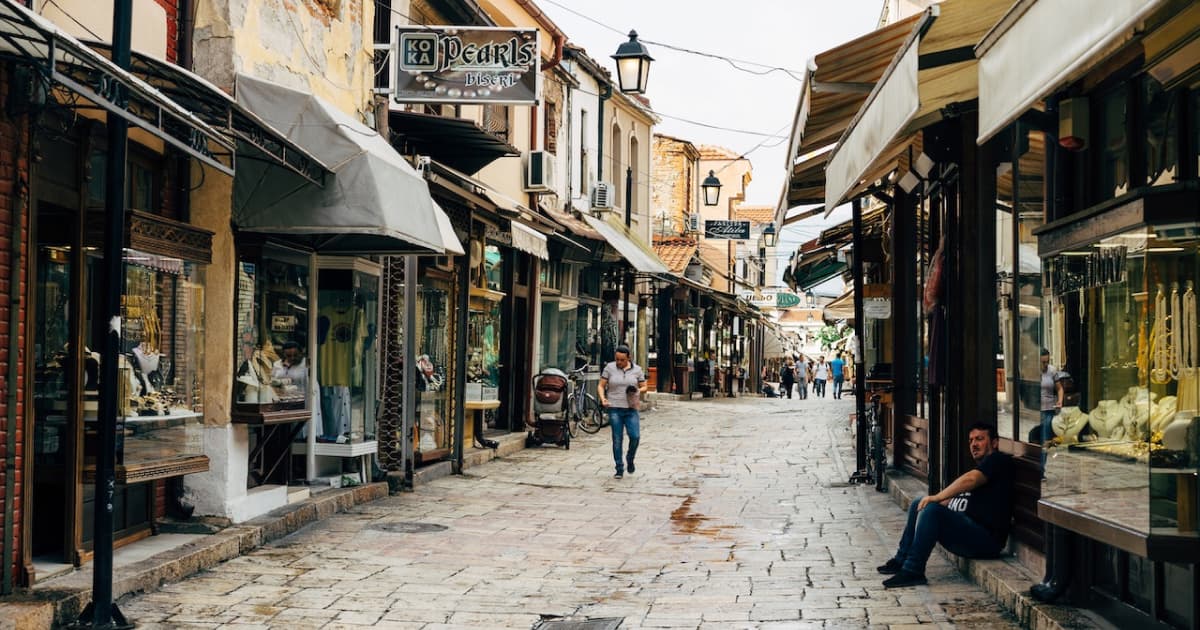
The capital of North Macedonia, Skopje, is well worth visiting on a trip here.
From its stunning scenery, mountain terrain for hiking, and rugged rivers for kayaking, to its vibrant culture and lively nightlife.
For those wanting a more cultural experience, visiting the many historical sites scattered throughout the city provides an opportunity to explore centuries’ worth of history firsthand.
Skopje also provides access to some amazing historical monuments, such as the Stone Bridge and St. Mark’s Church.
Any outdoor enthusiast here will be spoiled with activities, such as trekking across untouched trails or rafting down wild river rapids.
Or, if you're looking for something different from your typical vacation plans, venture into one of Skopje's bustling markets, where vendors sell everything from exotic spices and unique trinkets to handmade crafts that make great souvenirs!
For those looking to soak up the atmosphere, Skopje is a vibrant town with plenty of restaurants highlighting traditional Macedonian cuisine.
5. Adventure Travel.
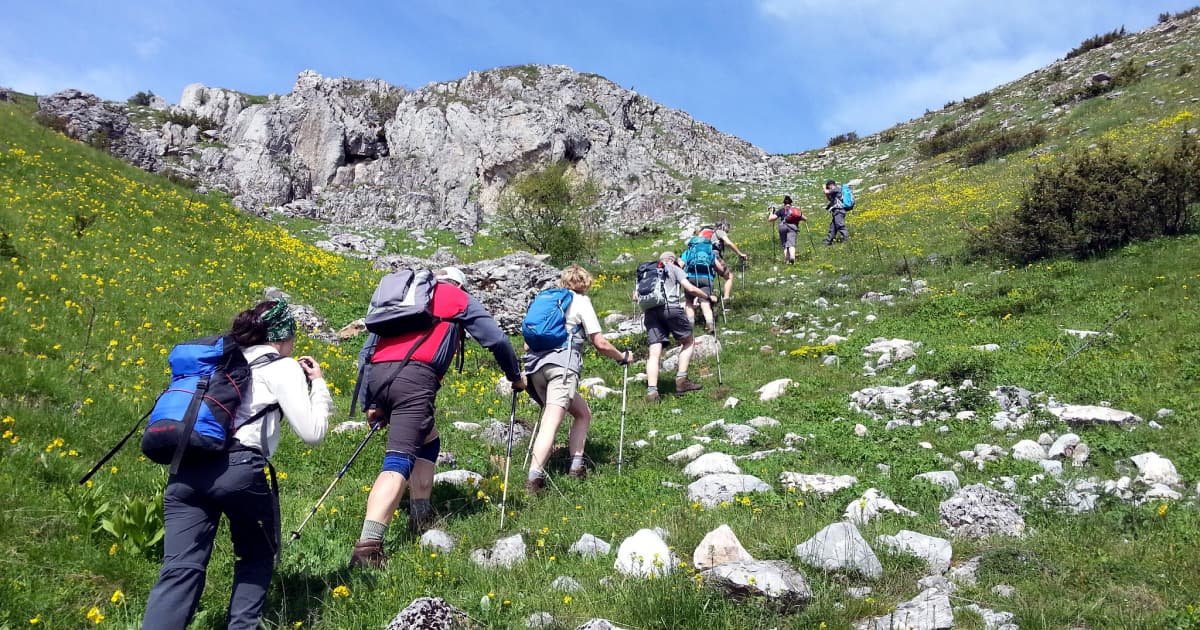
This Balkan nation has a wealth of outdoor activities to bring your wildest travel dreams to life.
For those who are curious about what lies beyond traditional tourist attractions in Europe – North Macedonia should be your first port of call!
North Macedonia is the perfect destination for adventure travelers seeking to explore diverse cultures and experience new thrills.
With stunning landscapes perfect for sightseeing, and, most importantly, an abundance of outdoor activities—from hiking, and mountain biking to rafting—North Macedonia has endless opportunities for adventurers looking to leave the ordinary behind.
From venturing off the beaten path to one of North Macedonia's many quaint towns or discovering ancient ruins scattered across the countryside, there are so many hidden gems that await those who venture beyond their comfort zone.
You can head out on thrilling treks through lush forests that lead up to soaring mountains with breathtaking views around every corner.
Or experience the ultimate thrill by paragliding in the scenic Mavrovo National Park.
Explore ancient ruins around Ohrid, such as St. Naum Monastery or the Bay of Bones Museum.
Or take an opportunity to kayak through gorges and caves around Ohrid instead.
And wintertime offers plenty of skiing on the spectacular mountain ranges like Shar Mountain National Park in the southern part of the country — where you can find breathtaking views from dizzying heights above tree lines.
Our multi-sport Macedonia adventure tour offers biking, hiking, kayaking, and more across an 8-day adventure trip.
Here are some of our adventure travel highlights across North Macedonia.
> Biking North Macedonia.
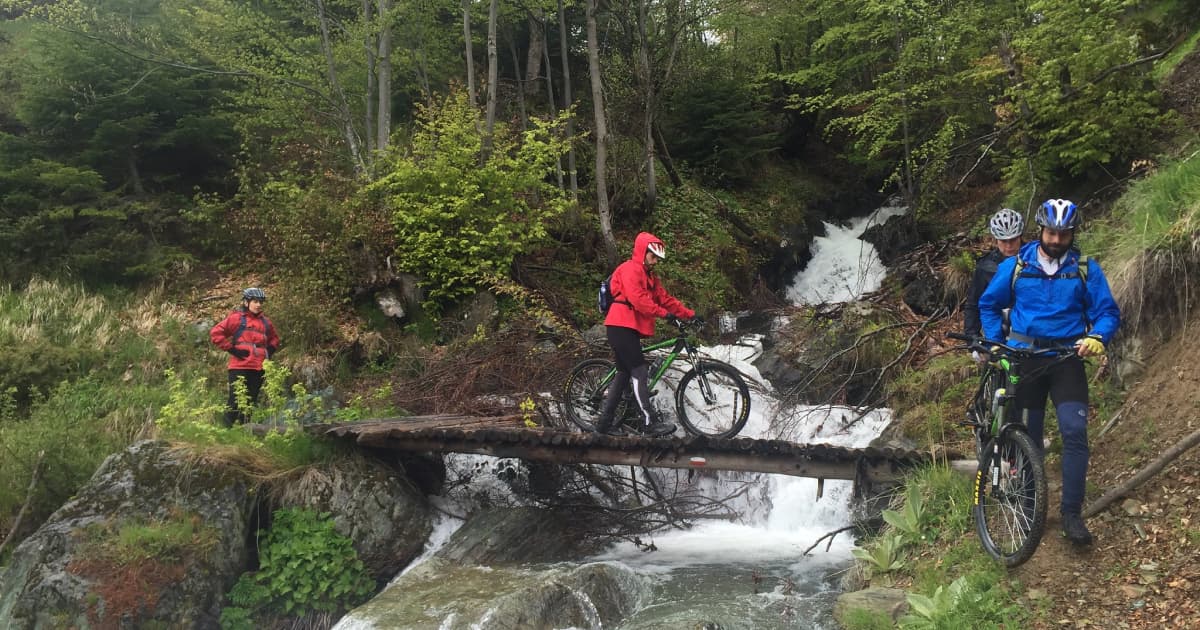
At every turn, bikers can discover beautiful traditional villages steeped in rich cultural heritage waiting to be explored during their journey through North Macedonia's countryside .
These villages offer up colorful folk customs as well as authentic farm to table cuisine that won't be found anywhere else in Europe!
The scenic views from atop the mountain trails are unparalleled with amazing panoramic views.
Experienced cyclists can even take on some steeper climbs for even more incredible views across vast open plains below them.
Here you can find some of the top cycling routes across North Macedonia to help you plan ahead.
> Hiking North Macedonia
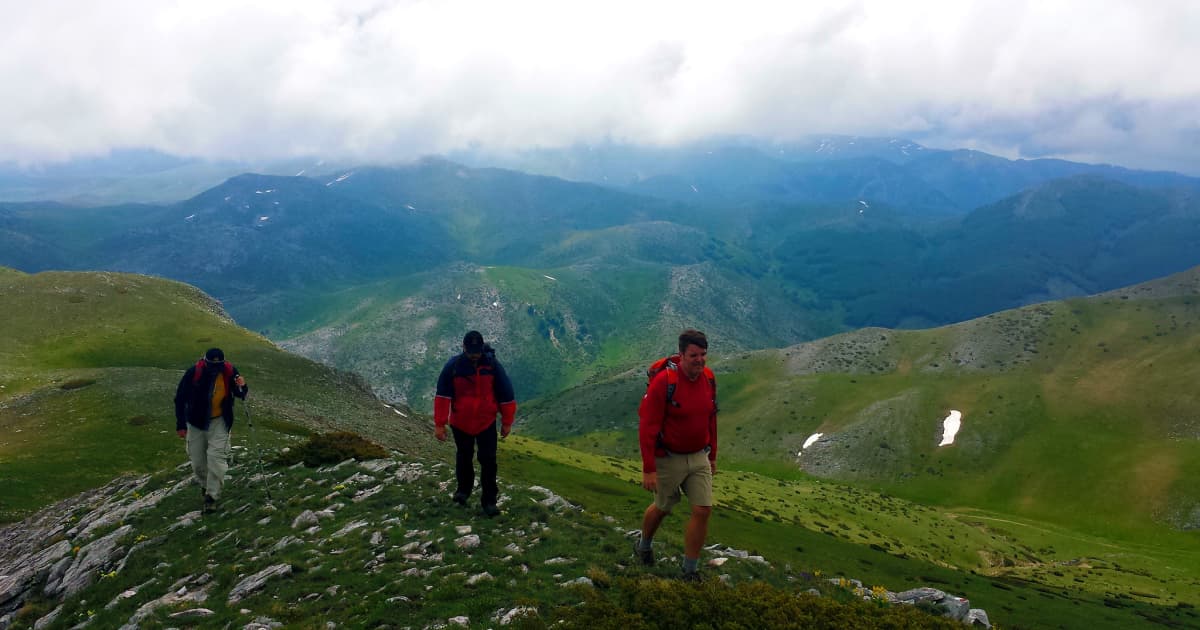
The abundance of hiking trails makes North Macedonia an ideal spot for a hiking holiday.
From the rugged Matka Canyon to Galicica National Park, there are plenty of opportunities to explore some beautiful terrain.
Alongside these stunning vistas, you can also immerse yourself in local cultural sites found across many of the hiking trails here.
So if you’re eager to embark on a journey through unfamiliar lands, then hiking North Macedonia should certainly be top priority!
The hiking trails here are full of surprises around every corner!
If you're looking for some trail inspiration you can find our favorite hikes in North Macedonia .
> Kayaking North Macedonia.
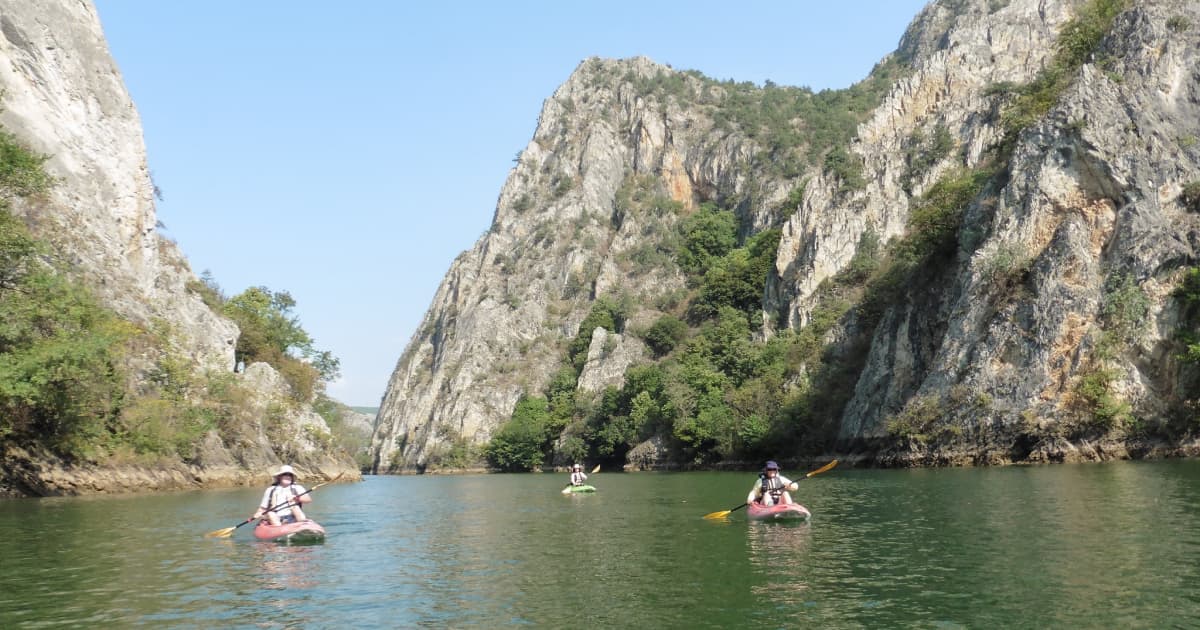
Here, kayakers of all skill levels, from beginner to expert, can find a challenge or an easy paddle.
North Macedonia's natural beauty offers some breathtaking scenery while out kayaking.
Here are my 3 favorite kayaking spots:
> Vardar River: The Vardar is a longer, more leisurely trip that is suitable for beginners and intermediate paddlers. It passes through the city of Skopje and offers a chance to see some of North Macedonia's cultural and historical sites.
> Crna Reka: This river is known for its clear, clean water and is a great option for some easy kayaking. The Crna Reka is also surrounded by picturesque forests and mountains.
> Mavrovo Lake: This large, beautiful lake in the Mavrovo National Park is a great place for beginner kayakers to practice their skills. The lake is surrounded by forests and mountains, making it a great destination for a relaxing day on the water.
6. Arts & Culture.
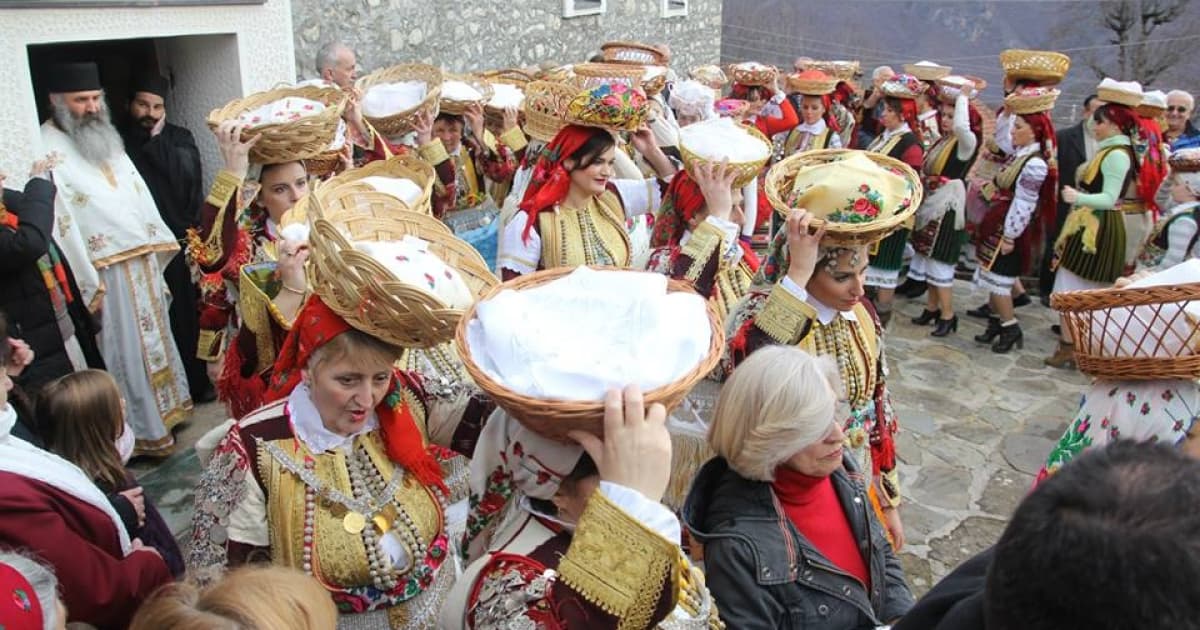
North Macedonia has an incredibly vibrant arts and culture scene.
The country's history is evident in its diverse architecture, from ancient Greek monuments like Stobi and Heraclea Lyncestis to Ottoman-era mosques such as the Mustafa Pasa Mosque of Bitola.
Visitors can explore centuries-old ruins at places like Samuilova Krepost or take a walk through Skopje’s Old Bazaar district, where local artisans showcase their crafts.
There are also many unique cultural celebrations to experience.
Annual events such as Kuker Festivals take place throughout the year, where locals dress up wearing masks depicting mythical creatures while performing traditional dances around bonfires accompanied by drums and other musical instruments made from animal skin or woodwinds crafted out of birch trees!
Art galleries featuring contemporary works also dot cities across North Macedonia.
7. Farm To Table Food.
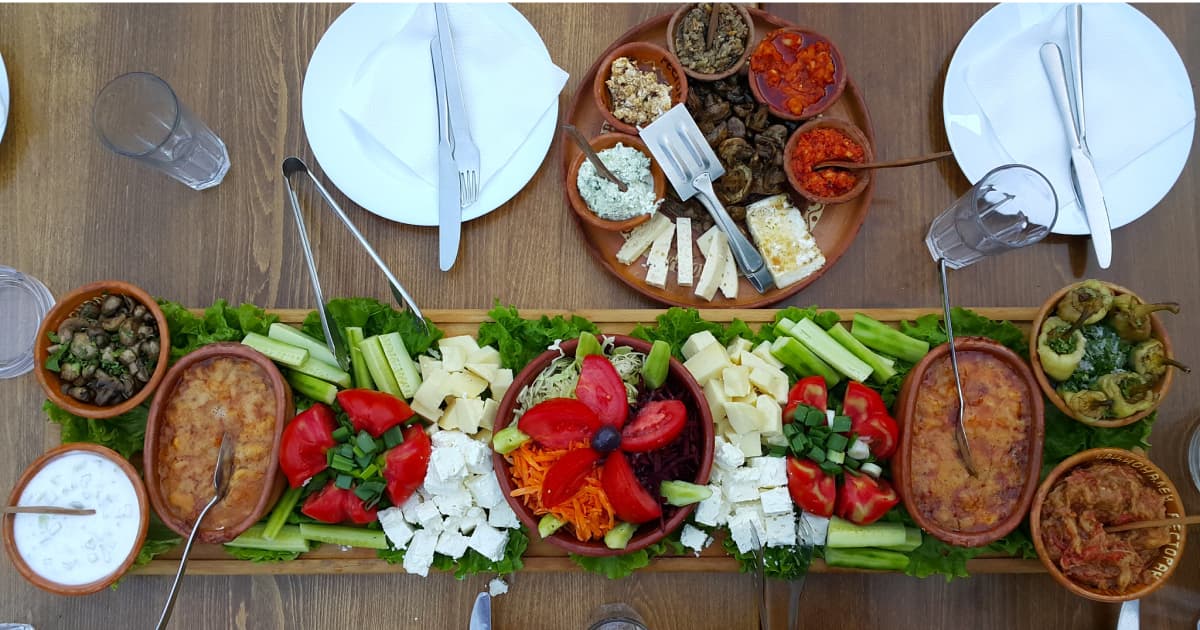
North Macedonia offers a unique farm to table dining experience, making it a worthwhile visit for anyone seeking an authentic culinary journey.
Some of the best cuisine I have had in my life was in North Macedonia.
Every single meal was so delicious and varied that it was hard to stop eating. The bread, the meat, the cheese, the vegetables…all so good.
North Macedonia boasts incredible cuisine that is not only flavorful and fresh but steeped in centuries’ worth of cultural heritage.
There are plenty of bustling open markets full of locally grown produce and exotic spices to explore.
You can even opt for a more intimate cooking class with a local guide and learn how to prepare regional dishes, many made using time-honored techniques passed down through generations.
North Macedonia's farm-to-table culture is reason alone to discover this amazing country: its gastronomy is truly second to none!
8. Exquisite Wines.
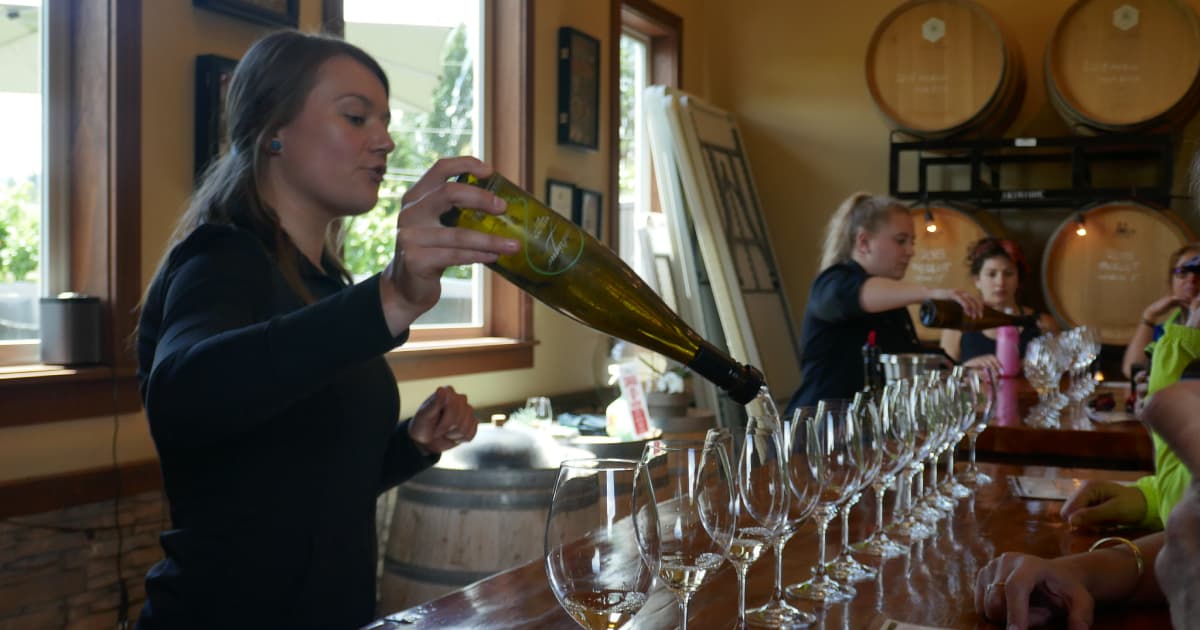
Not just one for the foodies, the wine in North Macedonia is also absolutely incredible.
Before I visited North Macedonia, I had no idea how good the wine would be, especially red wine. The wine here can rival that of other European countries such as France and Italy and is very affordable.
There are quite a few wineries scattered throughout the country, and the most well-known wine region is Tikvesh. This region has been producing wine since the 4th century BC.
From full-bodied reds to crisp whites and rosés, North Macedonia has an array of exquisite wines on offer, from traditional regional blends to something more daring such as late-harvest varieties made with local grapes.
What's more, there are plenty of opportunities for wine tasting and wine tours across North Macedonia.
We can definitely see tourists flocking here in search of their new favorite vintage!
The people of Macedonia are warm and welcoming, eagerly sharing their cultural heritage and inviting visitors to experience it firsthand.
Several times I found myself chatting with locals about their history, culture, and love of food and wine.
10. Affordability.
North Macedonia is quite a budget-friendly destination and has great value for the money you will spend.
You can easily eat three-course meals and enjoy a bottle of wine every night without breaking the bank.
The hotels are also reasonably priced for the services you receive and your travel budget will definitely stretch a lot longer in Macedonia compared to other European countries.
This Balkan nation may be one of Europe's least expensive countries I've visited; however, it doesn't skimp on quality or adventure.
When Is the Best Time to Visit North Macedonia?
I find the best time to visit North Macedonia is from mid-May to the end of September .
> May - September , temperatures remain mild and dry, which is perfect for exploring the outdoors.
There are also a handful of festivals held during these months that highlights traditional art forms like music and dance performances, as well as local food festivals — giving visitors a chance to really experience authentic Macedonian culture.
The winter months in North Macedonia are from December to March.
> December to March it can get pretty wet, and it tends to rain a lot. However, there are plenty of skiing opportunities throughout the off-season, when many of the mountain ranges are covered with snow through winter.
Join Us On A North Macedonia Adventure.
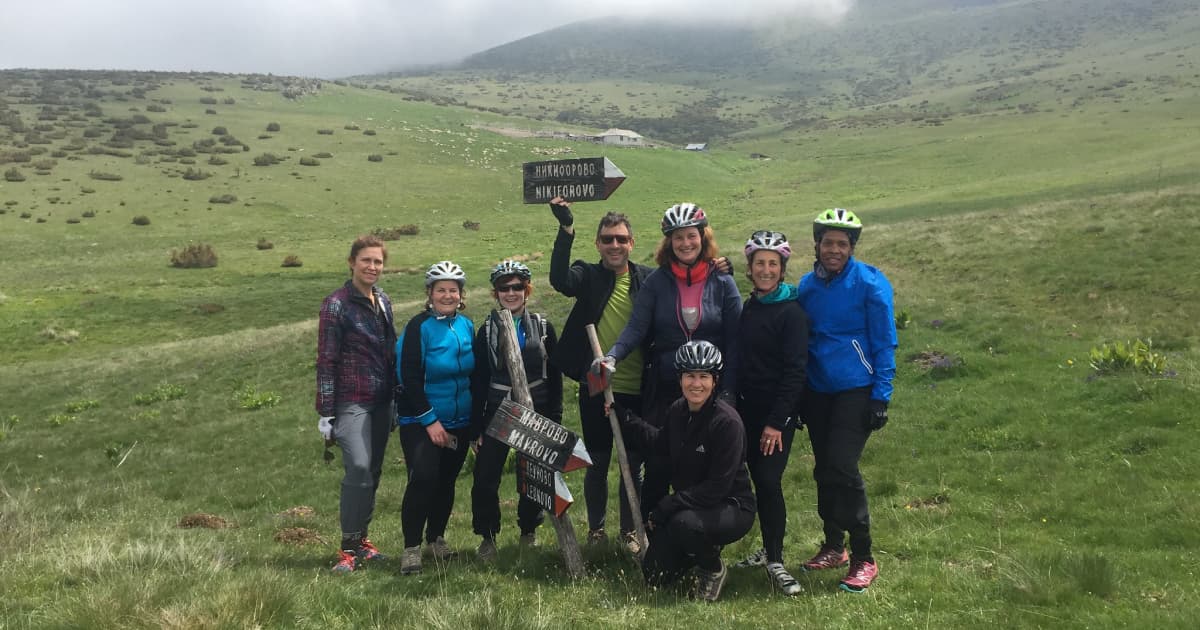
If this post has inspired or tempted you to plan a vacation to North Macedonia, you can experience all of this and more on our Macedonia adventure trip .
Check out our Multi-sport Through the Balkans 8-day Tour for more details.
We'll leave you with a little taste of North Macedonia travel from a custom trip we put together based on our multi-sport through the Balkans tour.
If you have any questions about North Macedonia or anything else we mentioned in this article, get in touch anytime , we're always happy to talk travel!
Happy Travels, Trish Sare
About The Author

- Adventure Travel

North Macedonia
Part Balkan, part Mediterranean and rich in Greek, Roman and Ottoman heritage, North Macedonia has a fascinating past and a complex national identity.
Attractions
Must-see attractions.
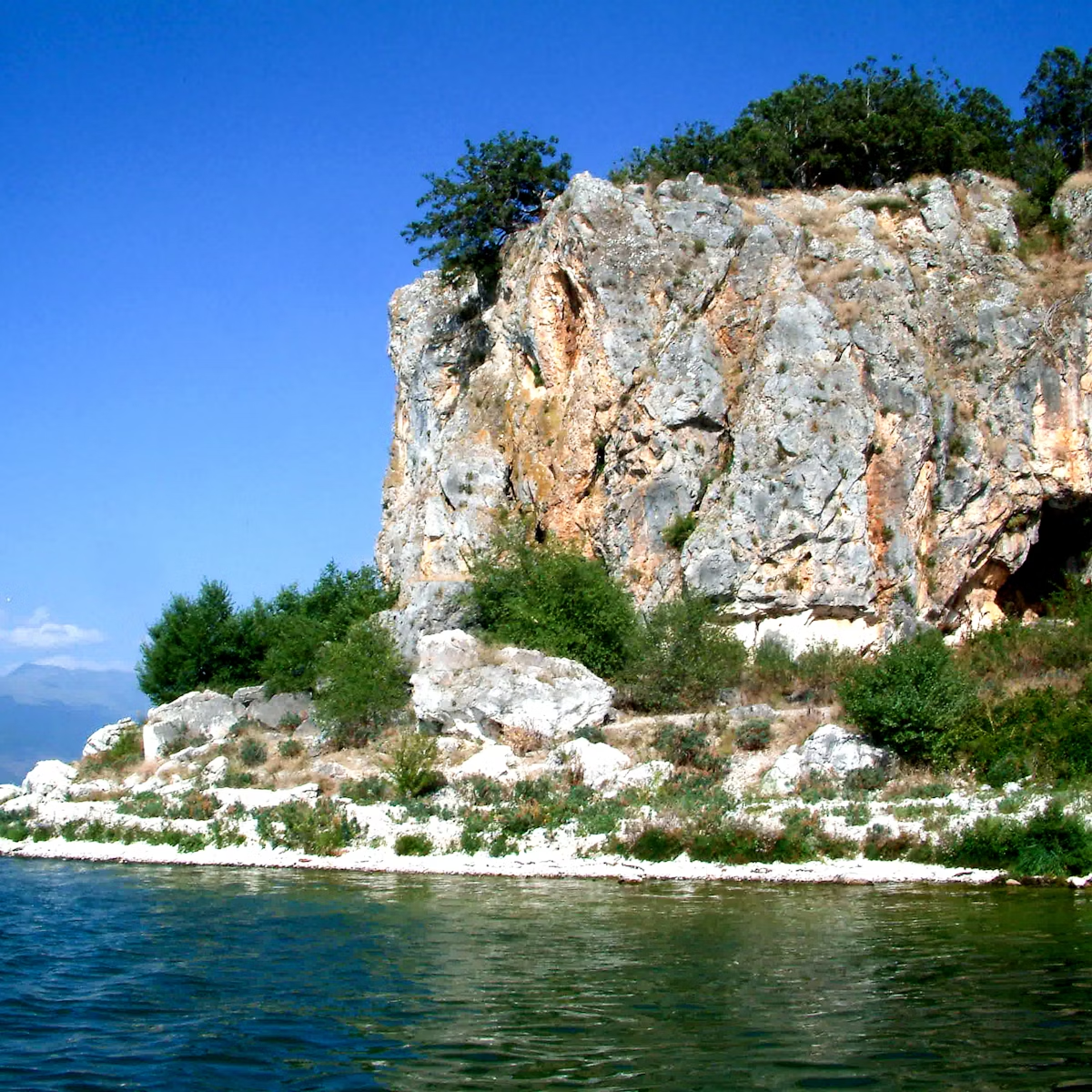
Adrift on Lake Prespa, Golem Grad was once the king's summer playground but is now home to wild tortoises, cormorants and pelicans, and perhaps a few…
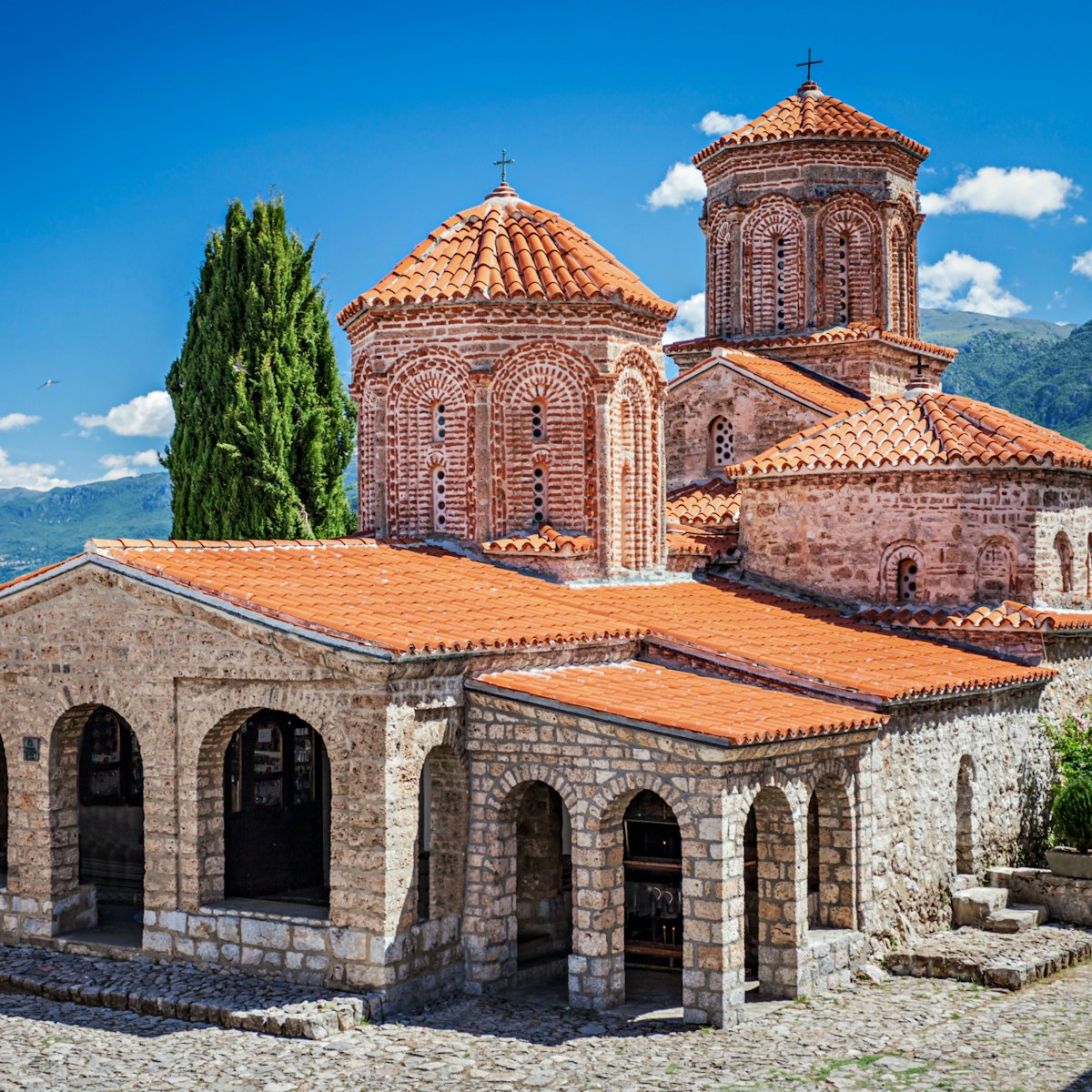
Sveti Naum Monastery
Sveti Naum, 29km south of Ohrid, is an imposing sight on a bluff near the Albanian border and a popular day trip from Ohrid. Naum was a contemporary of St…

Ilinden Uprising Monument
This 1974 monument, commemorating the Ilinden Uprising from 1903, is a marvel of Yugoslav architecture and a fantastic example of abstract historic…

Sveti Jovan Bigorski Monastery
Mavrovo National Park
This revered 1020 Byzantine monastery is located, fittingly, up in the gods along a track of switchbacks off the Debar road, close to Janče village…

Kokino Observatory
A Bronze Age, archaeo-astronomical site, this megalithic observatory sits atop a volcanic hill, at an elevation of 1013m; it's a truly marvellous place…

Treskavec Monastery
The 13th-century Treskavec Monastery rises from Mt Zlato (1422m), a bare massif replete with imposing twisted rock formations. One doesn't know which is…

Burial Mound of the Unbeaten
This magnificent monument to Prilep's Partisan soldiers who died in WWII is the 1961 work of one of the former Yugoslavia's most brilliant architects,…

Ohrid Boardwalk & City Beach
Skimming the surface of the water along Ohrid's shore, snaking towards Kaneo fishing village and the town's most famous church, this over-water boardwalk…
Latest stories from North Macedonia
Filter by interest:
- All Interests
- Adventure Travel
- Art & Culture
- Beaches, Coasts & Islands
- Food & Drink

Architecture
Sep 5, 2019 • 6 min read
With its diverse metropolis capital, historic and protected lakes, hiking trails, national parks and ancient, old-world culture, North Macedonia is a true gem…

Feb 10, 2019 • 4 min read

Feb 10, 2019 • 5 min read

Sep 19, 2018 • 1 min read

Jun 15, 2018 • 5 min read
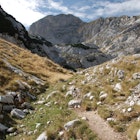
Jul 16, 2016 • 6 min read
in partnership with getyourguide
Book popular activities in North Macedonia
North macedonia and beyond.

Wander-Lush
Visit Macedonia: The Ultimate North Macedonia Travel Guide
- Europe / The Balkans
We watched the people and old carriages go past, we gazed at the colours of the great bazaar and the eternal flow of the river. But no matter where we stood, it was the large square that drew our attention. Here was where history most frequently stopped off or passed by. Here in this square the first occupying forces halted, liberators announced their victory, mighty workers paraded, and important rallies were held. Luan Starova, The Time of the Goats
The Country Formerly Known As
The Republic of North Macedonia, formerly known as the Former Yugoslav Republic of Macedonia, was tussling for autonomy long before the Balkan Peninsula got carved up into its latest iteration. The history of this tiny nation reaches all the way back to the time of Alexander the Great. Perhaps it’s there you can find the roots of the fiery Macedonian spirit that has bore this country through hard times, from city-shattering earthquakes to political turmoil.
Built on the fault lines of a fragile independence, North Macedonia celebrates its cultural identity and religion with a special kind of ferocity. Still, after spending a couple of weeks in the country, I think I came away with more questions than answers.
It’s worth visiting just to experience Skopje , the kookiest capital in Europe. Split by the Vardar River, one side of the city is a highly stylised outdoor museum of statues, colonnades, manicured gardens and squares. The other bank is the total opposite – a maze of bowed streets and shadowy shops that make up the Skopje Old Bazaar (the second-largest in the region after Istanbul). The Ottoman influence is everywhere, from the food to the hamams that have been turned into contemporary art spaces. Just outside Skopje, the painted mosque in Tetovo is the most beautiful in all of the Balkans.
In the centre of the country, North Macedonia’s jewel, Lake Ohrid , sparkles. Cruise to the St. Naum Monastery near the border with Albania or hire a bicycle and circumnavigate the entire lake in a day, passing through the two border crossings. Soak up the green glory of Mavrovo National Park and Matka Canyon , a popular day trip from the capital, or hike Baba Mountain in the south. Navigate the steep streets of my favourite town in North Macedonia, Krusevo , and in Bitola , see the Roman amphitheatre and incredible mosaics at the Heraclea Lyncestis archaeological complex.
Save room for North Macedonia’s wine scene . Stobi, Tikves and Popova Kula are the country’s most prominent wineries and must-visits for fans of vino.

North Macedonia travel essentials
Please note: Some of these links are affiliate links, meaning I may earn a commission if you make a purchase by clicking a link (at no extra cost to you). Learn more .
Late April/May (spring, flowers and cooler temps); August-September (fall wine season); winter for skiing.
How long in Macedonia?
Allow 1 full day for Skopje; 5-7 days for the highlights; 10-14 days to see (almost) everything.
Daily budget
Approx. 50 USD per person per day (mid-range hotel; restaurant meals; bus fares; museum tickets).
Getting there
Fly into Skopje; train from Belgrade; taxi from Greece; drive/bus from other neighbouring countries.
Macedonia visa
Visa-free for most passports (stay up to 90 days).
Getting around
Hire a car; use intercity buses/minibuses or trains.
Where to stay
Hostels, family-run guesthouses or hotels.
Tours & experiences
Old bazaars, painted mosques and boat tours on the lake.
Explore North Macedonia
Discover all the best things to do in North Macedonia with my latest travel guides.
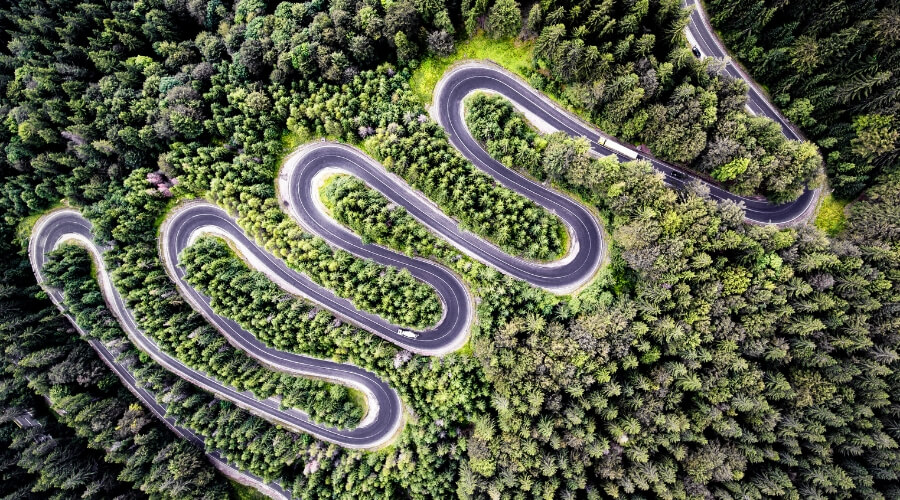
Where to Go on a Balkan Road Trip: 20 Epic Self-Drive Itineraries
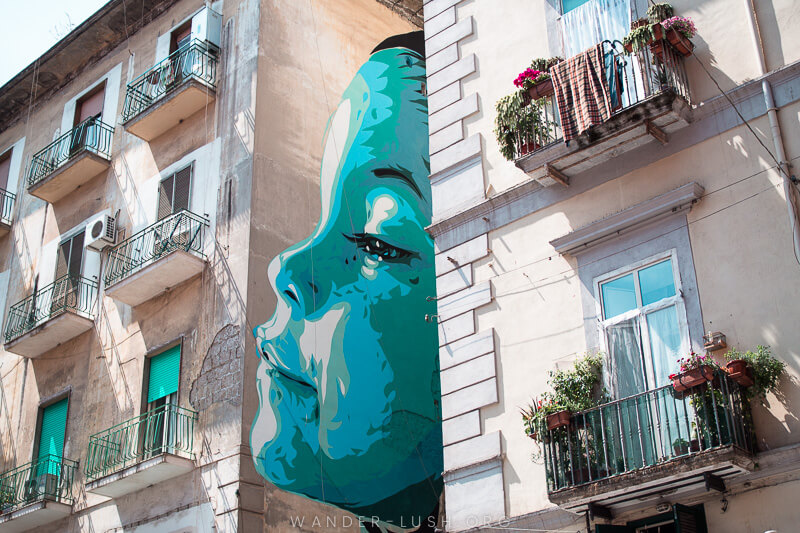
25 Offbeat & Alternative European City Breaks
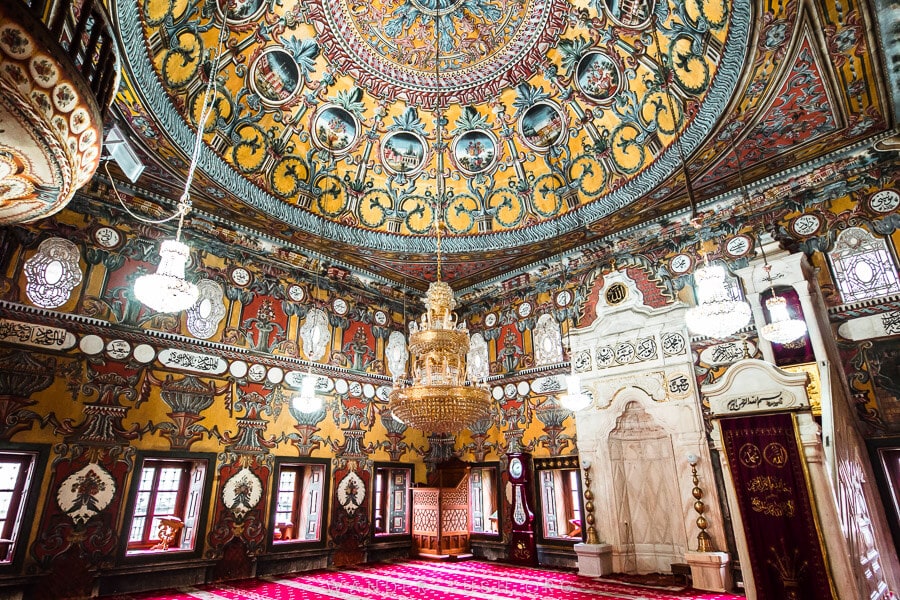
Tetovo Painted Mosque: Full Guide to the Best Skopje Day Trip

Lakes, Spomeniks & Old Bazaars: The Perfect North Macedonia Itinerary (7-10 Days)

21 Things to Do in Skopje: A Curated Guide to Europe’s Quirkiest Capital City

12 Things to Do in Bitola, North Macedonia’s City of Consuls
My north macedonia favourites, best hiking.
Trail to Bogdevo in Mavrovo National Park.
Must-eat meal
Tavče Gravče (beans in a clay pot) with Chateau Sopot.
local experience
Meeting the craftspeople inside Skopje Old Bazaar.
best souvenir
A pair of handmade leather Opanki folk shoes.
Cookies on GOV.UK
We use some essential cookies to make this website work.
We’d like to set additional cookies to understand how you use GOV.UK, remember your settings and improve government services.
We also use cookies set by other sites to help us deliver content from their services.
You have accepted additional cookies. You can change your cookie settings at any time.
You have rejected additional cookies. You can change your cookie settings at any time.
North Macedonia
Warnings and insurance, before you travel.
No travel can be guaranteed safe. Read all the advice in this guide. You may also find it helpful to:
- see general advice for women travellers
- read our guide on disability and travel abroad
- see general advice for LGBT+ travellers
- read about safety for solo and independent travel
- see advice on volunteering and adventure travel abroad
Travel insurance
If you choose to travel, research your destinations and get appropriate travel insurance . Insurance should cover your itinerary, planned activities and expenses in an emergency.
About FCDO travel advice
The Foreign, Commonwealth & Development Office ( FCDO ) provides advice about risks of travel to help you make informed decisions. Find out more about FCDO travel advice .
Follow and contact FCDO travel on Twitter , Facebook and Instagram . You can also sign up to get email notifications when this advice is updated.
Related content
Is this page useful.
- Yes this page is useful
- No this page is not useful
Help us improve GOV.UK
Don’t include personal or financial information like your National Insurance number or credit card details.
To help us improve GOV.UK, we’d like to know more about your visit today. Please fill in this survey (opens in a new tab) .
North Macedonia
The perfect 3 days itinerary.
North Macedonia is a country in Southeast Europe, known for its rich history, stunning landscapes, and vibrant culture. The capital city, Skopje, is famous for its historic monuments, bustling markets, and modern architecture. The country is also home to the beautiful Lake Ohrid , a UNESCO World Heritage site, and the picturesque town of Bitola . From ancient ruins to breathtaking natural beauty, North Macedonia offers a diverse range of experiences for travelers.
What to do in North Macedonia?
This 3 days itinerary is the perfect guide to the best things to see in North Macedonia. It includes day-by-day activities, travel tips, and the top places to visit.
Day 1: Exploring Skopje
Start your day with a visit to the Skopje Fortress , also known as Kale Fortress. Enjoy panoramic views of the city and explore the historic ruins. Next, head to the Old Bazaar , one of the largest and most well-preserved marketplaces in the Balkans. Wander through the narrow streets and discover traditional shops, cafes, and mosques.
Visit the Memorial House of Mother Teresa , dedicated to the life and work of the Nobel Peace Prize laureate who was born in Skopje. Then, take a stroll along the Stone Bridge , an iconic symbol of the city that connects the old and new parts of Skopje.
End your day with a visit to Macedonia Square , the main square of Skopje. Admire the grand statues and fountains, and enjoy dinner at one of the nearby restaurants.
Day 2: Day Trip to Lake Ohrid
Take a scenic drive to Lake Ohrid , one of the oldest and deepest lakes in Europe. Start your visit with a boat tour of the lake, offering stunning views of the surrounding mountains and historic sites.
Explore the town of Ohrid, known for its beautiful churches and monasteries. Visit the Church of St. John at Kaneo , perched on a cliff overlooking the lake, and the Ohrid Fortress for panoramic views of the area.
Enjoy a leisurely walk along the lake promenade and dine at a lakeside restaurant, savoring local Macedonian cuisine.
Day 3: Discovering Bitola
Drive to the town of Bitola , known for its historic architecture and vibrant cultural scene. Start your visit with a walk along Shirok Sokak , the main pedestrian street lined with cafes, shops, and beautiful buildings.
Visit the ancient city of Heraclea Lyncestis , an archaeological site featuring well-preserved ruins from the Hellenistic and Roman periods. Explore the Roman theater, basilicas, and intricate mosaics.
Return to Bitola and enjoy dinner at a local restaurant, experiencing the town's lively atmosphere and hospitality.
Was this helpful?
22 Things You Should Know Before Visiting North Macedonia
If you’re considering going to Macedonia, then you’re in for a great vacation! Macedonia is a landlocked country in the Balkan peninsula. It is covered with mountains , lakes, and has plenty of ancient towns with Ottoman and European architecture.
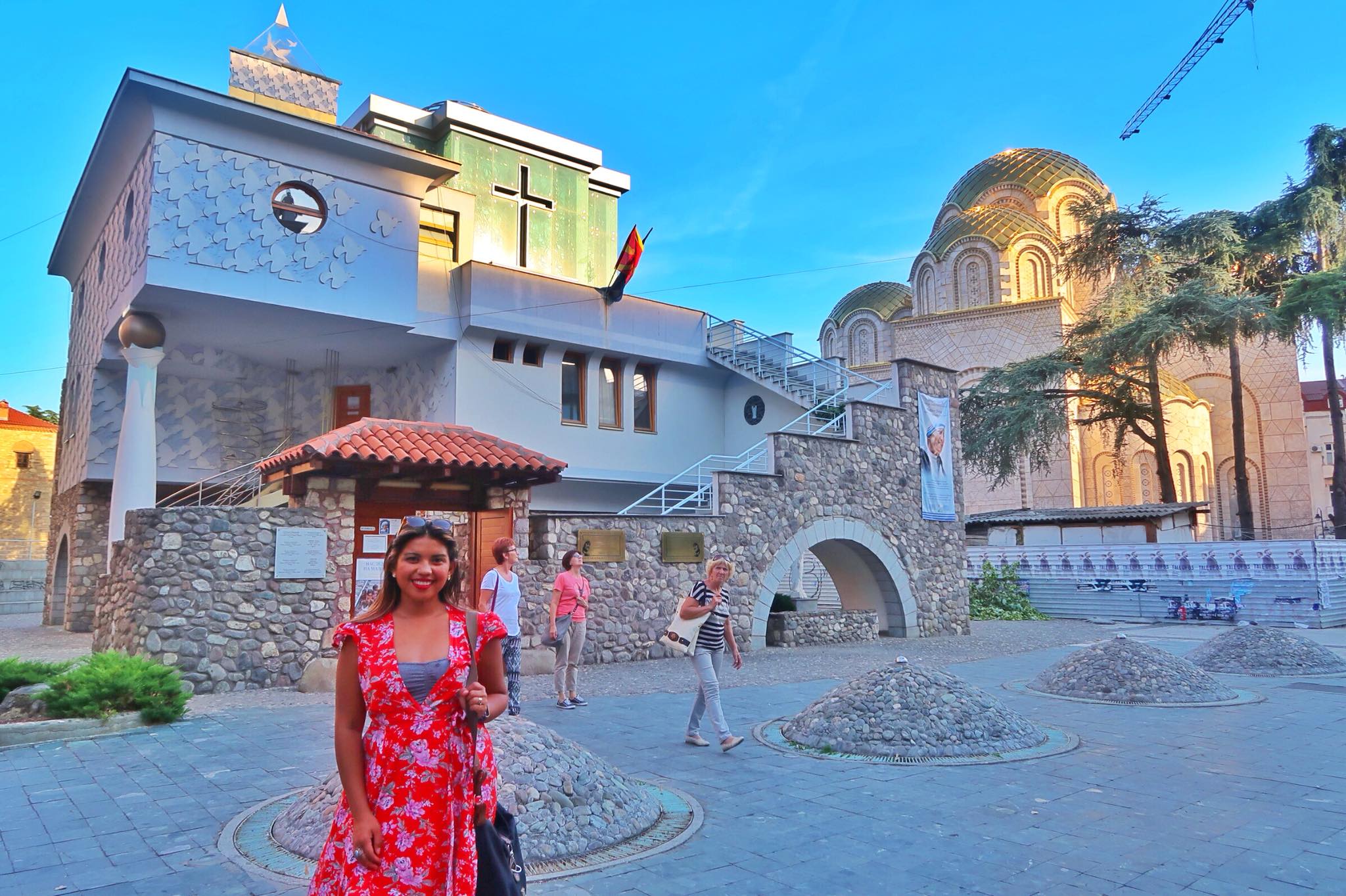
- A Short Travel Guide For Skopje, Macedonia And Our Stay At Skopje Apartments
- My 4-Day Itinerary Visiting Skopje, Macedonia & a Day Trip to Pristina, Kosovo
- Your Golden Ticket to Traveling in Europe: All you Need to Know about Schengen Visas
- How to Apply For A Montenegro Tourist Visa with Your Philippines Passport
- 7 Days Balkan Itinerary : Guide on How to Visit Croatia, Montenegro and Bosnia & Herzegovina
North Macedonia’s capital Skopje is popular for its historic buildings that are now museums. With the country’s rich historical past, one can learn a lot from it. But do you know other information about Macedonia? If not, then we made an article just for you! Here, you’ll be able to learn more facts about North Macedonia . These facts would help you know information about it and will get you more interested in visiting this Balkan country.
1. Macedonia was a part of Yugoslavia from 1918 until 1991. The good thing was when it got its independence, no blood was shed.
2. because of the dispute with greece, macedonia was known as the former yugoslav republic of macedonia, or fyrom for short. but after the dispute, the country changed its official name to ‘north macedonia’. , 3. mother teresa was born in skopje, north macedonia. .
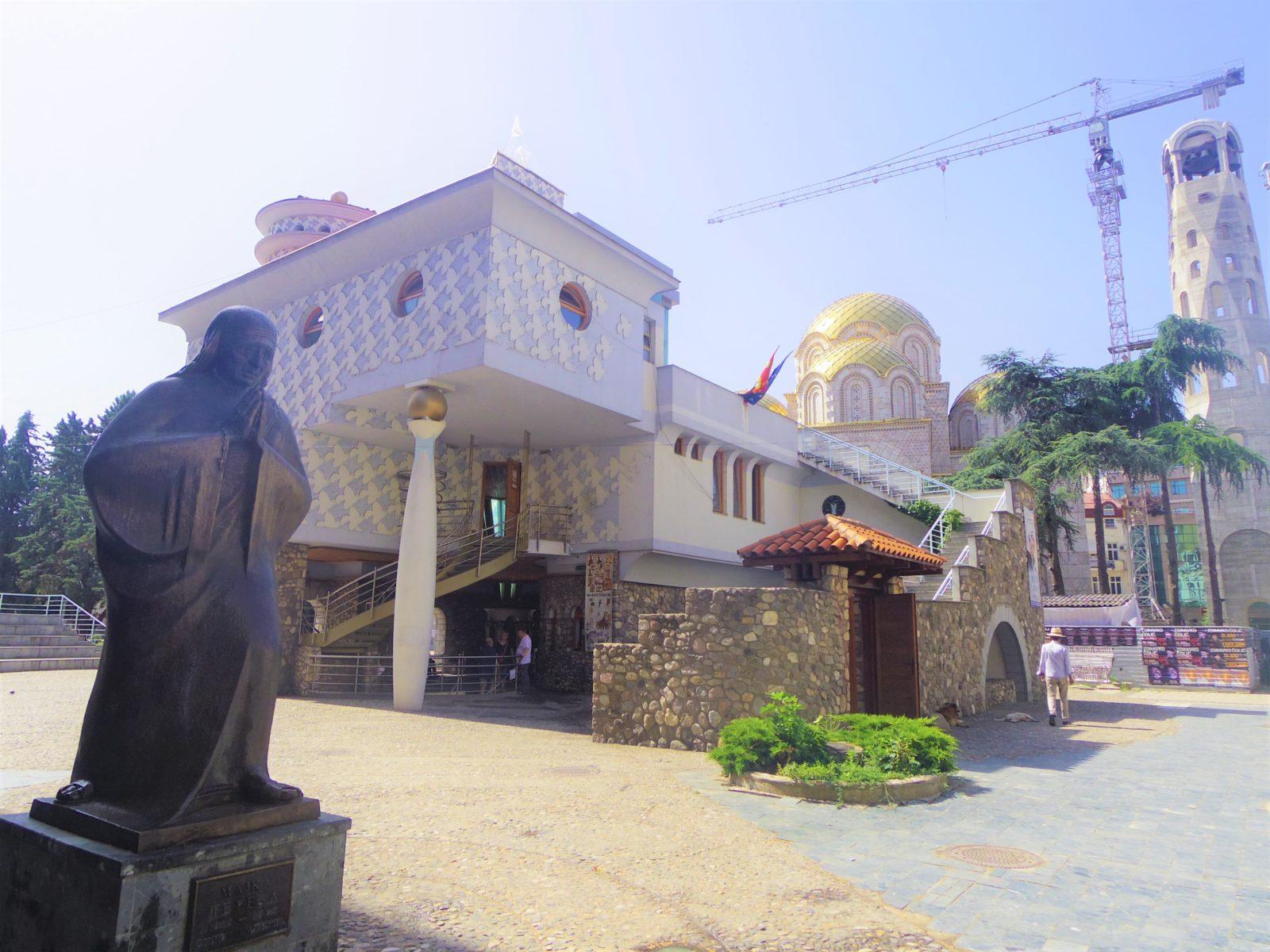
4. The biggest cross in Europe can be found in Macedonia. It is located on Mount Vodno, Skopje. It measures 66 meters tall and it was built to celebrate the 2,000 years of Christianity.
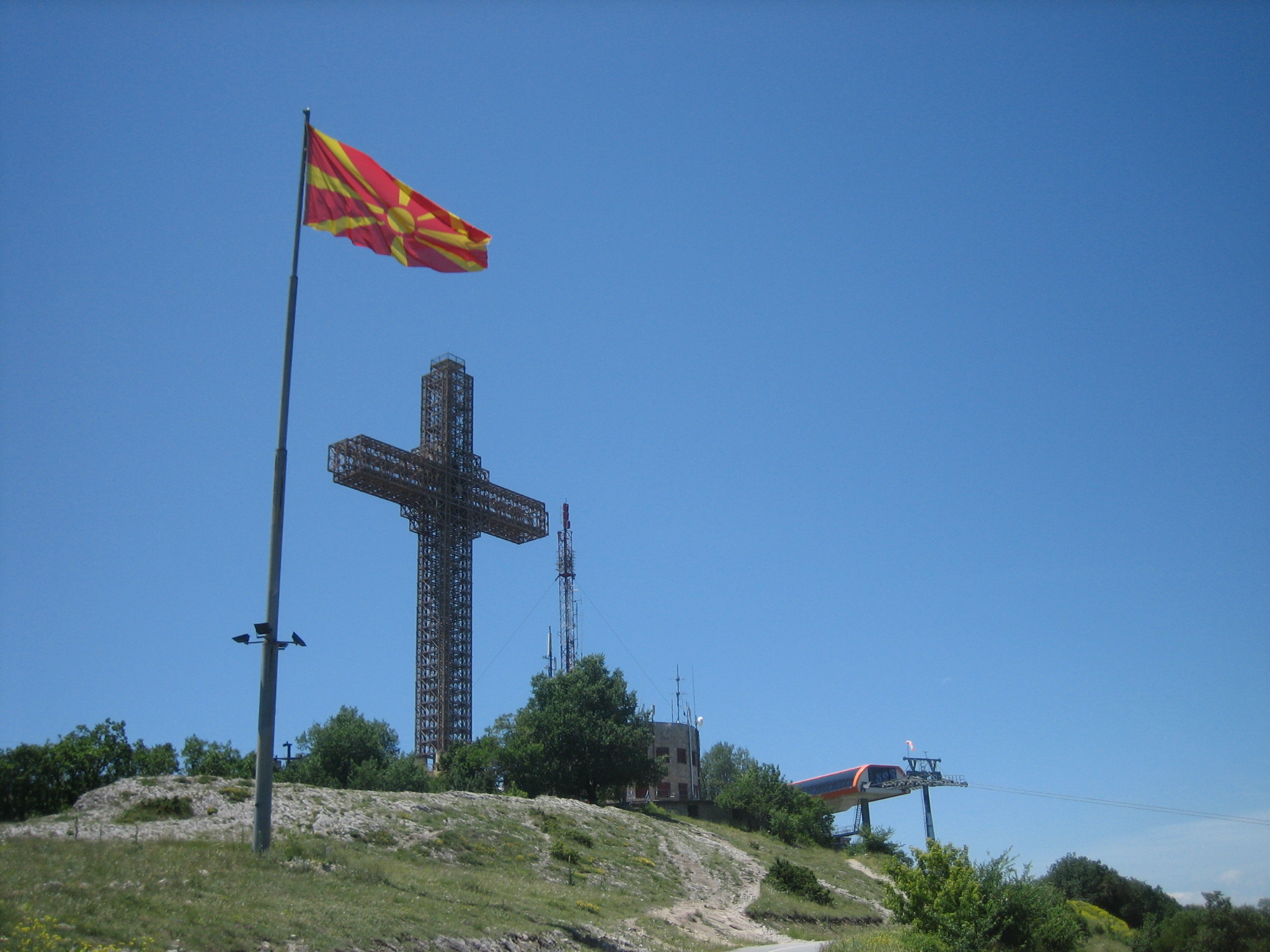
5. Ohrid Lake, which is considered to be the oldest and deepest lake in Europe is located in Macedonia. Scientists say that Ohrid Lake is 4 million years old. It has over 200 endemic species.
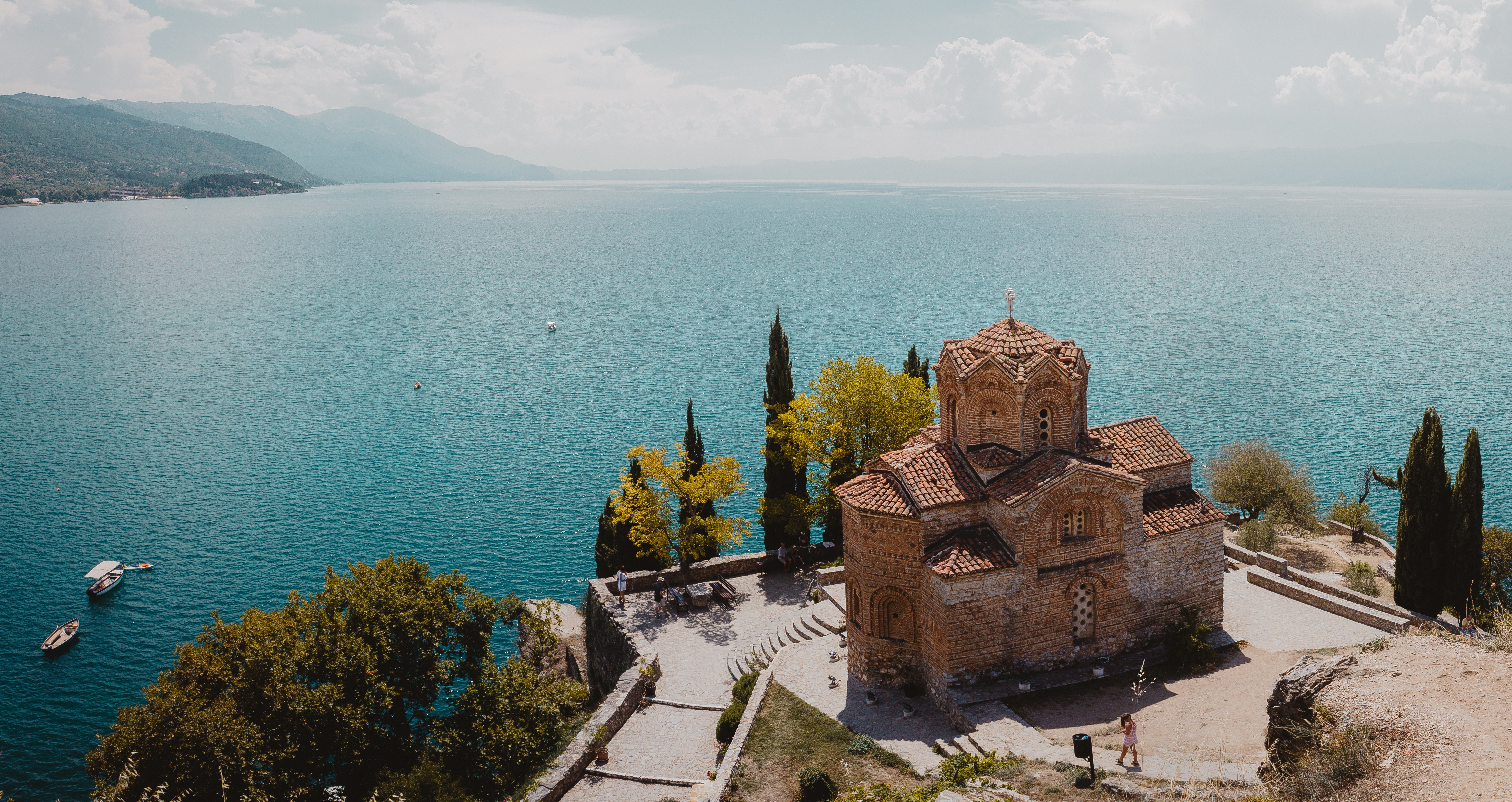
6. In the year 1963, Macedonia experienced a devasting 6.1 magnitude earthquake that destroyed its capital Skopje. The earthquake killed over 1,000 people.
7. cyrillic is the official alphabet in macedonia. .
8. The Cave Peshna is being compared to Helm’s Deep Cave from the Lord of the Rings. Cave Peshna is located in Makedonski Brod in Macedonia.
9. Alexander the Great was a king of the former Kingdom of Macedonia. He extended his empire across Greece and Persia to India and Egypt.
10. Macedonia was the first country in the world to have full access to wireless broadband.
11. Macedonia has had two flags since its independence in 1991. The first one was based on the symbol of Vergina. However, Greece claimed that they owned the copyright to use the symbol since Vergina is in Greek Macedonia.
12. The tallest construction in Macedonia is the Cevahir Sky City. It is a 42 story building that is 130 meters tall.
13. Macedonia experience earthquakes more often than in other countries because it is located above the Eurasian Tectonic Place.
14. The country has over 25 glacier mountain lakes. The most popular is the Pelister Eyes.
15. Macedonia also has 15 artificial lakes. The largest lake was made in 1953 and named Mavrovo, the same as the village nearby.
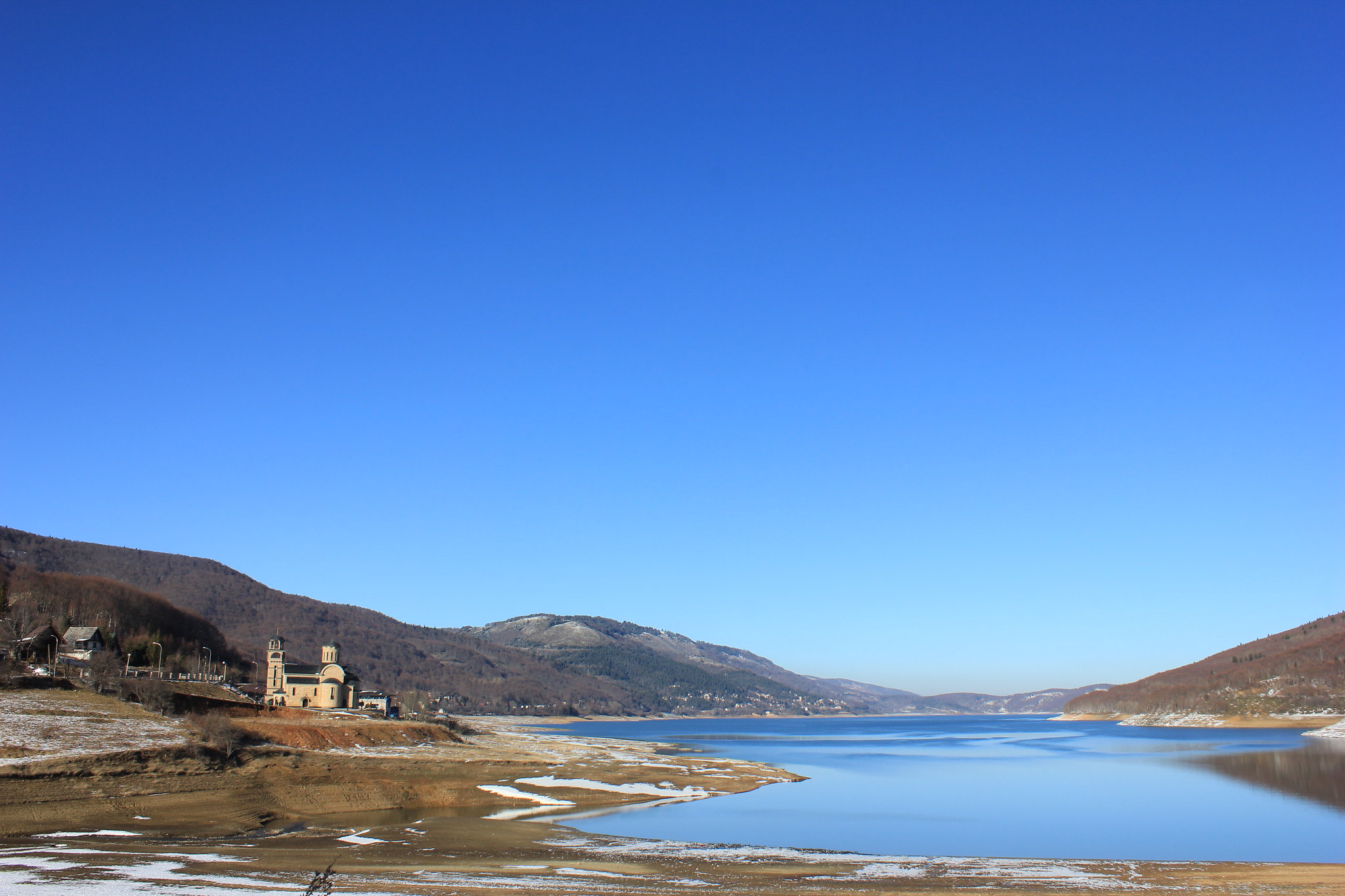
16. The Vrelo Cave located in Matka, Skopje was listed in the top 77 natural wonders of the world.
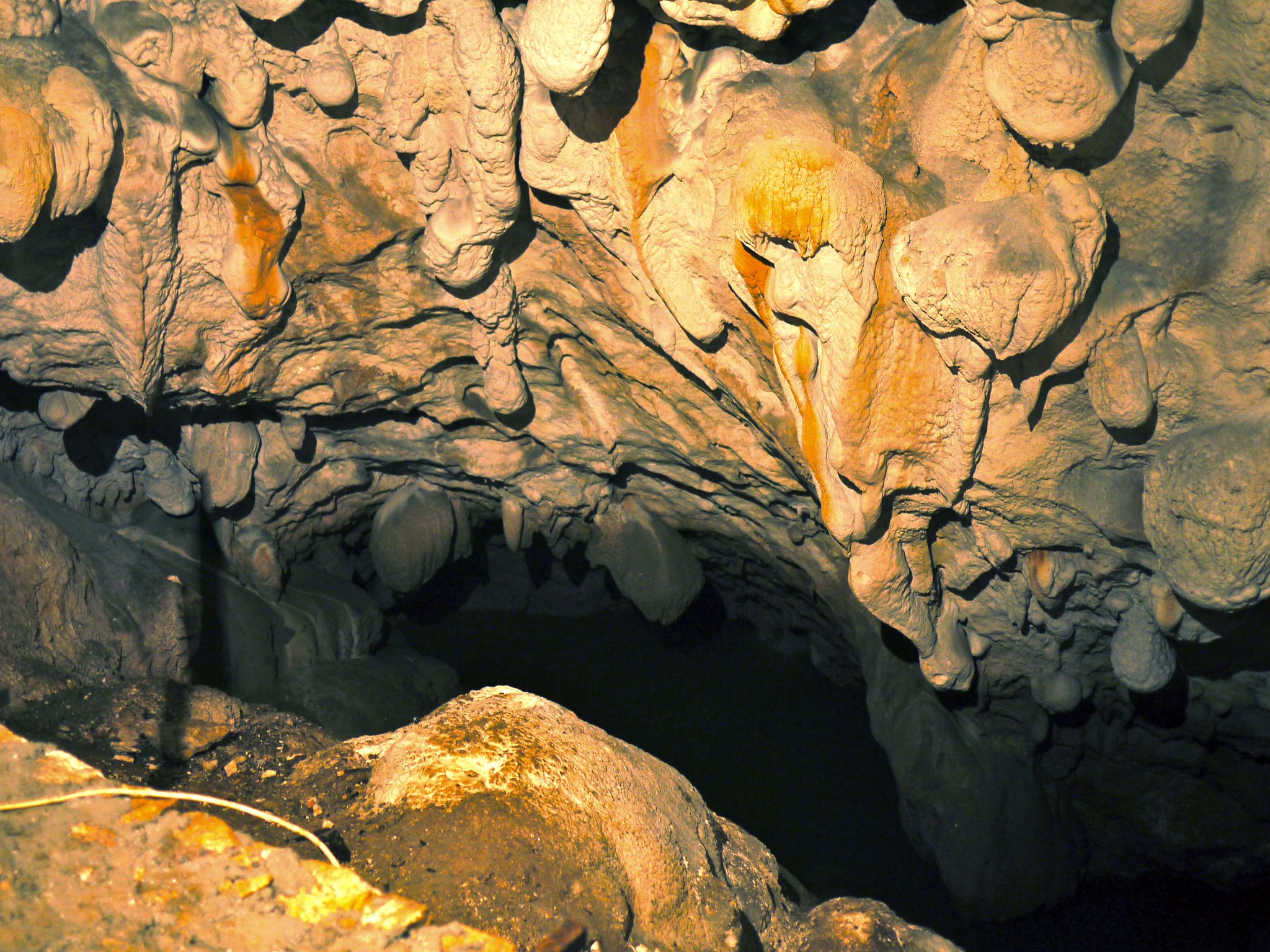
17. Macedonia has more than 164 caves.
18. If we’re going to talk about rivers, Macedonia’s Vardar is the biggest river in the country. Most of its water flows out of the country.
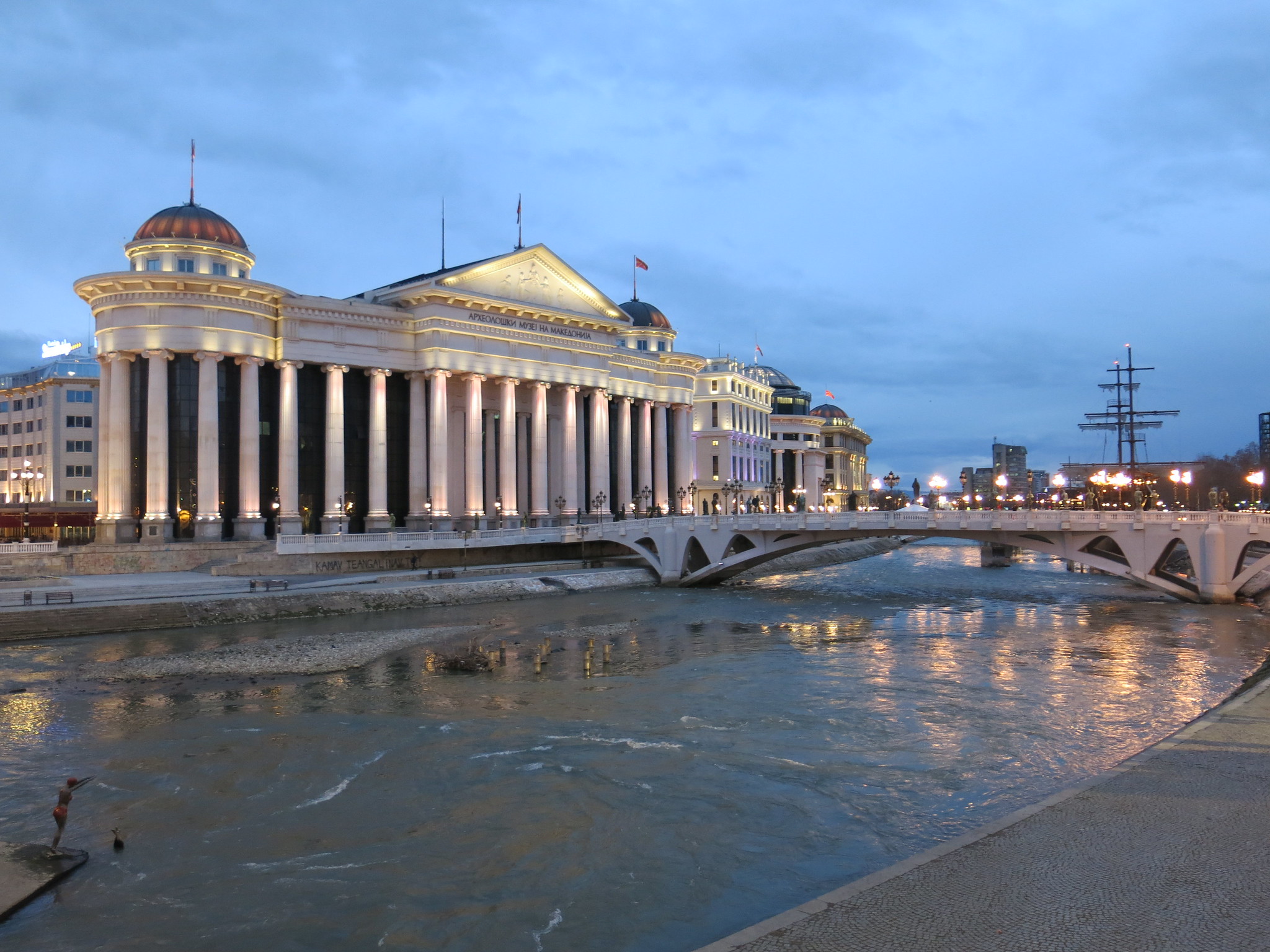
19. About 87% of Macedonia is covered by mountains. This is also the reason why the country is considered a mountainous one.
20. The highest peak in Macedonia is the Mount Big Korab. It measures 2,764 meters above sea level. It is also the highest peak in Albania since the mountain is located directly on the border between Macedonia and Albania.
21. There was a tree found in Mount Pelister and it’s one of its kind. It is an ancient endemic species called Macedonian Pine.
22. The first TV broadcasting in Macedonia was made in 1964 by Television Skopje. It still exists until now but they change the name to Macedonian Television.
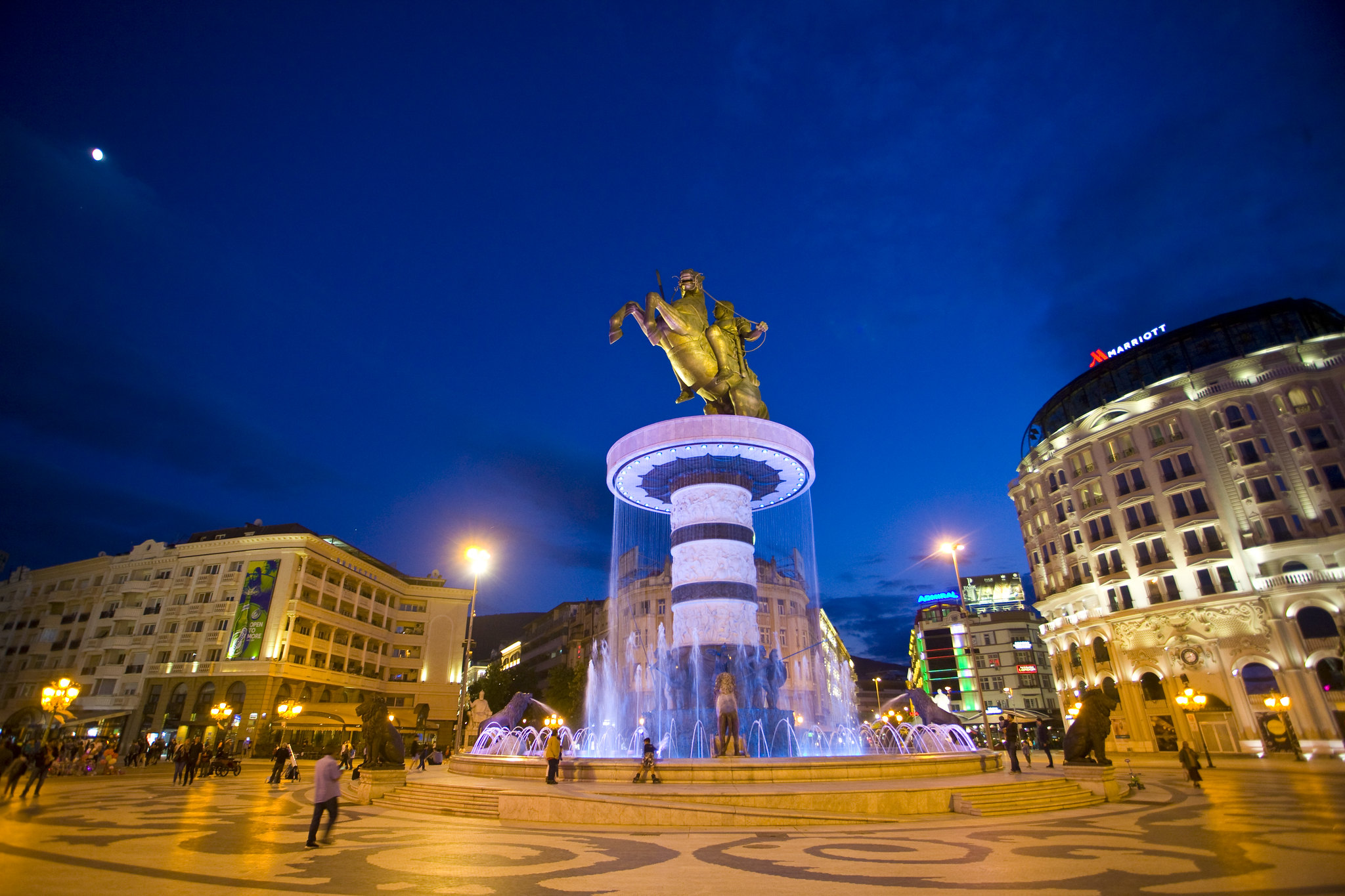
These are the things to know about North Macedonia that would get you ready when you decide to visit and explore this Balkan country. Make sure to make the most out of your adventure and bring home great memories as you leave this place and went back to your homeland.

Are you on Pinterest? Pin these!
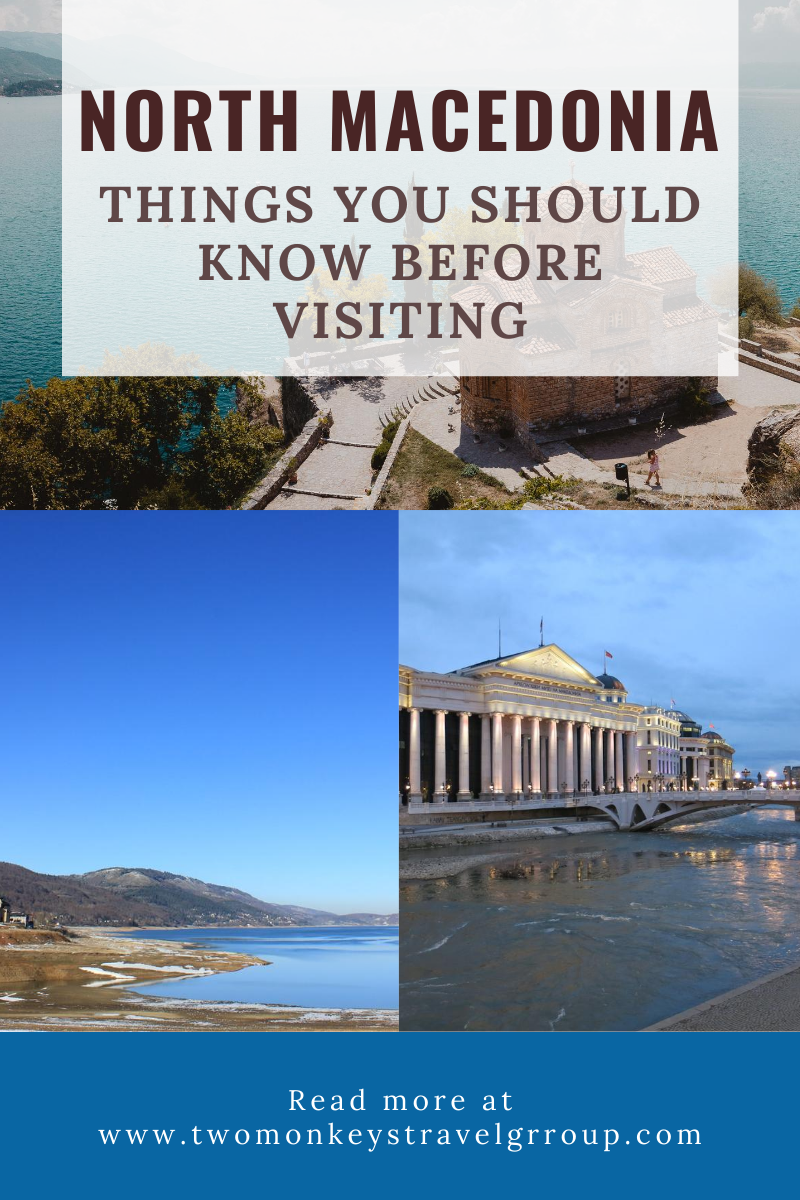
Leave a Reply Cancel reply
Your email address will not be published. Required fields are marked *
This site uses Akismet to reduce spam. Learn how your comment data is processed .
COPYRIGHT DISCLAIMER: Many of the articles on Two Monkeys Travel Group are guest posts by a number of Approved Contributors and are hosted by Two Monkeys Travel Group. Approved Contributors control their own work and post freely to our site. This includes all text and images that they use within their own work. All contributors are instructed to follow internationally recognised copyright and intellectual property guidelines. Two Monkeys Travel Group takes its own responsibilities very seriously, so if you feel that any part of this work is abusive in any way, please send us an email so that we can investigate - [email protected]
DISCLOSURE: Please note that some of the links above are affiliate links. So when you make a purchase we sometimes make a small commission, at no extra cost to you. The cost to you remains the same, sometimes even cheaper if we have negotiated a special deal for our readers.We use all of the companies we have listed here and that’s why they are in this list, but of course we need to keep Two Monkeys Travel Group running as well as it can, which is exactly what you’re helping with if you do decide to buy or book something through an affiliate link! If you have any more questions about the companies we use or any other companies you’re looking at, just email us and we’ll be happy to help. Please see our full disclaimer page for more information.
Written by Two Monkeys Travel - Contributor
Two Monkeys Travel Group – Community Travel Blog is a travel blog and website. We quickly grew into a valuable source of inspiring travel stories, advice, itineraries and travel guides, with the aim of demonstrating how to live a sustainable life of travel, whilst living your own definition of success. If you'd like to contribute and write a guest post, contact us at [email protected]
11 Best Hiking Treks To Experience in Nepal
Getting the most out of your holiday in bali, 5 best things to do in canggu, bali, indonesia [diy travel guide to canggu], 10 awesome things to do in florence, italy, africa unveiled: discovering the continent’s hidden gems and iconic landmarks, related posts, 15 best things to do in dole, france [with photos], how to get the most from your trip to sicily, luxury travel on the côte d’azur, 10 best things to do in skiathos, greece [with suggested tours], previous post, 15 best things to do in gaziantep, turkey [and where to stay], how to use wise to send money to the philippines, subscribe to our newsletter.
Receive tips on how you can live a sustainable long-term travel lifestyle!
- First Name *
- Comments This field is for validation purposes and should be left unchanged.

- Living In Croatia
- Croatian Recipes
- Balkan Recipes

Home > Things To Know Before Visiting Macedonia
Things To Know Before Visiting Macedonia

Written by our local expert Daniel
Originally from Macedonia, Daniel is a total budget travel junkie. Having visited over 35 countries, Dan knows a thing or two about traveling Macedonia and the Balkans on the cheap.
Unless you were born in Europe or visited Macedonia previously, you might not even know that this small but lovely country exists. But here are all of the things you need to know before visiting Macedonia.
Macedonia is one of the smallest, poorest, and (undeservingly) one of the least visited countries in Europe . That’s why you won’t find many articles about it online , except for some articles about Ohrid and Skopje here and there.
Well, who can give you better tips about traveling to Macedonia than a local? In this article, I’ll try to give you a glimpse of the country, show you why you absolutely must visit, and tell you everything you need to know before you do so.
Spoiler alert: this article includes information about a city of 365 churches, remote monasteries that hide pieces from the cross Jesus was crucified on, the oldest lake in Europe, the deepest underwater cave, and Macedonia’s very own snake island.
With that being said, the first thing you should know if you plan to visit Macedonia is that…
Skip Ahead To My Advice Here!
You Shouldn’t FYROM It
As you may or may not know, Macedonia has a name dispute with Greece. Long story short, Greece currently has a part of Macedonia’s historical region within its territory, and they fear their territorial integrity as long as Macedonia is named Macedonia.
Actually, no one in their right mind in Macedonia has any territorial pretensions towards this part of Greece , but that’s a different story. The temporary reference The Former Yugoslav Republic Of Macedonia (FYROM) was forced upon Macedonia back in the 1990s (even though most countries already recognized it under its constitutional name). Macedonians don’t appreciate being called that at all.
What About The Visa?

Macedonia is not a part of the E.U. or the Schengen Zone, but you don’t need a visa if you are a resident of any European country. However, if you’re from a country outside of Europe, you might need a visa , depending on where you come from. To ensure whether you need a visa or not, check out this official government site before you plan your visit to Macedonia.
Getting Around Macedonia

Macedonia has two airports, one in Skopje (the capital) and one in Ohrid (the tourist hotspot). If you’re flying from Europe, the cheapest option would be to book a flight with Wizz Air. If you’re flying from outside of Europe, consider flying to a bigger city in Europe from where you can get a Wizz Air flight. This will always be a cheaper alternative.
The best way to explore Macedonia is by bus. It’s a bit more expensive than traveling by train, but it’s a lot faster. However, if you want to get off the beaten track and explore places in areas that are not inhabited, the best way is to rent a car or hire a driver from a local tour operator. Both options shouldn’t be costly because Macedonia is so small ; you can get anywhere in the country in under 3 hours.
Now that we covered some basics let’s see some of the best things Macedonia offers.
Brands We Use And Trust
The capital is a city of contrasts (for real).

Almost half of Macedonia’s population lives in Skopje , so it’s logical for such a city to be a city of contrasts but let me give you some background. If you’re wandering around the city square, you might feel like you’re in Paris or some other Western European capital. Skopje even has its own Arc de Triomphe. However, after you cross the legendary Stone Bridge, this vibe disappears, and you start feeling like you’re somewhere in Turkey or the Middle East.
This sudden change of the environment is something that dazzles most travelers visiting Skopje, and it’s worth exploring for a day or two ( check out these incredible hotels in the city for an overnight stay ). If you think that’s not enough, take a 20-minute bus ride from the city center if you want to feel like you’re in the slums of Mumbai.
Why might you ask?
Skopje Boasts The Only Romani-Run Municipality In Europe

Romani people (also known as Gypsies) are a nomadic group that migrated to Europe from the North of India around a thousand years ago. Today, they are one of the most discriminated ethnic groups in Europe, but many of them found a home in Skopje. Shuto Orizari, called Shutka by the locals, is the only municipality in Europe (and probably the world) where Romani people have complete autonomy, including their own mayor.
Shutka also has a very famous street market where you can buy practically anything for half the price you normally would and even less if you know how to bargain. It’s not the most charming place in Skopje but certainly an unusual one, and a one you indeed won’t find anywhere else, at least in Europe.
If you want to see the prettier side of the city , I suggest you visit…
The Deepest Underwater Cave In Europe?

According to multiple sources, the deepest cave in Europe is Hranicka Propast in the Czech Republic (402 meters). However, the Vrelo Cave, located in the Matka Canyon just outside of Skopje, isn’t fully explored, and many believe it might be deeper than 400 meters. There were several attempts to measure the cave’s depth, but teams couldn’t proceed due to the pile of rocks that were blocking the way. Hence, no one really knows how deep Vrelo Cave is.
However, this cave is not the only reason to visit Matka. The Canyon is also home to 77 endemic species of butterfly and large populations of bats. You’ll also find several medieval monasteries scattered across the Canyon; you can go kayaking, witness one of the most iconic views of Skopje, and go rock climbing (not recommendable if you’re not experienced). While we’re at it…
Get Ready To Be Blown Away By The Mountain Landscapes

Mountains cover almost 80% of Macedonia’s territory. In only 25,000 square kilometers, you’ll find 50 lakes and 34 mountains higher than 2,000 meters. This makes Macedonia the fourth country in Europe with the highest average elevation (741 meters), only falling behind Andorra, Switzerland, and Austria.
Despite being such a small country, Macedonia has three breathtaking national parks in Mavrovo, Pelister, and Galicica. These are some of the last places on Earth where you can spot a very rare species: the Balkan Lynx.
If you like mountains and hiking , you will find plenty of entirely unfrequented trails in all parts of the country. And since I mentioned nature, I should also tell you that while you are visiting Macedonia, you must visit…
The Oldest Lake In Europe
The Lake in Ohrid is a UNESCO heritage site that is more than 4 million years old. It’s also one of the deepest lakes in Europe, with a maximum depth of almost 300 meters. More than 300 endemic species call the Ohrid Lake a home, which is the main reason why the lake has been on UNESCO’s list since 1979.
The Ohrid lake is also a great summer destination hosting some of the most beautiful beaches in Macedonia . No wonder a lot of international tourists choose it as their summer holiday destination every year.
Ohrid is also nicknamed the Jerusalem of the Balkans . The city used to have 365 churches in the past: one for every day of the year. But unfortunately, after the Ottoman invasion, many of them were destroyed. Talking about churches and monasteries, in the western part of the country, you can find…
Monasteries That Have Pieces Of The Cross At Which Jesus Was Crucified In Their Foundation
Most of the people in Macedonia are orthodox Christian and have been for more than 1,000 years, and the name Macedonia is mentioned several times in the bible. Christianity has been around in Macedonia since its early beginnings. It’s also believed that there are three pieces of the cross Jesus was crucified on used in the foundation of three monasteries in Western Macedonia.
One is the Monastery of St. Bogorodica Prechista (Mother Marry) near Kichevo. The second is in the St. Georgij Pobedonosec Monastery in Debar, and the third one is in the St. Jovan Bigorski Monastery, near the city of Gostivar. These monasteries have jaw-dropping architecture and have great historical importance. Still, you can also find many more monasteries scattered across the country, some of which are tucked away in the most isolated corners of the country. Talking about incredible sights…
Macedonia Is (Probably) The Only Landlocked Country That Has An Island
Macedonia is landlocked and has no access to the sea, but it has its own island. Golem Grad or Snake Island is located in Prespa Lake and is a part of the National Park Galichica.
Today, the island’s only residents are snakes, but there is strong evidence that people lived on the island at one point in time. Snake Island was opened for visitors in 2008, and if you feel adventurous, you should check it out.
Macedonia Has The Fourth Oldest Space Observatory In The World!
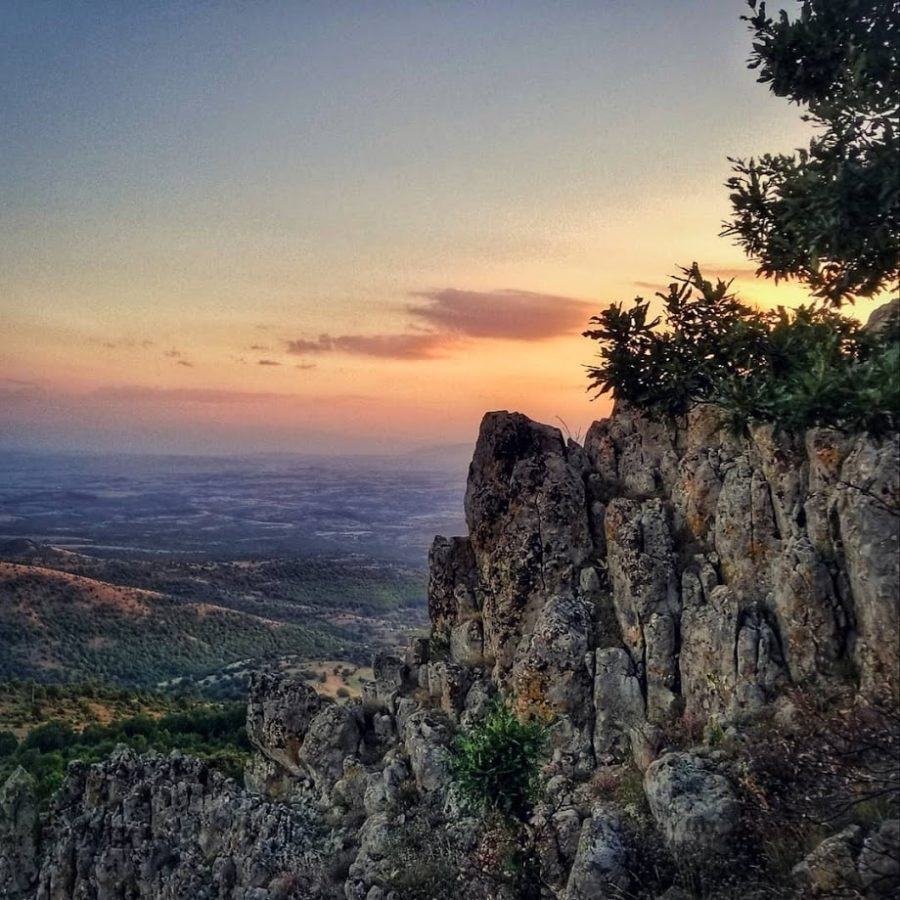
Halfway between Skopje and the border with Serbia , you’ll find Kokino. According to NASA, this is one of the oldest space observatories globally , dating back to the 19 th century B.C. In 2002, it was proven that the stone markers found on the site were used to track the movement of the Moon and the Sun on the eastern horizon. Shortly after this discovery, Kokino was added to UNESCO’s heritage list.
Macedonia Hosts One Of The Largest Annual Poetry Events In The World
The Ohrid Lake is so big it spreads across two cities, Ohrid and Struga. And the latter hosts one of the world’s largest annual gatherings of poets. The Struga Poetry evenings have been around since 1961, and the Golden Wreath, awarded on this festival, is one of the most prestigious awards a poet can get. Some of the previous Golden Wreath winners include the likes of W.H. Auden, Allen Ginsberg, and Ted Hughes.
If this sounds intriguing, you might be wondering about the costs of traveling to Macedonia . Well, you can experience all of these things for only a fraction of the price you might think it’s realistic because…
Move This Adventure To Your Inbox & Get An Instant Freebie

No spam. Unsubscribe at any time.
Macedonia Is Arguably The Cheapest Country In Europe
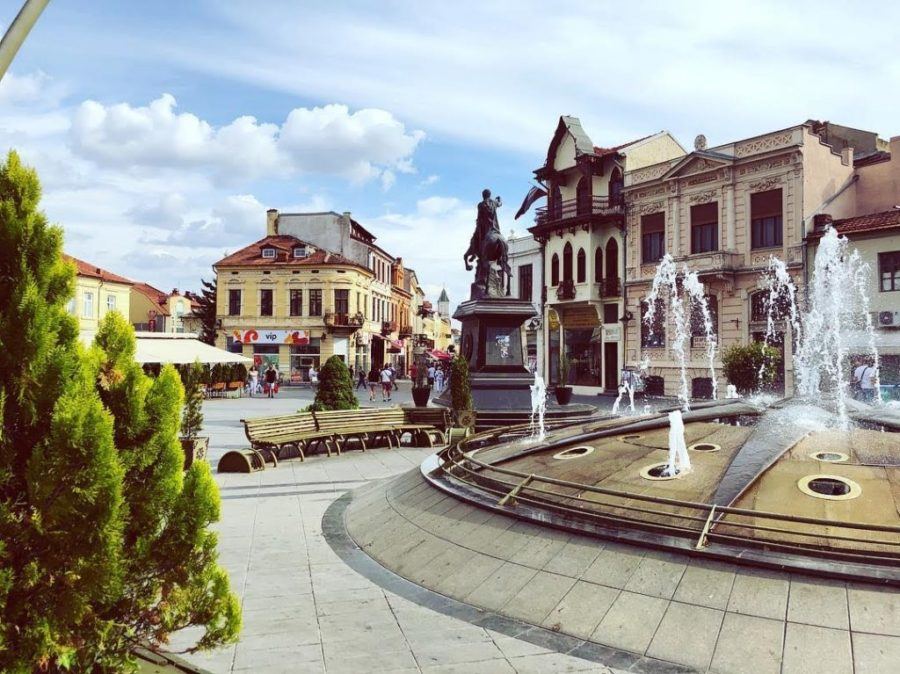
You’re probably aware that the Balkan countries have the lowest living standard in Europe, and hence, the prices for everything are a lot lower. The most expensive cities in Macedonia are Skopje and Ohrid, but they are still far from what you might consider expensive. All the other cities have ridiculously low prices, even for people from Skopje .
In Skopje, you can get a decent meal for 3-5 euros, a cup of coffee shouldn’t cost you more than 1-1.5 euro, you can get a comfortable hotel room for 20-25 euros, and you can make a circle around the country with a bus for less than 25 euros! If you want to save money, take with you a filter water bottle as you travel . The prices in most other cities are close to half of these, mainly because of the poor mismanagement of local development. This is the main reason why approximately half of the entire country’s residents live in Skopje .
Have you ever visited Macedonia before? If not, would you like to, after reading this article? Let us know in the comments!
- Guide To Ohrid – Macedonia’s UNESCO Site
- Most Famous Festivals In Macedonia
- How To Rent A Car In Skopje
- Interesting Museums In Skopje
- How To Tip In Macedonia
- Explore Macedonia Through Traditional Food
- Incredible Macedonia Winter Destinations
- Learn How To Speak Macedonian
- Affordable Luxury Hotels In Macedonia
- Top Souvenirs From Macedonia
- Travel From Skopje To Pristina, Kosovo
- Delicious Restaurants In Skopje
- Best Day Trips From Skopje
Comments (21)
I would be careful in the information you disperse. It would appropriate and professional being 100% accurate. Well very close to it. 1. There is no such country called Macedonia. 1a. Macedonia is a province of the Hellenic republic. 1b. You must be referring to North Macedonia. 2. I would not hold high in esteem people like Mr Allen Ginsberg. I suggest look up his own comments regarding NAMBL( North American men and boys lovers) yes pedophilia. 3. It is a shame people like you try to make a dollar out of sensationalism and blatant irredentism. 4. Western Macedonia? Or do you mean Ohrid and Tetovo? 5. Once again the only reference to western Macedonia, central or eastern is in the province Macedonia in the Hellenic republic. 6. Be professional this is sloppy and a terrible writeup with plenty of inaccuracies, terrible statements and questionable references.
Please leave this comment open to be viewed by as many people possible.
You must be tired of living ….. I pitty you… I can help get you out of your misery and it would be free of charge ….
What a contentious idiot you are. So sad.
Sam, I’m guessing you’re from Greece? I love how you talk about how unprofessional the write-up is yet you start by writing “It would appropriate and professional being 100% accurate. Well very close to it.” As a native English speaker, I have no idea what the hell that is supposed to mean because it makes no grammatical sense, yet you think you have the right to complain about other people’s writing. Fascinating. I think you are probably a very lonely, friendless, human being. Must kinda suck being you…
ahahah I was thinking the same
Not only does Sam Kostoulias not make grammatical sense, but he does not make historic or factual sense. In fact, he writes nonsense. Yes, it must suck living life through a politically indoctrinated lens since childhood and learning only how to hate the “Other.” Macedonia is a beautiful place with mostly great people. Forget the politicians, though.
Thank you for the information, unfortunately having fake ancient greek statues all over the city doesn’t say much about the real culture of the people. When I travelled in the region in early 80’s it was called Vranovska, it changed names a few times after the Yugoslavian war as well. I don’t see anything Greek about it, I would expect at least some authenticity as it’s claimed to be something that it’s not.
@SJ Thank you for the enticing descriptions. A very well-written piece! It has definitely made me want to go and visit the country!
Lay off the ouzo, Paula. It damages the brain. “Vranovska”? lol
Suck on my d!ck
Sam, I feel I need to correct you on your comments read coincidentally tonight Macedonia is not a monopoly of the Greeks, the name is also given to the South Yugoslavia in the days of General Tito and no one ever questioned it but the New Greeks, so please refrain from insulting the lovely people of Northen Macedonia that accepted the NORTH as the only way to go on with their life and have been busy trying to enter the EU since 2005 I am not a Pro-N. Macedonian or Anti-Greek I am a Greek with an open mind and knowledge of the Greek History No need to reply to me because I will not bother to either read it or take note of it
Sam you need to get a life.
Nobody in Macedonia has anything against the Greek people but you seem to have something against us.
Let’s be honest here.
Prior to 1988 nobody in Greece even mentioned the word Macedonia and now you are claiming it?
Why didn’t you try to claim it while Tito was in charge?
In 1977 your country officially recognised the Macedonian Language and why is that?
I have plenty of Greek friends and thank god they aren’t peasants like yourself.
Please keep your well uninformed information to yourself. No matter what anybody states Macedonia will and always will be.
Beautifully written!!
I like the article, feel it is written honestly and fairly describing the issue with name Macedonia. I am Not Macedonian, Nor Northern Macedonian, nor ever been in these two areas, I am not even living in EU, nor Europe, so feel I’m impartial enough, just checking about “Macedonia” as I was reading the Bible. Happy the authors left the critical comment – it shows the writer’s honesty. Most people realize that just bc someone has won a poetry award – it does Not make them a good person – they could be criminals too. Plenty of talented and charismatic people turned out to use their gifts from God for evil. So, Lord Jesus bless all who read this with grace, mercy and peace to know how much You love them and to love others, self, and You.
Hi, it would be great if can ask you some questions about north macedonia via email.
Thank you for your article (I will be visiting soon) About the island of a landlocked country, a quick search on google gave me : isla panza in Bolivia, ssese islands in Uganda, and many on lake Tchad
Hi,some decent information in your article.I visited Lake Ohrid in 2019 for a week and thoroughly enjoyed all the area had to offer.I would love to return to take in more of North Macedonia when flights from the UK get back to normal.The food was especially good at the restaurants sat on stilts over the Lake in the Old Town and also the people were very friendly.Swimming in the freshwater Lake was also a highlight .
What a great article! We’re currently dreaming of going to Macedonia again – we’ve been there before and we love, love love it! Here’s to a year with loads of travel plans and new experiences!
What is the best way to enter Macedonia from Greece? We will be flying into Athens from the US and are debating heading south to do Crete or North to check out Macedonia. Can you drive in if we rent a car? Or best to fly?
Thanks for the article. I want to go to Macedonia even more after reading it. I am from the US and appeciate the helpful information.
Leave a Reply Cancel reply
Your email address will not be published. Required fields are marked *
Save my name, email, and website in this browser for the next time I comment.
This site uses Akismet to reduce spam. Learn how your comment data is processed .
Subscribe To Unlock Your FREE Customizable Travel Packing List & All Our Best Tips!
Unlock Your FREE Customizable Travel Packing List!
Subscribe Now For Instant Access To Stress-Free Packing

- ALL TRAVEL GUIDES
- DESTINATION FILTER
TOP OF PAGE
Quick Facts
Best Time To Go
Cost & Spending
Travel Tips
Regions & Highlights
What To See & Do
Itineraries
What To Eat
Where To Stay
Trip Planning

Welcome traveler!
We're Andre & Lisa, adventurers and experienced budget travelers.
We have over two decades of travel experience and since 2018 have led a full-time nomadic lifestyle.
L earn more about us !
Thank you for visiting and we hope you find value in our destination pages! We thoroughly research and curate all content ourselves and everything you find on this site is put together by only the two of us.

NORTH MACEDONIA TRAVEL GUIDE
North Macedonia gained its independence in 1991 as one of the successor states of Yugoslavia. While easily accessible from all points abroad, and boasting all the amenities of the Western world, North Macedonia remains one of Europe’s last undiscovered countries: a natural paradise of mountains, lakes, and rivers, where life moves to a different rhythm, amidst the sprawling grandeur of rich historical ruins and idyllic villages that have remained practically unchanged for centuries. The country represents the Balkans in the truest sense, consisting of a fascinating mix of Greek, Albanian, Turkish, and Mediterranean influences.
The use of the country name " Macedonia " was disputed between Greece and Macedonia (now North Macedonia) between 1991 and 2019. Citing historical and irredentist concerns, Greece opposed the use of the name "Macedonia" without a geographical qualifier such as "Northern Macedonia" for use "by all ... and for all purposes". As over 2 million ethnic Greeks identify themselves as Macedonians, and view themselves as unrelated to ethnic Macedonians, Greece further objected to the use of the term "Macedonian" for the neighbouring country's largest ethnic group and language.
DO YOU NEED A VISA FOR NORTH MACEDONIA?
<<VISA RESULT>>
<< Visa Details >>
For the latest requirements or for application click
Let iVisa take the pain out of travel planning and assist you with Electronic visas, Travel Authorizations, Visas on Arrival, and even Paper Visas. They can also help with Health Declarations and Embassy Registrations. If you're from the US, they provide a One-Stop Shop to renew your Passport securely and error-free.
⬇️ REGIONAL GUIDES ⬇️
Travel guide.

⬇️ COUNTRY GUIDE ⬇️
- Capital : Skopje
- Currency : Macedonian denar
- Area : 25 713 sq km
- Population : 2,077 million
- Language : Macedonian 66%, Albanian 25%, Turkish 4%, Romani 2%, Greek 2%, Serbian 1%,
- Religion :Orthodoxy 62%, Islam 37%, other 1%
- Electricity : 220V/50Hz (European plug)
- 7 January, Orthodox Christmas
- 1 May, Labor Day
- 24 May, Saints Cyril and Methodius’ Day
- 2 August, National Day
- 8 September, Independence Day
- 11 October, Uprising Against Fascism Day
- 23 October, Day of the Macedonian Revolution
- 8 December, Saint Clement of Ohrid
Also, Orthodox Easter Monday and Eid al-Fitr.
QUICK BOOKING RESOURCES

SEASONS AT A GLANCE
Most destinations have different times of the year when they’re more or less popular with tourists.
Peak Season
Shoulder Season
Off Peak Season

BEST TIME TO VISIT NORTH MACEDONIA
North Macedonia has a relatively dry Mediterranean climate with a full array of four seasons, although spring can be quite short, and each season is tempered by the altitude.
Located so far south in Europe, North Macedonia is great to visit most of the year-round. It is particularly welcoming during spring and autumn, outside the high tourist seasons and when the weather is at its most pleasant. It can be warm and sunny during the day from as early as March until as late as November, while skiing is usually available from December through to early April. July and August can be very hot, sometimes getting up to 40°C during the day in Skopje and along the Vardar Valley. This can be particularly unpleasant if taking lengthy journeys by public transport where there is no air conditioning and the local population fears getting ill from a breeze from an open window. The mountains remain pleasantly cool, however, and even Ohrid is relatively quiet midweek in the summer.
June to August - Enjoy Ohrid's Summer Festival and dive into its 300m-deep lake.
September & October - Partake in Skopje’s Beer Fest, Jazz Festival, and harvest celebrations.
December to February - Ski Mavrovo and indulge in North Macedonia’s holiday carnivals.
BEST TIME FOR:
The snow sports season in North Macedonia can be as long as from November to April, making it a wonderful and affordable skiing destination.
The best time for outdoor activities in North Macedonia is from May to September and with three national parks there's plenty of outdoor exploring to be done.
Best Beaches
Kitesurfing: Spot Maps, Wind Season
FIND ALTERNATIVES TO NORTH MACEDONIA?
Find your perfect destination.
Advanced, real-time destination filter by visa required, region, health risk, travel budget, country value, tourist seasons, best weather and activity or sport.

MORE POSTS ON NORTH MACEDONIA

WEWILLNOMAD

NORTH MACEDONIA TRAVEL COSTS
North Macedonia is considered one of the cheapest countries in Europe and you can probably last a while here with a tight travel budget.
VALUE RANK:
Find discount flights to north macedonia, travel tips for north macedonia.
An airport shuttle bus, Vardar Express , runs between the airport and the city. Buy tickets (100MKD) from the marked arrivals terminal booth. The bus leaves half-hourly or hourly, depending on passengers, and stops at several places including the bus/train station and central square
Within Skopje, the easiest is to get around by taxi but for a longer stay, you should get a bus card and a map of the bus lines. In Ohrid (the most popular tourist destination), you can walk almost everywhere; the exception is that the bus terminal is at the edge of town, and you might have to use a taxi to get to your hotel. Most taxis will charge a flat rate of 30 MKD (in Skopje 50 MKD) with the extra kilometers added on. Be careful when negotiating the price of the fare beforehand. Within city limits, prices over 100 MKD are considered expensive outside of the summer season.
Between cities, the most popular public transportation is by bus. Trains are infrequent and will get you to fewer destinations than buses. Renting a car, of course, will give you more freedom to see more.
An intercity bus is a normal way for locals to get from city to city. The buses are modern and comfortable. The Skopje bus and train station are in the same building. At present (2018), you cannot buy a bus ticket online; you can only buy it at the bus station.
The bus between Skopje and Ohrid takes about three hours by the shortest route and costs about 500MKD one way. There are about 15 buses a day on this route. In high-season, they may be sold out, so it is best to go over to the bus station the day before to get your ticket.
Cycling is popular in Skopje. Traffic is light in rural areas, though mountains and reckless drivers are common.
REGIONS & HIGHLIGHTS OF NORTH MACEDONIA
North Macedonia might be a small country but there's no shortage of sight and activities.
Gaze out over Ohrid from the Church of Sveti Jovan at Kaneo, immaculately set on a bluff above the lake.
Dive into historic but fast-changing Skopje , a friendly, quintessentially Balkan capital.
Enjoy the old-world ambiance of Bitola and hike nearby Pelister National Park .
Soak up the serenity at clifftop Zrze Monastery , with sweeping views of the Pelagonian Plain and priceless Byzantine artworks.
Ski Mavrovo , North Macedonia's premier winter resort.
NORTH MACEDONIA TRAVEL ITINERARY
Spend two nights in Skopje, marveling at its bold new architecture, and visiting its Čaršija (old quarter), with historic churches, mosques, museums, and an Ottoman castle. Next head southwest to Macedonia's most charming and historic town, Ohrid, and enjoy its spectacular lake, calling at the lush forested mountains of Mavrovo on the way. After two days, continue to cultured Bitola, the long-famed 'City of Consuls' known for its vibrant cafes and nearby Pelister National Park.
Take your time in and around Skopje, Ohrid, and Bitola, then add on a visit to Macedonia's famous Zrze monastery. Before returning to Skopje, enjoy winery-hopping in the Tikveš wine region.
WHAT TO SEE AND DO IN NORTH MACEDONIA
Skopje is among Europe's most entertaining and eclectic small capital cities. Recent years have seen an abundance of statuary, fountains, bridges, museums, and other structures built to encourage a national identity but luckily plenty survived from earlier times – Skopje's Ottoman- and Byzantine-era wonders include the 15th-century Kameni Most (Stone Bridge), the wonderful Čaršija (old Turkish bazaar), Sveti Spas Church , with its ornate, hand-carved iconostasis, and Tvrdina Kale Fortress , Skopje's guardian since the 5th century.
Ohrid is North Macedonia's prime destination, with its atmospheric old quarter with beautiful churches along a graceful hill, topped by a medieval castle overlooking serene, 34km-long Lake Ohrid. It's considered the jewel in North Macedonia's crown and undoubtedly its most alluring attraction, especially when you factor in the nearby Galičica National Park and the further secluded beaches that dot the lake's eastern shore.
Mavrovo 's ski resort is North Macedonia's biggest, comprising 730 sq km of birch and pine forest, gorges, karst fields, and waterfalls, plus Macedonia's highest peak, Mt Korab (2764m). The rarefied air and stunning vistas are great year-round.
Bitola , the second-largest city is also North Macedonia's most "European" town. With elegant buildings and beautiful people, elevated Bitola (660m) has a sophistication inherited from its Ottoman days as the 'City of Consuls'. Its 18th- and 19th-century colorful townhouses, Turkish mosques, and café culture make it North Macedonia's most intriguing and liveable major town.
Kruševo , a museum-city nestled high up in the mountains of southwestern North Macedonia. It is one of the most historically significant destinations in the country as it was the site of a revolt against the Ottoman Empire. The town is also home to some great skiing.
Just over 20km northwest of Prilep, towards Makedonski Brod, the 14th-century Zrze Monastery of the Holy Transfiguration rises like a revelation from a clifftop. The monastery's tranquil position around a spacious lawn, with views over the outstretched Pelagonian Plain, is stunning. During Ottoman times, Zrze underwent periods of abandonment, rebuilding, and plunder but remained an important spiritual center. Its 17th-century Church of Sts Peter and Paul contains important frescoes and icons.

WHAT TO EAT IN NORTH MACEDONIA
Macedonian cuisine is typically Balkan, with a combination of Mediterranean and Middle Eastern influences. You will find lots of meat grills ( skara ), and plenty of fresh vegetables and herbs used in local dishes.
Ajvar - Sweet red-pepper sauce; accompanies meats and cheeses.
Šopska salata - Tomatoes, onions, and cucumbers topped with flaky sirenje (white cheese).
Uviač - Rolled chicken or pork wrapped in bacon, filled with melted yellow cheese.
Tavče gravče - Macedonian specialty of baked beans cooked with spices, onions, and herbs and served in earthenware.
LGBTQ IN NORTH MACEDONIA
I'm a paragraph. I'm connected to your collection through a dataset.

WHERE TO STAY IN NORTH MACEDONIA
For your first visit to North Macedonia, it's essential to choose a base that allows you to explore the country's rich history, stunning landscapes, and vibrant culture. Here's a breakdown of top areas and accommodations:
Where to stay in Skopje:
Skopje, the capital city, offers a blend of ancient history and modern amenities, with landmarks like the Skopje Fortress, Old Bazaar, and Alexander the Great Square.
Budget: Hotel Russia : Hotel Russia provides affordable accommodations near the city center of Skopje. Guests can stay in comfortable rooms and enjoy amenities such as free Wi-Fi and breakfast. The hotel offers a convenient base for exploring the city's landmarks and attractions.
Mid-range: Hotel Leonardo : Hotel Leonardo provides mid-range accommodations near Skopje's Old Bazaar and historic sites. Guests can stay in modern rooms, enjoy amenities such as a fitness center and sauna, and dine at the hotel's restaurant serving traditional Macedonian cuisine.
Luxury: Marriott Skopje : Marriott Skopje is a luxury hotel located near the city center and the Vardar River. Guests can stay in elegant rooms and suites, enjoy access to a fitness center and indoor pool, and dine at the hotel's restaurant offering Mediterranean cuisine.
Best Value Tip: Visit during the shoulder seasons (April-May, September-October) for mild weather and better accommodation rates.
Where to stay in Ohrid:
Ohrid is a picturesque town nestled on the shores of Lake Ohrid, known for its UNESCO-listed Old Town, ancient churches, and pristine beaches.
Budget: Vila Bisera : Situated near the city center and the lake, Vila Bisera provides affordable accommodations with comfortable rooms and basic amenities. Guests enjoy its convenient location and easy access to attractions and restaurants.
Mid-range: Hotel Belvedere : Hotel Belvedere provides mid-range accommodations with panoramic views of Lake Ohrid. Guests appreciate its modern rooms, wellness center with a sauna and massage services, and restaurant serving local and international cuisine.
Luxury: Hotel Tino Sveti Stefan : Hotel Tino Sveti Stefan is a luxury hotel located on the shores of Lake Ohrid. Guests can stay in elegant rooms and suites with lake views, enjoy access to a private beach area, outdoor pool, and gourmet
Best Value Tip: Book accommodation in advance for the summer months (June-August) when prices tend to be higher due to tourism.
Where to stay in Bitola:
Bitola is a charming city with a rich Ottoman heritage, featuring attractions like the Heraclea Lyncestis archaeological site and the bustling Shirok Sokak pedestrian street.
Budget: Hotel Kapri offers budget-friendly accommodations in the city center of Bitola. Guests appreciate its clean rooms, convenient location, and friendly staff. The hotel provides basic amenities and is a great choice for travelers on a budget.
Mid-range: Hotel Sumski Feneri : Hotel Sumski Feneri offers mid-range accommodations in a tranquil setting near the Dragor River. Guests can stay in spacious rooms and suites, enjoy amenities such as a fitness center and sauna, and dine at the hotel's restaurant serving local and international cuisine.
Luxury: Hotel Premier Centar : Situated in a historic building in the city center, Hotel Premier Centar offers luxurious accommodations with modern amenities. Guests can stay in stylish rooms and suites, enjoy access to a fitness center and sauna, and relax at the hotel's rooftop terrace with panoramic views of Bitola.
Best Value Tip: Visit during the spring or fall for pleasant weather and fewer tourists, resulting in better accommodation deals.
By choosing a base in Skopje, Ohrid, or Bitola, you'll have access to North Macedonia's diverse attractions while enjoying a range of accommodation options to suit your budget and preferences. Consider visiting during the optimal seasons for each location to maximize your travel experience while getting the best value for your stay.
CHOOSE ANOTHER DESTINATION
Recent blog posts, plan your trip, visa services, let ivisa take the pain out of travel planning and assist you with electronic visas, travel authorizations, visas on arrival, and even paper visas. they can also help with health declarations and embassy registrations. if you're from the us, they also provide a one-stop shop to renew your passport securely and error-free..
FLIGHTS Find a cheap flight by using Sky scanner or Momondo . These are our favourite flight search engines. They index other travel websites and airlines across the globe to easily find you the best deal.
ACCOMMODATION
Booking.com is our number one resource for researching and booking accommodation. In addition to Booking.com , we have found Agoda.com to consistently returns the cheapest rates in Southeast Asia.
TRANSPORT
DiscoverCars.com is a leader in online car rental bookings; we compare car rental deals from many companies so that you can choose which is best for your trip. 12Go connects the world door-to-door, from transfers to flights, under the same user-friendly ticket.
INSURANCE Travel insurance can protect you against unexpecte d illness, injury, theft, and cancellations.
Heymondo (International Travel Insurance)
World Nomads (Travel / medical insurance for long-term travellers and nomads)
SafetyWing Nomad Insurance (Travel / medical insurance for long-term travellers and nomads)
Need more help to book your trip? Check our complete resource page for all the best companies to use when you travel. You will only find the companies we use ourselves.
Please note that some of the links above may be affiliate links, and at no additional cost to you,
we may earn a commission if you end up making a purchase.

The 25 Best Things to do in North Macedonia
- Pinterest 26
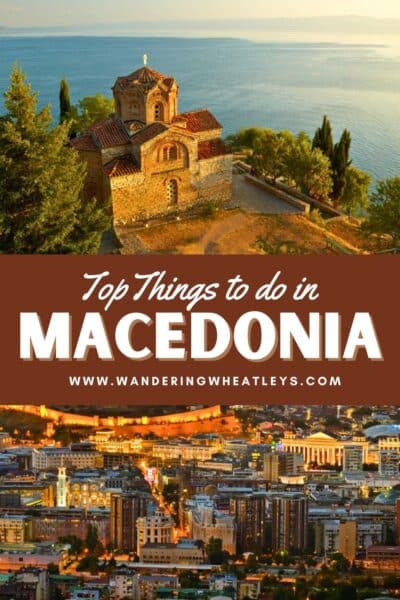
A fascinating melting pot of Ottoman, Roman, and Greek heritage, North Macedonia (officially the Republic of North Macedonia) is a place designed to captivate, dazzle, and delight you. Summers are beautifully warm and sunny, with highs of around 90°F. This makes May to September a fantastic time to visit if you want to explore North Macedonia’s stunning landscapes.
By contrast, winters can get icy cold, with temperatures dropping down to 41°F. Although the countryside can look achingly gorgeous when it’s covered in a thick blanket of snow, there aren’t many cool things to do in North Macedonia at this time of year. It’s best to plan your visit for summer to get the most out of your trip.
Whatever type of vacation you’re planning, you’ll never be stuck for what to do in North Macedonia. From wide-open spaces teeming with stunning hiking trails and magnificent buildings you’ll never forget to enchanting festivals steeped in culture and colorful villages just begging to be explored, North Macedonia is filled with wonder and magic.
With so many exciting things to see and do, it can be tricky to know where to begin. To give you a helping hand, we’ve put together a list of the absolute best things to do in North Macedonia. Add these fun activities and attractions to your North Macedonia bucket list, and you’re sure to have a fantastic time exploring this dramatically beautiful country.
Disclaimer: This post may contain affiliate links. If you make a purchase or booking through one of our links we may earn a small commission (don’t worry, it’s at no extra cost to you).
25 Fun and Unique Things to do in North Macedonia
1. be mesmerized by the painted mosque.
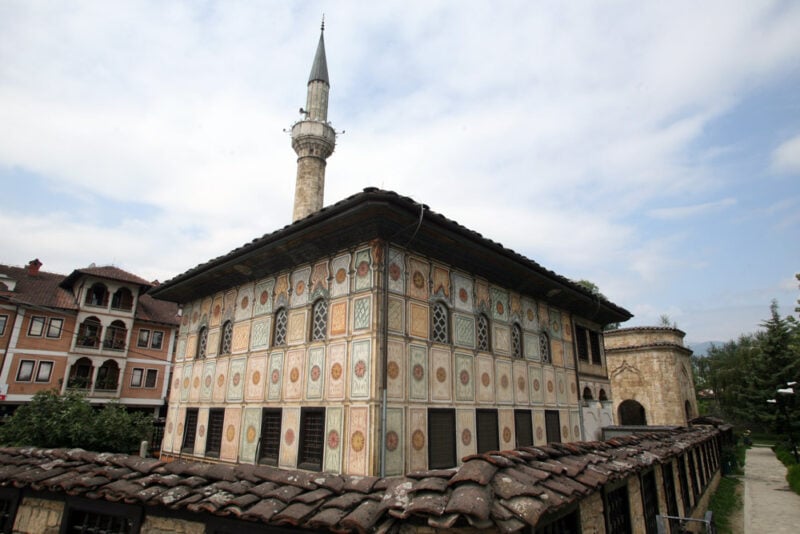
It doesn’t matter whether or not you’re interested in religious buildings or architecture – visiting the Painted Mosque is one of the best unique things to do in North Macedonia. This place of worship is located close to the Pena River in Tetovo and is known by many different names, including Šarena Džamija, Xhamia e Larme, and the Decorated Mosque.
The 15th-century masterpiece boasts a handsome exterior with tall marble columns, windows covered with wooden latticework, and marvelous paintings. But all this glamor is just a hint at what lies within the grandiose building.
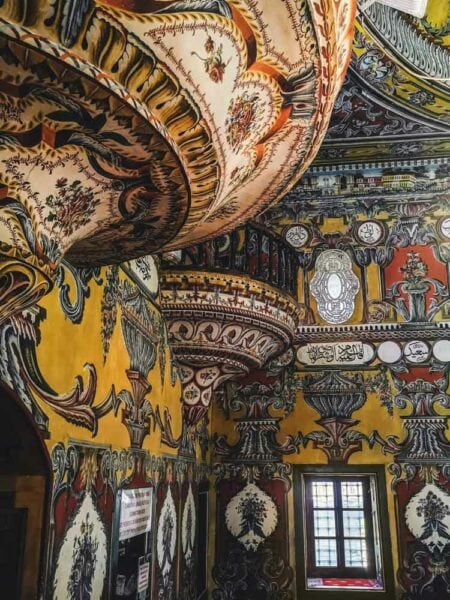
Remove your shoes and prepare to be amazed as you step inside. You get the impression that every single color in the world has been used to decorate the interior of the mosque. And you probably wouldn’t be far off! All the walls and balconies you can see are intricately decorated with amazing frescoes, floral patterns, geometric shapes, and Arabian-inspired designs.
2. Hike to the Top of Mount Ljuboten
Stretch your legs and take on the challenge of hiking to the peak of Mount Ljuboten. This colossal mountain is the highest in the Šar Mountains, a staggeringly impressive range that stretches for 994 miles between North Macedonia and Kosovo. At 8,196 feet tall, Mount Ljuboten practically touches the clouds and is guaranteed to reward you with sensational panoramas you’ll never want to forget.
It takes around 5 hours to hike to the top of the mountain, so you’ve got to be in pretty good shape. At the 5,500-foot mark, you’ll find Villa Ljuboten Mountain Resort, a humble guesthouse where you can begin your adventure.
Follow the trek in summer (it will most likely be blanketed in snow in winter), and you’ll have the pleasure of hiking through lush green meadows dotted with wildflowers as you work your way up to the peak. You may also be lucky enough to spot some wild goats and lynx along the way.
3. Seek Out Rare Wildlife at the Mavrovo National Park
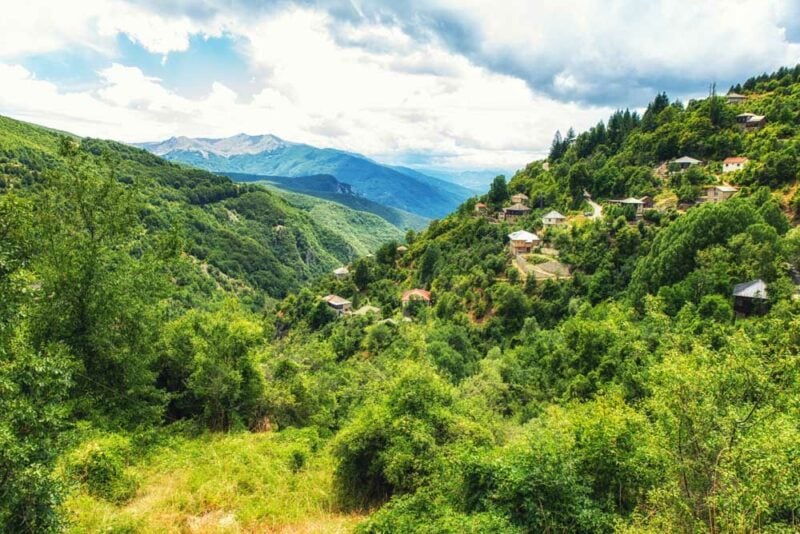
For some of the best North Macedonia sightseeing, spend the day at the Mavrovo National Park . The biggest national park in the country, Mavrovo is genuinely regarded as being the most beautiful part of North Macedonia, and we’re certainly not going to disagree. Whether you want to work up a sweat and go hiking or take it easy and just enjoy the views, you’ll have an amazing day here.
In winter, Mavrovo is where you’ll find the best slopes in North Macedonia. Rent some ski or snowboarding equipment from one of the pop-up huts which appear during the colder months and whiz down the snow-covered mountains.
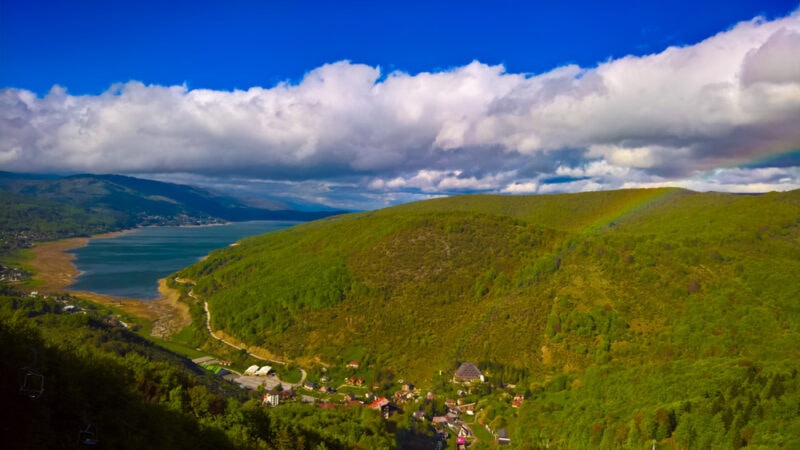
In summer, Mavrovo looks like a completely different place. At this time of year, the park is brimming with thick green grass, towering pine forests, plunging gorges, and cascading waterfalls. Deer, wolves, lynx, and bears can even be spotted throughout the park during the warmer months.
On the outskirts of the park, you’ll find charming monasteries, locals making and selling amazing cheese, and countless quaint villages that you can spend hours wandering around.
Enjoy a Full-Day Tour of Mavrovo
4. Feel Like a Star at the Manaki Brothers Film Festival
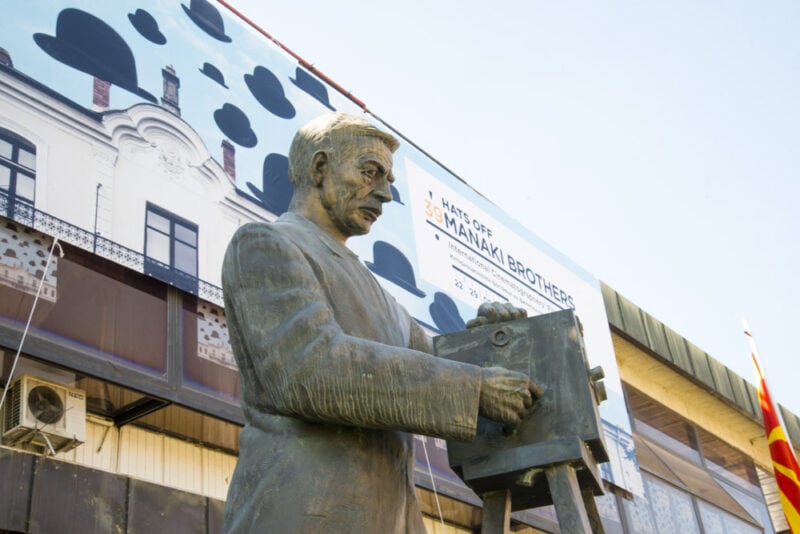
The Manaki Brothers Film Festival may not be one of the oldest in the world, but it’s been running for a solid five decades. It was established way back in 1979 by brothers Yanaki and Milton Manaki, who were major pioneers for 20th-century moviemaking in the Balkans. They wowed people for decades with photographic art and documentaries, some of which date back as early as 1904.
Today the festival has branched out and celebrates the masterpieces created by international directors, producers, and cinematographers from across the world. Each event showcases a huge range of movies from all kinds of genres, from horror and short films to animation and comedy. It’s designed to introduce people to up-and-coming cinematographers as well as established professionals who may have been forgotten.
Each edition of the Manaki Brothers Film Festival is concluded with a spectacular awards ceremony. If you can bag yourself a ticket, you’ll have the chance to experience an incredible evening as a VIP.
5. Wander around Skopje
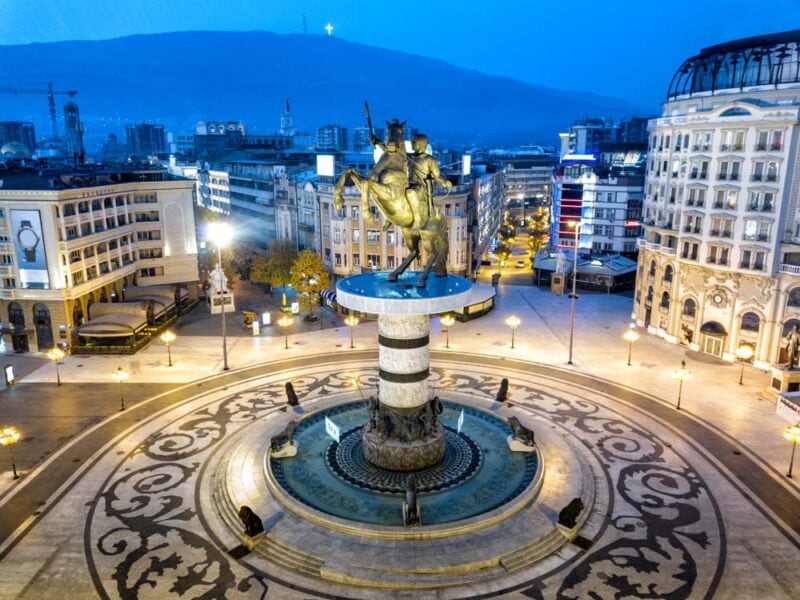
No matter where you’re basing yourself, spending a day exploring Skopje is one of the must-do things in North Macedonia. The country’s capital city, Skopje is a stimulating fusion of old and new, filled with exciting things to discover and inspiring places to explore. We suggest you get yourself to the city and simply see where your feet take you.
One of the first things that will grab your attention in Skopje is the impressive Millennium Cross. It stands 217 feet high on top of Vodno Mountain and looks down on the city below. Another landmark worth checking out is the Kale Fortress. This has been an important part of the city since the 6th century AD, and you can still visit the ruins today.
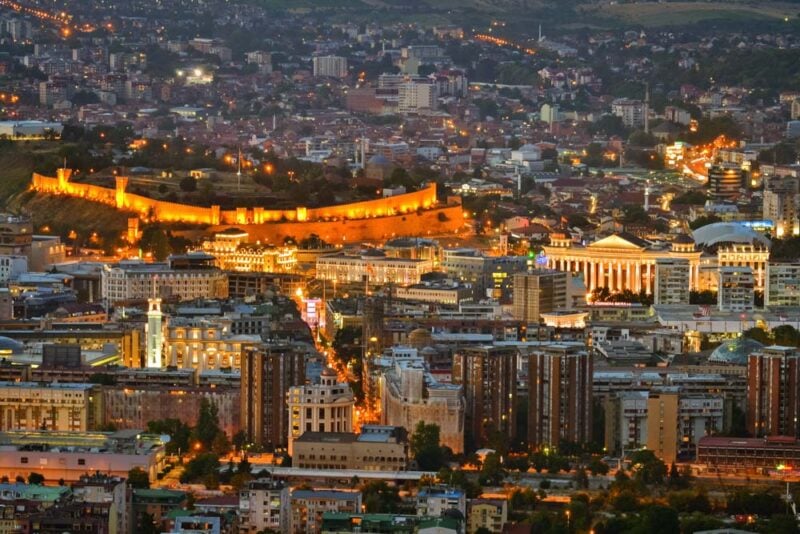
The Old Bazaar is one of the most popular parts of the city. Here you’ll find a labyrinth of slender cobblestone streets that have been bustling with shoppers since the 12th century. And don’t miss the chance to wander around Skopje’s downtown square. The government spent a whopping $700 million to turn it into the kitschy, quirky place it is today.
Visit the City of Skopje
6. Gaze at the Gorgeous Mosaics of Heraclea Lyncestis
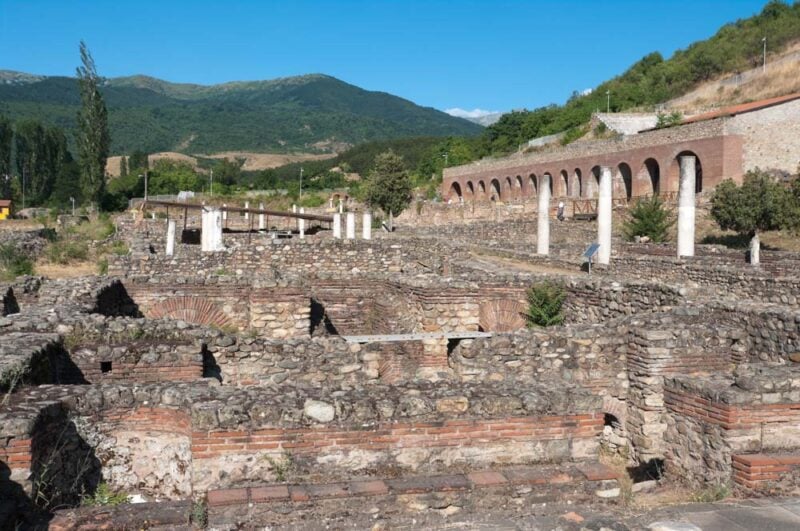
North Macedonia is teeming with stunning villages to traverse, and Heraclea Lyncestis is absolutely one you’ve got to visit. This ancient Greek city may be little more than ruins today, but what remains is so delicate, beautiful, and intricate that you’ll seriously be missing out if you don’t swing by.
The most impressive ruins are located south of Bitola, nestled on the gentle slopes found below the village of Bukovo. Take a walk around, and you’ll find what’s left of once-breathtaking amphitheaters and astounding bathhouses. While a lot of the buildings have been almost destroyed, many of the detailed mosaics which decorated them are still intact.
Many famous people throughout history are tied to the city, including Strabo, Polybius, and Caesar. If you want to find out more about Heraclea Lyncestis and its colorful past, there’s a small museum with a handful of beautiful artifacts on-site.
7. Become Addicted to Sarma

When you need a break from all the fascinating North Macedonia attractions, find a local restaurant and order a plate of sarma . This classic comfort food is hugely popular throughout the entire country, so you won’t have to go far to find it.
Sarma is a traditional North Macedonian dish made of delicate cabbage rolls stuffed with seasoned ground beef and fluffy rice. Although it’s mostly eaten in winter when people devour plates of the stuff to keep warm, it’s available throughout the year and is absolutely worth trying, whatever the weather.
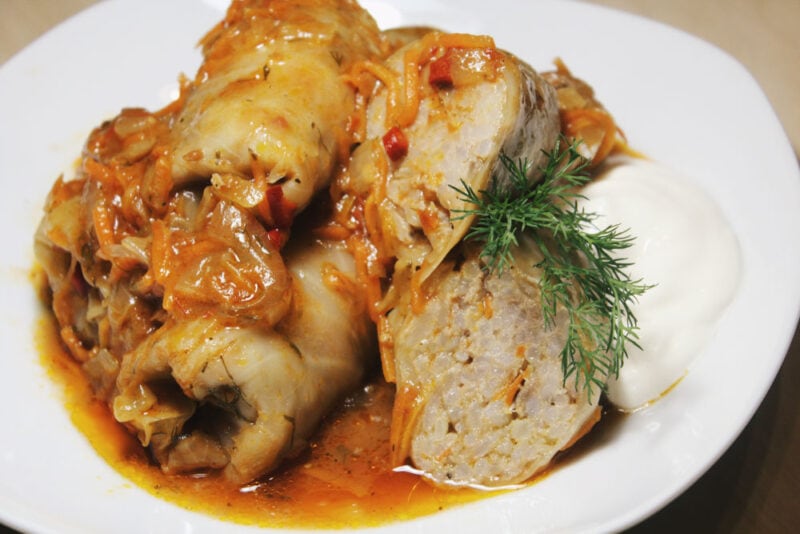
In winter, sarma is usually made with fermented cabbage leaves, which are slowly baked in the oven and served with whatever sides and sauces you like. But in summer, the cabbage is switched to vine leaves, and the dish is served with cooling sour cream.
Skopski Merak in Skopje serves some of the very best sarmas in North Macedonia. The menu is filled with all kinds of other local dishes for you to try, too, making it a great place to go to get a taste of Macedonian cuisine.
8. Sip, Sip, Sip on a Macedonian Wine Tour
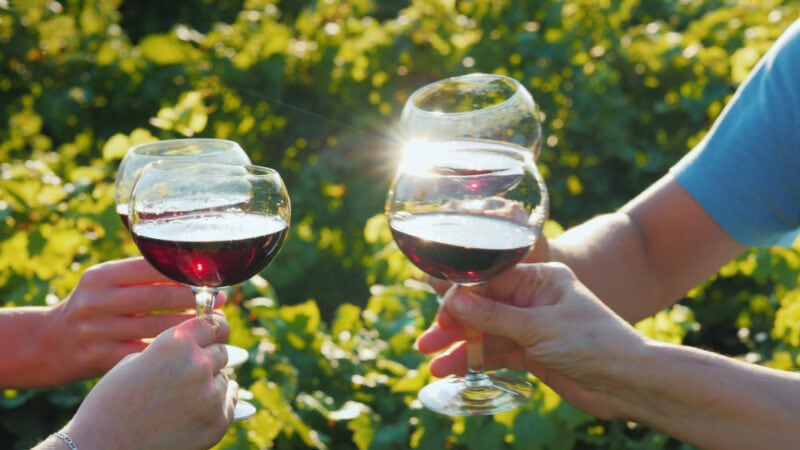
North Macedonia may not be the first country that comes to mind when you think about incredible wine, but just wait until you try your first glass. This small country has been making magnificent wine for thousands of years. There’s even evidence to suggest that winemaking in North Macedonia goes as far back as Neolithic times!
See what all the fuss is about by signing up for a wine tour. This gourmet adventure begins in Skopje and whisks you away to the Kartal Winery. You’ll get to take a look around the winery and find out exactly how the family that runs it grows their special grapes and transforms them into fine wines.

Now for the best bit – the tasting! You’ll get to try different types of locally-produced wine, including vranec, merlot, cabernet sauvignon, chardonnay, and riesling, all of which will be accompanied by tempting platters of cured meats, cheeses, bread, and olive oil.
Take a Wine Tour in Skopje
9. Get Lost in a Network of More Than 300 Caves
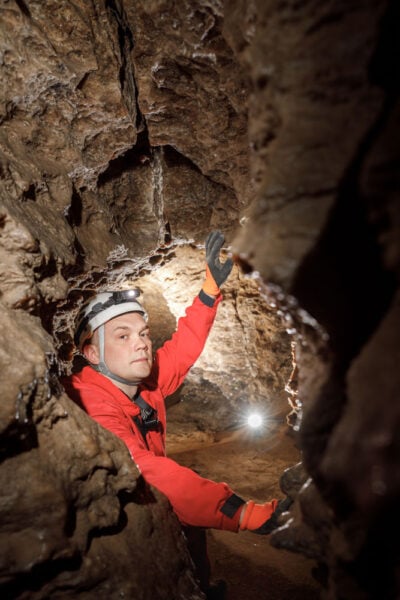
If you’re looking for something a little out of the ordinary, spend the day at Gorna Slatinska. This natural attraction is home to one of the most fun things to do in North Macedonia – spelunking.
The country’s one-of-a-kind landscape is full of secret holes and hidden caves. In fact, there are over 300 just waiting for you to venture in and explore. The best spot to try out the quirky sport of spelunking is Gorna Slatinska, where you’ll find a thrilling tunnel that stretches on for a quarter mile.
If you’re not scared of enclosed spaces, you’ll have an incredible time working your way through the alien-like landscape in search of weirder and more wonderful rock formations. As well as the stalactites and stalagmites, which come in every shape and size imaginable, the caves are also home to bats which leave the safety of their rocky beds and soar through the space.
10. Witness a Traditional Macedonian Wedding

You don’t have to be friends with any locals to be invited to a real Macedonian wedding. On one special day each year in July, the remote mountain village of Galičnik in the northwest of the country celebrates one of the most unusual festivals of the year as everyone comes together to witness the wedding of one special couple.
The festival dates back to the start of the 20th century when only 5,000 people lived in Galičnik. Because of its lack of opportunities, many young people moved away. On the Saturday that fell closest to St. Peter’s Day, young people who had left would return to the village to get married so they could celebrate their special day with their families. Back then, it was common for 40 couples to get married on the same day!
Today, the lucky couple wears the traditional local dress and goes through the traditional rituals of the time. If you plan your visit to coincide with the wedding, you’ll get the chance to see people playing music on generations-old instruments, singing ancient songs, and dancing the Montenegrin Teškoto.
11. Check Out the Views from the Top of Mount Vodno
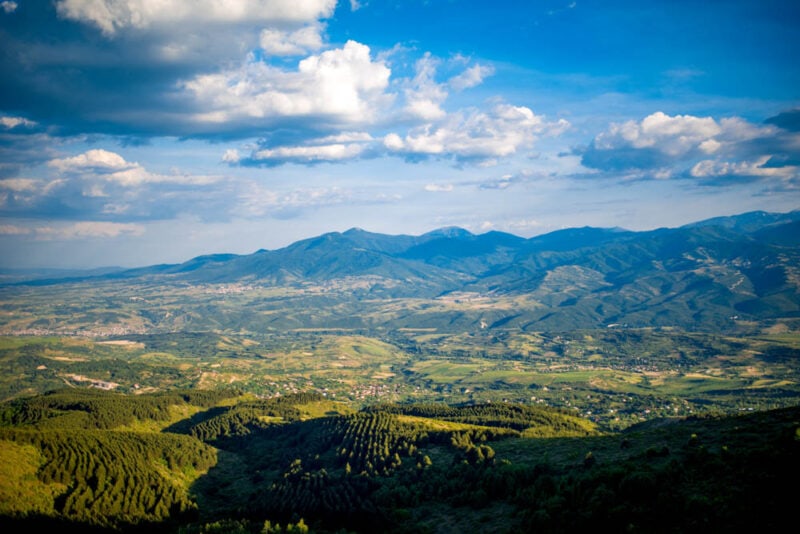
You’ll find some of the best sights in North Macedonia from the peak of the towering Mount Vodno. This colossal mountain is located in the north of the country, southwest of Skopje, and rises an astounding 3,500 feet into the sky. The lofty summit is known as Krstovar Peak, and if you make it to the top, your efforts will be rewarded with spectacular views of North Macedonia’s capital city and the surrounding valley.
Don’t worry if the thought of hiking that far makes you gasp. You don’t have to walk up the steep mountain face to arrive at the top. You can take a gentle and relaxing ride to the peak on a cable car.
Take the time to look around as you whiz to the top. The views are absolutely stunning. The cable car is also a great way to get to grips with Skopje and the surrounding areas.
If you do find you’ve got a little energy to spare when you reach Krstovar Peak, there are plenty of much more chilled-out hiking trails available.
Ride a Cable Car up Vodno Mountain
12. Gaze at the Unusual Architecture of Veles
Anyone who travels to Veles usually goes for one reason and one reason alone – the Kosturnica Memorial. This one-of-a-kind tribute is a WWII remembrance statue that is guaranteed to look nothing like any other memorial you’ve ever seen in your life.
The Kosturnica Memorial dates back to the late 1970s and was created in memory of Partisan soldiers. They lived in Veles and fought bravely against the fascist Bulgarian and German forces that were trying to take over during the National Liberation War in the early 1940s. It’s designed to represent an open poppy – the symbol of life and rebirth. Although, depending on where you’re standing, it can be difficult to see that.
While you’re there, make sure you step inside the memorial. Here you’ll find a fascinating museum that boasts the biggest mosaic in North Macedonia. Thanks to the memorial’s soaring position, you can also admire some incredible views of Veles way down below.
13. Go Kayaking in Matka Canyon
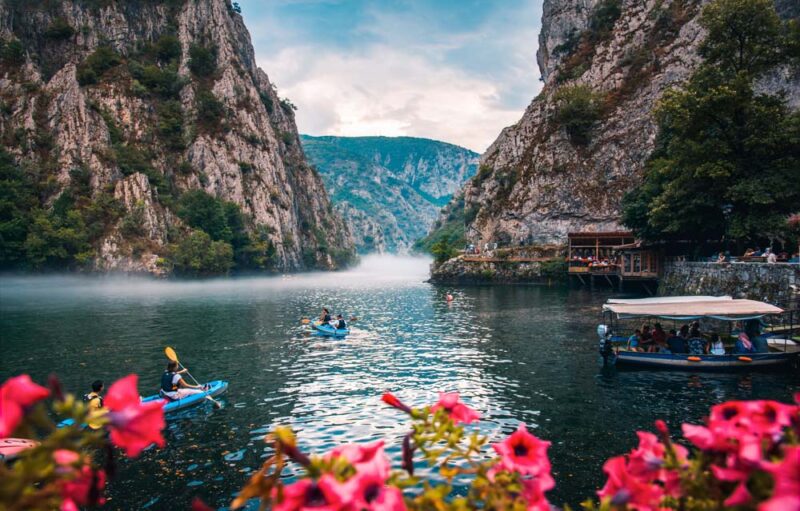
When you’re looking for a bit of excitement, leave the city behind and head 10 miles away to Matka Canyon. Here you’ll find the Treska River and one of the best things to do in North Macedonia – kayaking. The sparkling river curves past limestone cliffs which seem to scrape the sky before opening up to the grand Matka Lake.
Unless you’ve got your own kayaking gear, you’ll have to visit the Canyon Matka Hotel’s restaurant at the lake to rent some. But when you’ve got that sorted, nothing is stopping you from hitting the water and paddling upriver to the eerie Vrelo Cave. This mystical cave is easy to spot – it’s a deep chasm with illuminated pathways and steps that take you to various underground lakes.
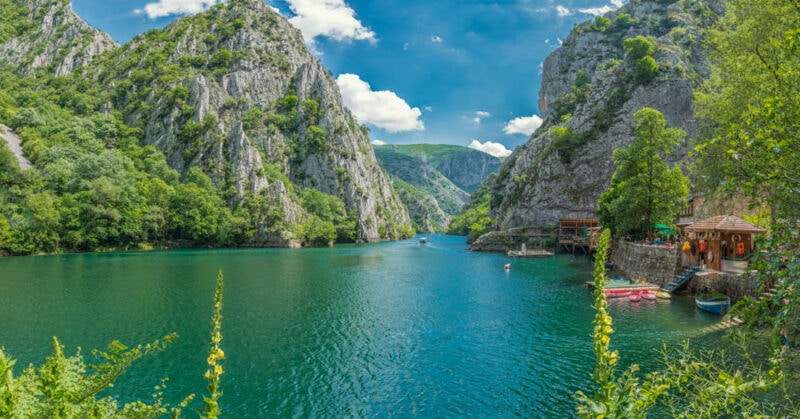
If that sounds like a bit too much effort for you, you can sign up for a boat tour and check out the caves at a more leisurely pace instead. Alternatively, follow one of the many hiking routes in the area or visit one of the popular rock climbing walls.
Explore the Stunning Matka Canyon
14. Keep It Simple with Tavce Gravce

Baked beans may not sound like the most exciting dish to try while you’re on vacation, but this classic North Macedonian dish isn’t just any old baked beans. Tavce gravce has such a rich, comforting, indulgent flavor and moreish texture combo that it’s loved by practically all local people and eaten by families throughout the country.
This iconic dish is made by boiling beans and covering them with a sauce made from a buttery rue flavored with ground red pepper. When the sauce is perfectly balanced, the beans are spooned into a skillet or pan and baked in the oven, where the flavors infuse and develop.
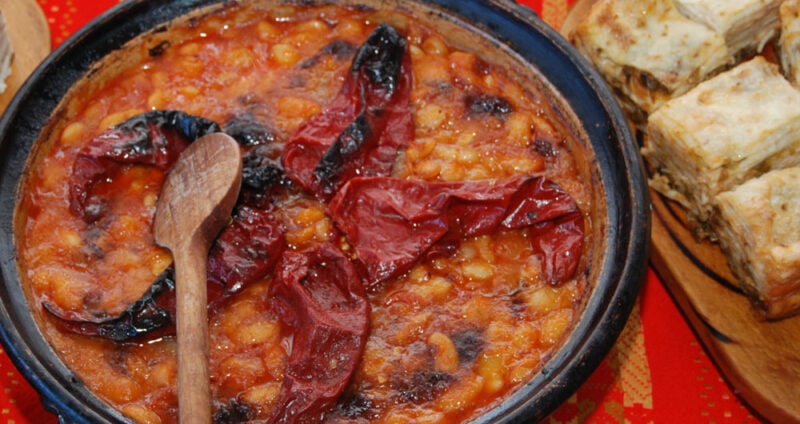
Tavce gravce genuinely tastes so good that you could easily eat it on its own without any extras! But most locals make a full meal of it by serving it with ribs or sausages. Kaj Kanevche dishes up an incredible tavce gravce . Here it comes with a huge smoked sausage and steamed seasonal veggies.
15. Visit the Spot Where Mother Teresa Was Baptized
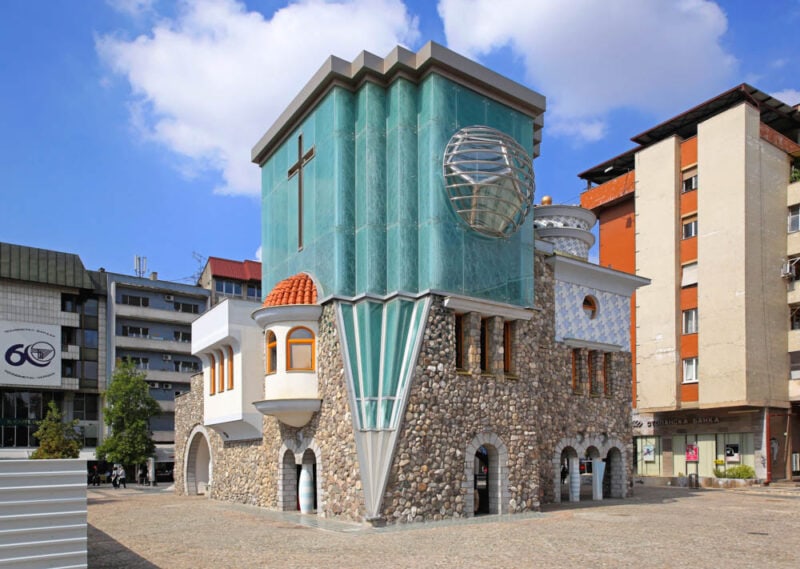
For one of the most interesting things to see in North Macedonia, take a trip to the Memorial House of Mother Teresa. The famous nun was born in Skopje in 1910, and although her birthplace no longer exists, you can still visit the place she was baptized.
The spot has since been transformed into a combined chapel and museum that’s dedicated to Gonxha Bojaxhi, the real name of the Nobel Peace Prize winner who lived in the capital city of North Macedonia for 18 years.
The chapel museum was designed by Vangel Božinovski, who took inspiration from Mother Teresa’s birthplace to design it. Take a look around, and you’ll find an impressive amphitheater in the basement, a comprehensive museum on the first floor, and a surprisingly futuristic chapel on the top floor.
Some of the most interesting parts of the museum include documents handwritten by Mother Teresa, different objects that played important roles in her life, photographs of her with prominent figures, and even life-size models of her at different ages.
16. Experience the Thrill of Paragliding in Kruševo
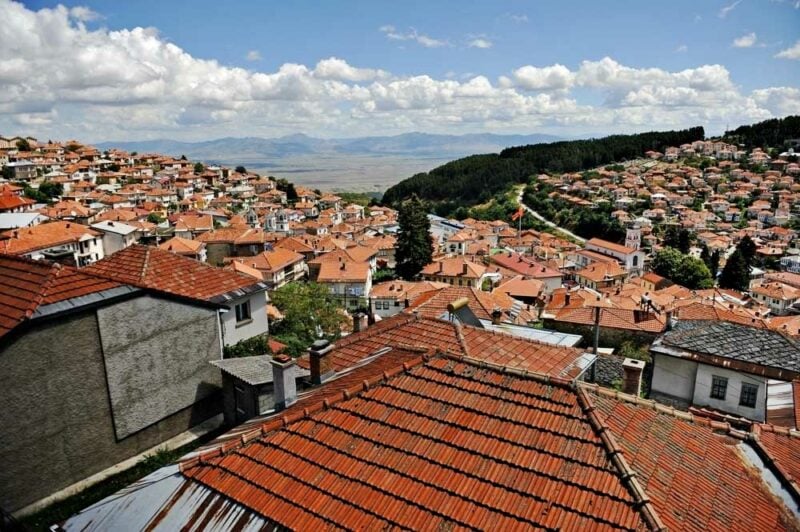
Kruševo is the place to go if you’re seeking high-speed thrills in North Macedonia. The highest city in the country, this stunning place is more than 4,400 feet above sea level and boasts the ideal conditions for amazing paragliding.
Whenever you visit, you’ll notice colorful wings dotting the sky, swooping left and right like butterflies. If you’re feeling brave, stop by one of the paragliding kiosks in the city and sign up for the remarkable experience yourself.
Meckin Kamen is where the takeoff spot is located, just a couple miles out of town. An average flight lasts for 10-15 minutes, but if you’re lucky enough to catch good thermals, you could glide up in the air for around 20 minutes.
Don’t worry if you’ve never been paragliding before. You’ll be strapped to a qualified, experienced instructor who will make sure you’re completely safe while soaring like a bird!
See Krushevo’s Ottoman Architecture
17. Visit the Space-Age Makedonium
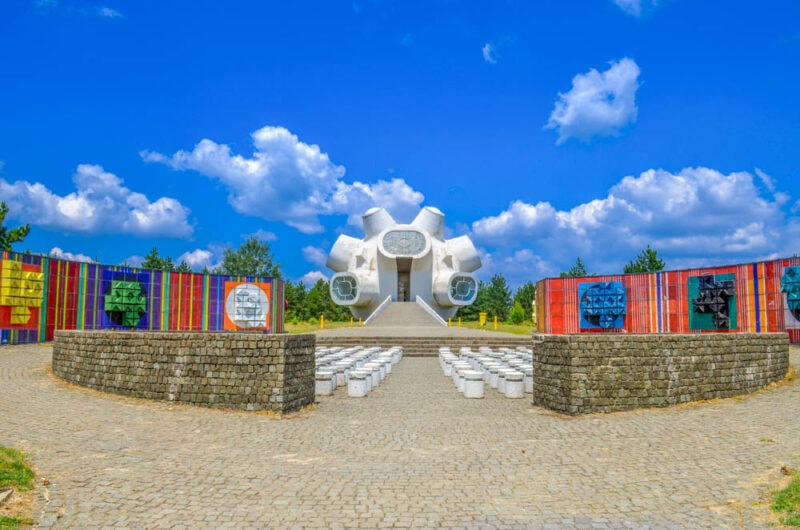
You’ll find another one of the top things to do in North Macedonia in Kruševo, too. The Makedonium (also known as Llinen) is a monument created in honor of the brave Macedonians who battled against the Ottoman Empire, pioneering the powerful movement that led to the country becoming free.
Although the uprising took place in 1903 and the monument was created in 1974, the Makedonium looks bizarrely futuristic, like something that’s been pulled straight out of space. In fact, the memorial looks so unusual that if the artist didn’t explicitly state that the Makedonium is in honor of the brave fighters and it wasn’t situated in the memorial park, it’s unlikely anyone would make the connection!
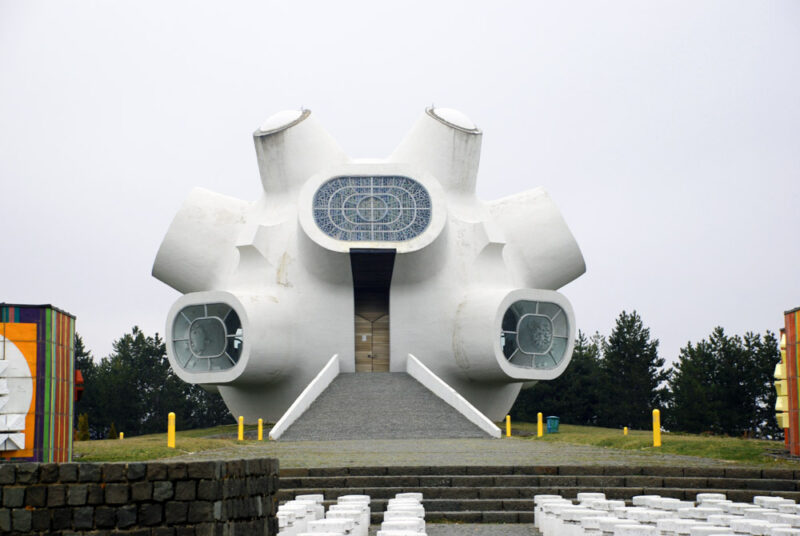
The Makedonium looks a little like a heart valve, except it’s strikingly white and boasts a handful of giant stained-glass skylights that jut out from its circular base. You won’t see any depictions of soldiers or statues here, but the memorial is still captivating and worthy of a picture or two.
18. Unleash Your Cultural Side at the Ohrid Summer Festival
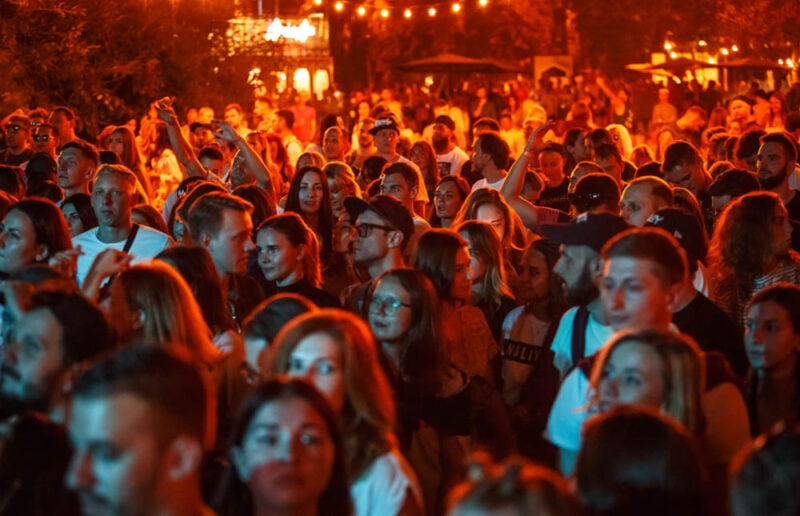
If you’re visiting North Macedonia in July or August, you’ve absolutely got to check out the Ohrid Summer Festival. One of the country’s biggest and most popular events of the year, the Ohrid Summer Festival dates all the way back to 1961 and takes place in a dazzling city that was founded in the 4th century BC.
Every year thousands of people from all over the world head to the picturesque village for the chance to witness phenomenal music concerts, spectacular theatrical shows, and astounding dance recitals. There are so many exciting performances going on throughout the festival that it usually takes 6-8 weeks to cram it all in.
There’s an excellent mix of famous and up-and-coming performers, giving you plenty of opportunities to discover new artists, bands, and groups. Some of the most famous performers over the years have included the Russian opera singer Elena Vasiliyevna Obraztsova and Belgian violinist Vadim Repin.
19. See the Partially Submerged Church in Mavrovo
Mavrovo is the place to go if you enjoy seeking out the more obscure attractions when you’re on vacation. One of the most unusual things to do in North Macedonia, a visit to St. Nicholas Church after a particularly heavy rainfall will give you the chance to take some fantastic photos that you can’t get during the dry summer months.
The Mavrovo church never used to be underwater. But after a dam was created to stop the Mavrovo River, the basin it’s located in became flooded, partially submerging the church and other surrounding buildings. Today, the church is the only building that battled the water and still remains intact.
It’s important to remember that the church isn’t always submerged – only after there’s been a lot of rain. But if it is standing on dry ground when you visit, this gives you the chance to step inside and find out what the interior is like.
20. Step Back in Time in Ohrid
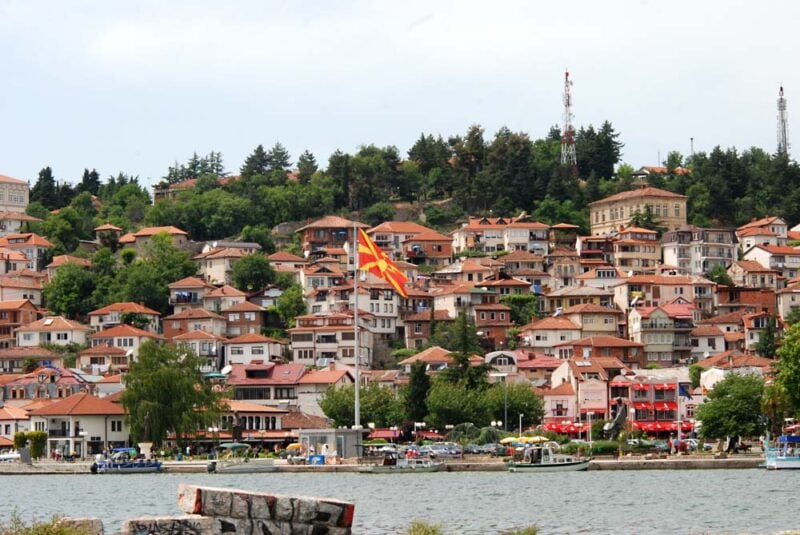
No matter how long or little you’ve got to spend in North Macedonia, Ohrid is one of those places you’ve definitely got to visit. The city is home to one of the oldest lakes in the world that dates back more than a million years – and that’s just the start of it. The entire region is listed as a UNESCO World Heritage Site, and there are so many beautiful hidden treasures here that you could easily spend an entire day just wandering its streets.
Because Ohrid has been around for so long and has such a rich history, it’s brimming with historic buildings. The monasteries and churches are the most impressive, especially the Church of Saint John at Kaneo which boasts a gorgeous location on the shore of the lake. St. Panteleimon, the oldest Slav monastery in the world, is also worth checking out.
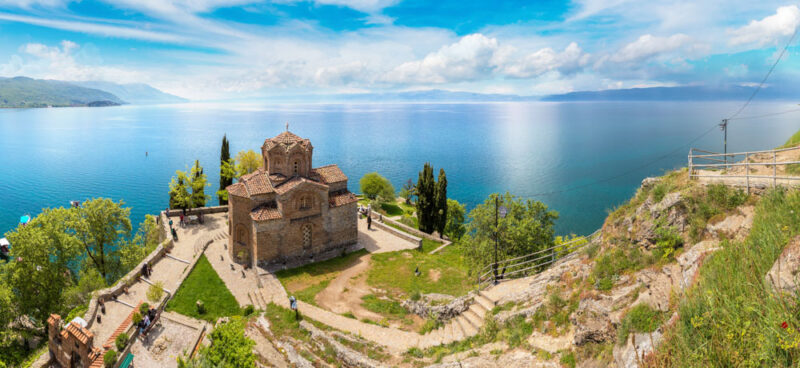
Don’t miss the chance to walk the ancient streets of the Old Bazaar. Simply follow your instincts and see where your feet take you! If you fancy something a little more demanding, head south and explore the Falicica National Park, where you’ll find countless walking, hiking, and cycling trails.
Stroll Through the Old Town of Ohrid
21. Mix It Up With Pastrmajlija

Many countries have their own version of pizza and North Macedonia is no different. Known as pastrmajlija , North Macedonian pizza comes in loads of different varieties, giving you plenty of excuses to order it again and again.
It looks a little like Turkish pide – an ellipse-shaped pie with a raised puffy crust on the outside and a center filled with gooey cheese and all other kinds of deliciousness. Standard pastrmajlija is topped with bite-size pieces of pork or chicken, but pork fat is often used, too. Not only does this make the pizza taste amazing, but it also makes the dough softer and more tender.
Stipska Pastrmajlija is one of the most incredible places for pastrmajlija . Set inside what looks like an abandoned street mall in Ohrid, this unassuming place tops its pizzas with top-quality pork, brushes the crust with butter, and finishes it off with spicy peppers that really bring everything together.
22. Find Out How Paper Was Made the Old-Fashioned Way
Ohrid is full of great attractions, including one of the most interesting North Macedonia activities. This gorgeous city is where you’ll find the National Workshop for Handmade Paper, a small and humble museum where you can see paper being made the same way it was hundreds of years ago.
The staff here put on a great performance, showing you how people used to press and dry slurry centuries ago. They then roll it out and leave it to dry before using the traditional technique to print on it. The workshop is home to an amazing printer that’s an exact copy of the 15th-century Guttenberg’s printing press. There’s only one other like it in the world!
The prints are usually historical documents, as well as centuries-old books and scenes of what life was like back then. The National Workshop for Handmade Paper is a great place to spend an hour and gain an insight into what it was like to live hundreds of years ago in North Macedonia.
23. Discover Macedonian Heritage with the Strumica Carnival
Dating back to 1670, the Strumica Carnival is one of the oldest and most sensational events in North Macedonia’s calendar. It takes place every year during the first days of the Great Lent – this is an Eastern Orthodox religious time that changes each year, so check the calendar to find out the exact dates before you book your flights.
The carnival goes non-stop for three days, with all kinds of dazzling events, from music concerts and dance performances to religious processions and gorgeous parades. All the events take place throughout the streets of Strumica. So even if you’re just in the area, it’s almost certain you’ll come across something fabulous.
If you’re traveling with little ones, make an extra effort to be in the city on Sunday. This day is reserved for the children’s carnival, when they’re free to dress up and enjoy child-specific carnival activities with their parents.
24. Check out a Performance at the Macedonian National Theater
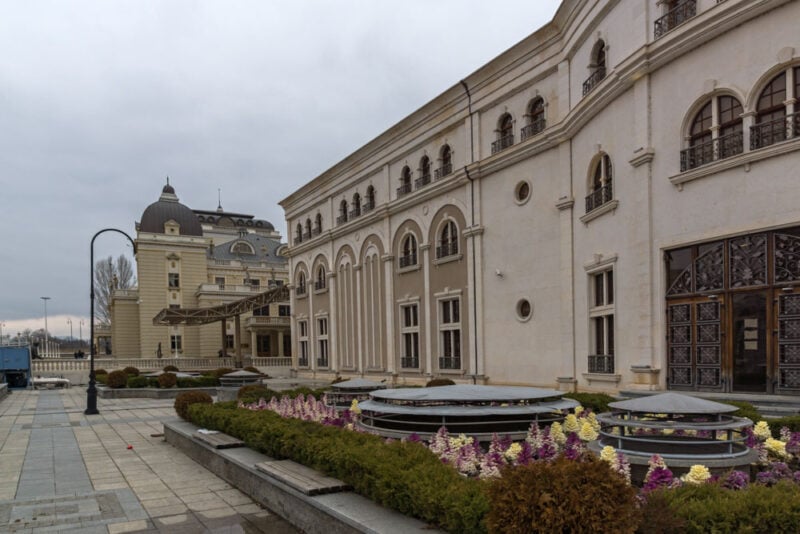
For a cultural evening you’ll never forget, grab tickets for the Macedonian National Theater . One of the best things to do in North Macedonia at night, a couple of hours spent at the theater will leave you with memories you’ll want to hold onto forever.
The theater hosts loads of dramatic theatrical and operatic performances throughout the year. There are two separate areas, one with 724 seats for large performances and one with just 213 for mono drama and chamber performances. As long as you don’t mind the language barrier getting in the way a little, you’re guaranteed to have an excellent night.
Even if you don’t have time to see an actual show, the theater is worth visiting just for the architecture. It looks phenomenal after dark when every inch of the grandiose building is illuminated by carefully placed lights that create playful shadows.
25. Get Tipsy on Rakija

When your trip is coming to an end, it’s time to say “Cheers!” with rakija . This drink is hugely popular throughout the Balkans, but it’s particularly loved and enjoyed by people in North Macedonia.
Rakija is a type of Macedonian brandy that is usually enjoyed straight before or after dinner. It has a wonderfully warm and rich flavor, which makes it perfect for the winter months. At this time of year, it’s usually mixed with sugar and gently heated up.
What makes rakija special is that it’s not just something locals drink for pleasure or to toast with on special occasions. Ordinary people make gallons of the stuff and keep it in their homes to ease sore muscles, alleviate cold symptoms, and help with sore throats. Many local people also believe rakija can kill viruses and bacteria, so they use it to keep their homes clean and to disinfect wounds.
Knowing all this, you may find it difficult to order yourself a glass. But after the first sip, you’ll be hooked and won’t want to drink anything else for the rest of your vacation!
There you have it! The 25 best things to do in North Macedonia. What’s your favorite thing to do in North Macedonia?
Planning a trip to North Macedonia? Check out our favorite books and travel guides!
SHARE THIS ON PINTEREST
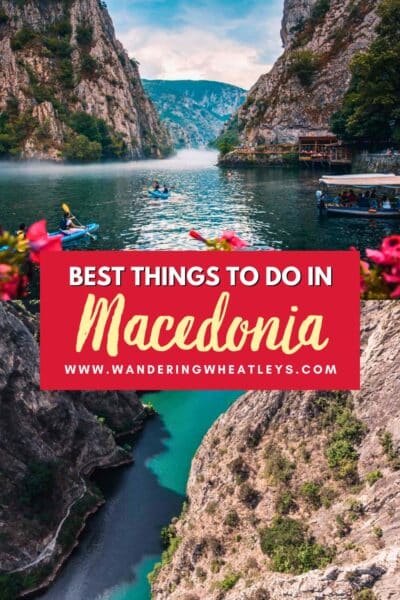
Nicola is a freelance writer with an insatiable hunger for travel. She swapped her home in the UK for the sunny Canary Islands when she was just 11 and she has been based there ever since. From crawling on her hands and knees inside pyramids in Egypt to swimming with baby sharks in Bali and searching (fruitlessly!) for the Northern Lights in Iceland, Nicola takes every chance she gets to explore new places. The incredible experiences she has around the world fuels her writing and inspires her to plan even more adventures for the future.
Related Posts
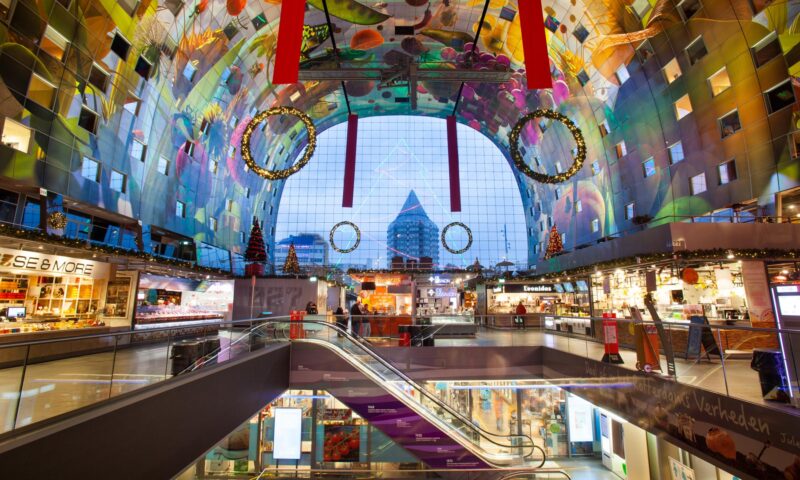
The 15 Best Things to do in Rotterdam, Netherlands
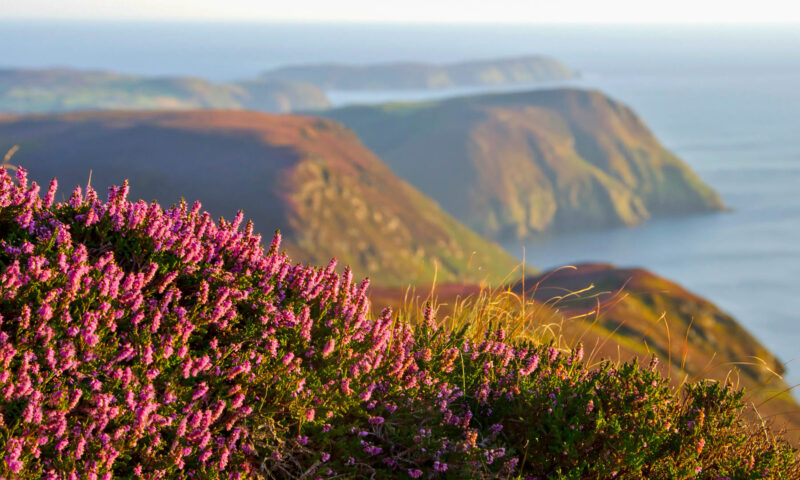
The 12 Best Hotels in the Isle of Man
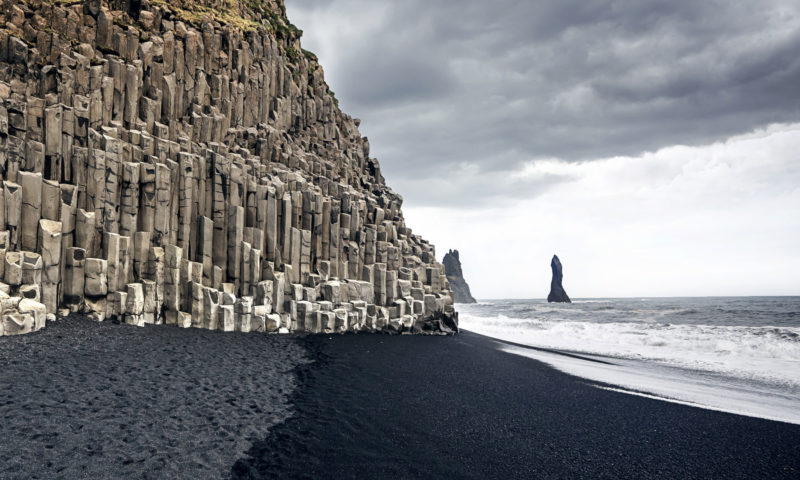
The 12 Best Boutique Hotels in Iceland
Leave a comment cancel reply.
Your email address will not be published. Required fields are marked *

The Budget Savvy Travelers
BREAKING FREE WITHOUT BREAKING THE BUDGET
Home » Macedonia – 10 Reasons Why You Must See This Country Right Now!
Macedonia – 10 Reasons Why You Must See This Country Right Now!
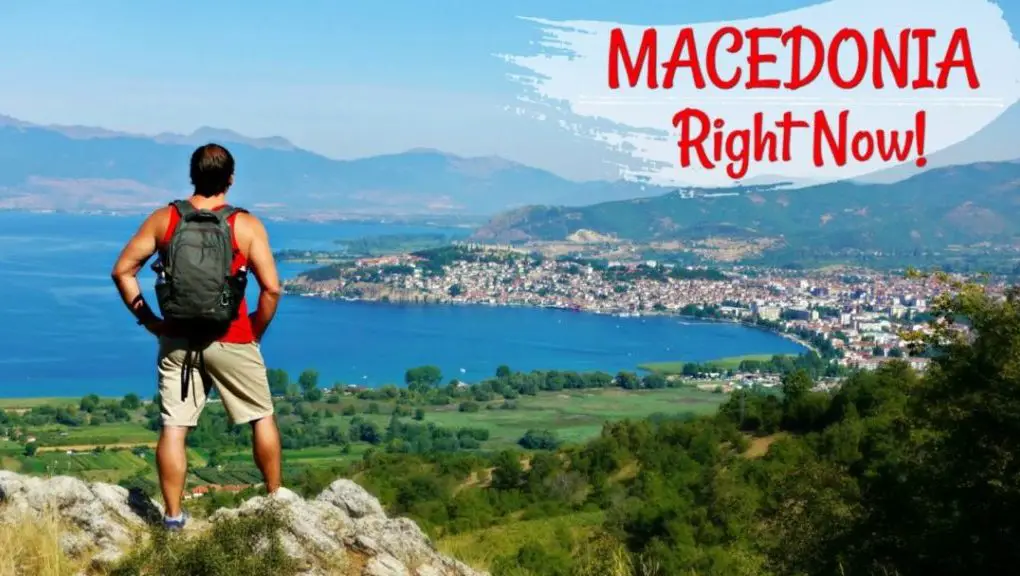
Looking for the ultimate inspiration for visiting the country of Macedonia? There’s never been a better time to visit Macedonia. The country has so much to offer, but it seems like much of the world doesn’t realize it yet.
After two months of exploration this summer, we’re excited to share more about why we fell in love with this country.
Where to Stay in Skopje
There are several excellent hotels in the Skopje city center. However, during our visits, we typically stayed in apartments.
Most tourists will enjoy staying near the city center within walking distance of the main attractions. Nevertheless, our favorite neighborhood is Debar Maalo, about one mile west of the city center. Also, double-decker red buses make it easy to get around the city.
As slow travelers, we enjoy staying in residential areas to experience more of a local experience. On average we paid around USD 25 per night for long-term rental apartments . Tourists staying for a few nights should expect to pay USD 50 to 100 per night in the city center.
Below are some accommodation recommendations for travelers in Skopje.
Budget : Hostel Mickitos , (a popular hostel located in the heart of the city), Hostel Denica (a newer hostel) Mid-Range : The ONE Luxury Suites & Apartments (luxury apartments in the heart of the city), Urban Hostel & Apartments (clean accommodation near the main bus station) Luxury : Capital Suites (highly-ranked hotel outside the city center), Marriott (located in Skopje’s main square)
Feeling Adventurous ? Pick out your accommodation 👉 here .
Top-6 Tours in Macedonia
- 🚤 Enjoy a half-day tour from Skopje to Matka Canyon and Vodno Mountain.
- 🍷 Go on a wine tasting and tour at St. Cosmas and Damian Monastery.
- 🏊 Journey south from Skopje to Ohrid on a full-day tour of the lake town .
- 🚵 From Ohrid: Go ATVing in National Park Galicica on a full-day adventure.
- 🚙 Take a day trip to Kosovo and tour the cities of Pristina and Prizren.
- 🚶 A professional guide will walk take you to all of the important landmarks in Skopje and share the history of the country during this two-hour private walking tour .
You Must See Macedonia Right Now!
Here are 10 reasons why you should consider adding Macedonia to your next trip itinerary.
1. Overwater Bungalows
Is this Tahiti? The Maldives? No, it’s Macedonia! On the shores of Lake Ohrid, visitors can visit one of Macedonia’s most visited museums. These picturesque overwater bungalows are part of the Bay of Bones Museum .
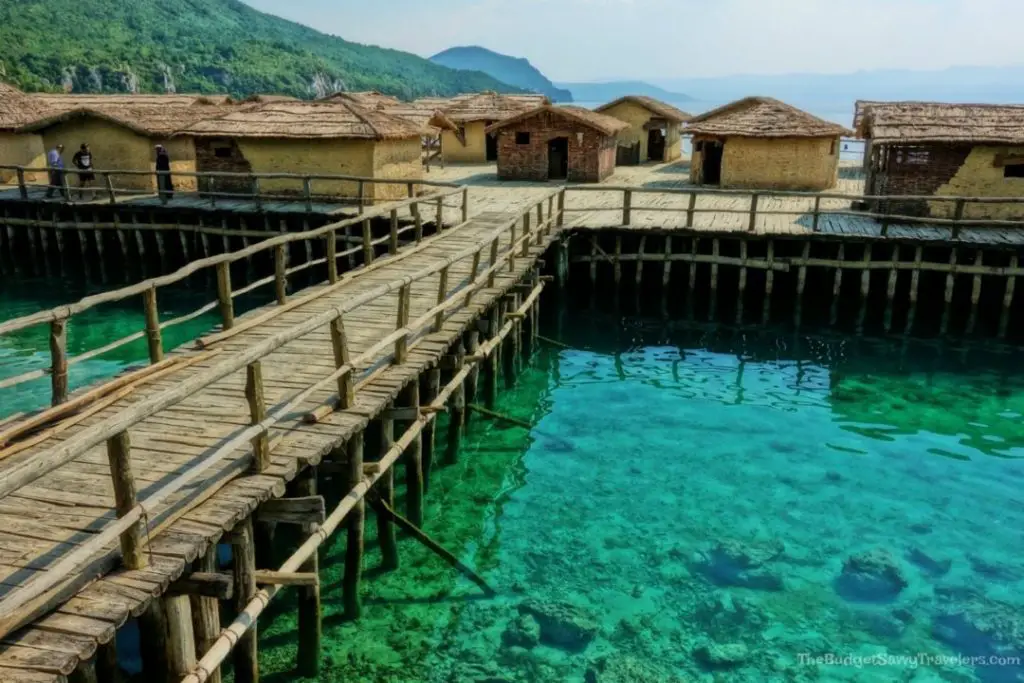
The attraction is a speculative recreation of a prehistoric settlement, dating from 6,000 to 8,000 B.C. The staged over-water huts replicate the living conditions of the people who once lived here. With the overwater huts perched above the turquoise-colored water, it almost looks like a scene straight out of the South Pacific.
This is the Ultimate Ohrid Excursion : ATV Full Day Adventure through National Park Galicica
2. Still Distinctly European
One of the reasons we loved Macedonia was the fact that it still felt distinctly European. For us, the melting pot cities of London, Rome, and Paris have lost their appeal because it feels like we are simply visiting any major city in the United States. Without the touristy crowds, visitors can soak up the ambiance of these timeless, quaint cities and enjoy the essence of pure European charm.
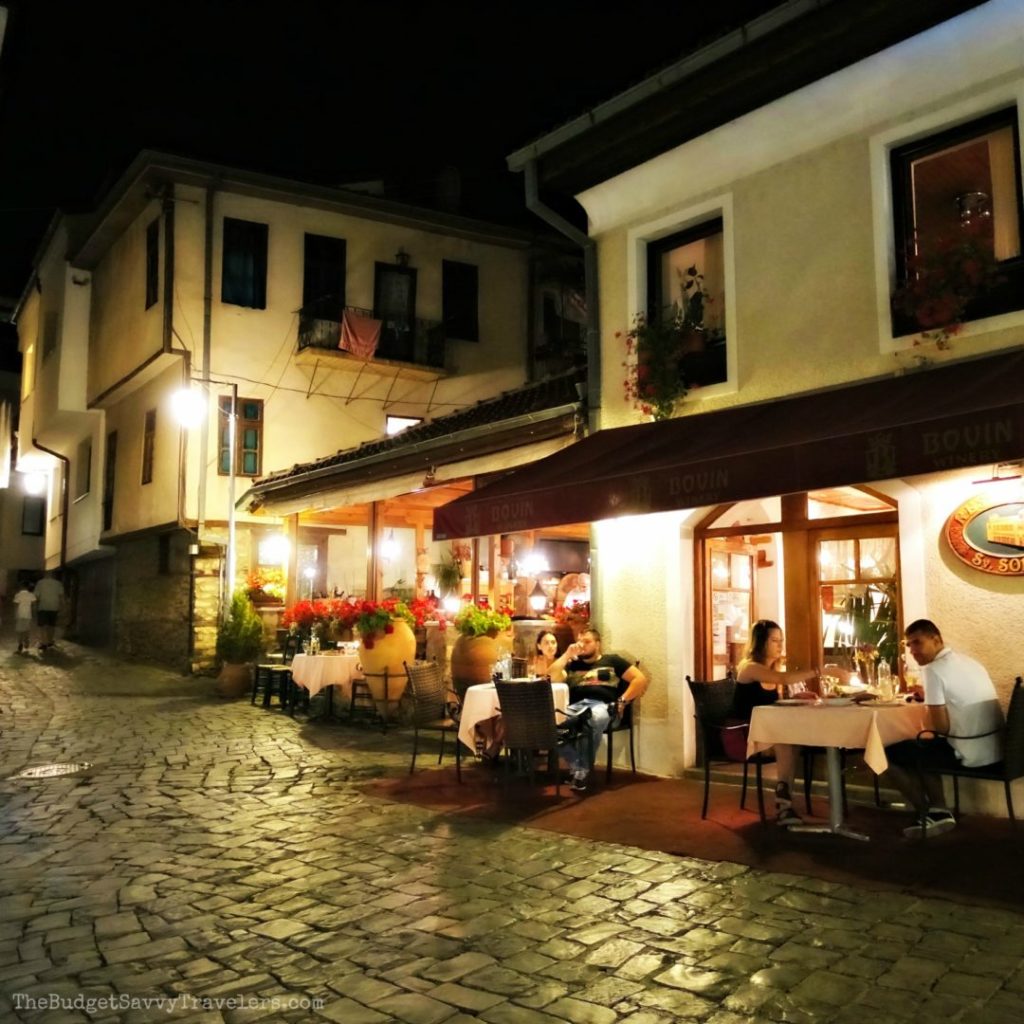
3. The Weather
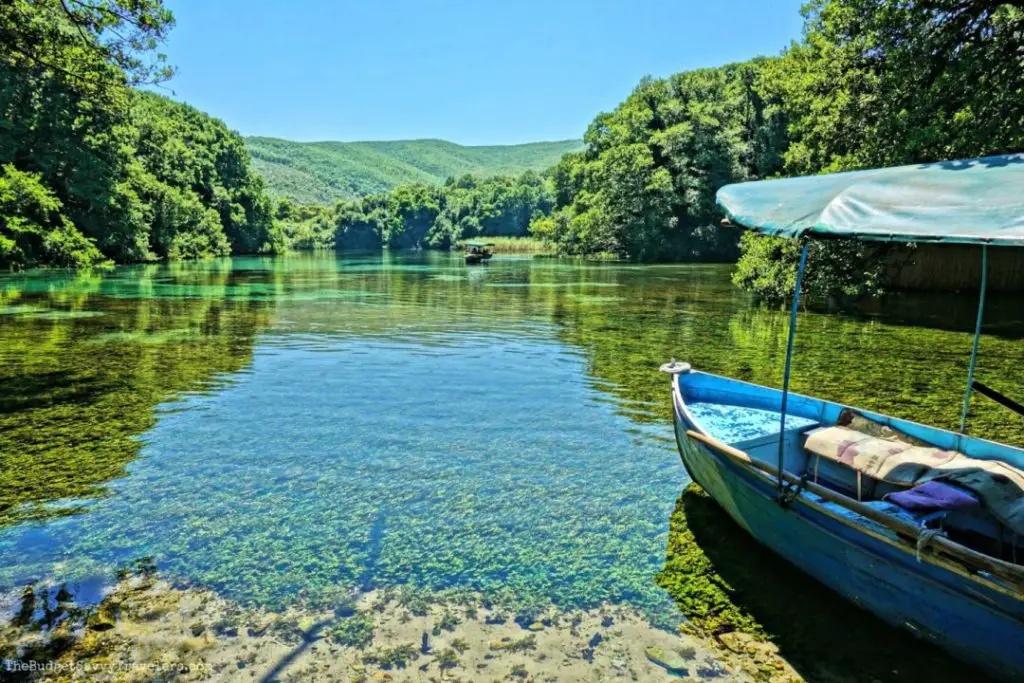
Macedonia has some pretty fantastic summertime weather. Typically from May through October, the weather is warm and dry. In fact, in the two months, we toured the country we only encountered one full day of rain. This makes for sunny, blue skies that are perfect for photography, swimming, and enjoying outdoor activities.
Most Popular Tours in Ohrid
- 🏞️ Discover the UNESCO-listed landscapes of Lake Ohrid on this private tour and explore the entire lakeside in one day
- 🚢 Cruise along the historical part of Ohrid and taste 4 samples of fine authentic wines in unlimited quantity, in an intimate atmosphere with beautiful surroundings
- 🏍️ Experience the lush landscapes of Macedonia as you explore Galicica National Park on an exciting ATV tour
- 🚶 Embark on a walking tour of the Old Town and discover the city’s main attractions with a private tour guide
- 🪂 Take this Paragliding Flight above the Ohrid and surround yourself with breath-taking Mountain and Lake Views
4. Living Lake Life
Although Macedonia is a landlocked country, it has an amazing body of water. In the summer, Ohrid comes alive with tourists and Macedonians seeking out a taste of lake life. Lake Ohrid is Europe’s oldest and deepest lake.
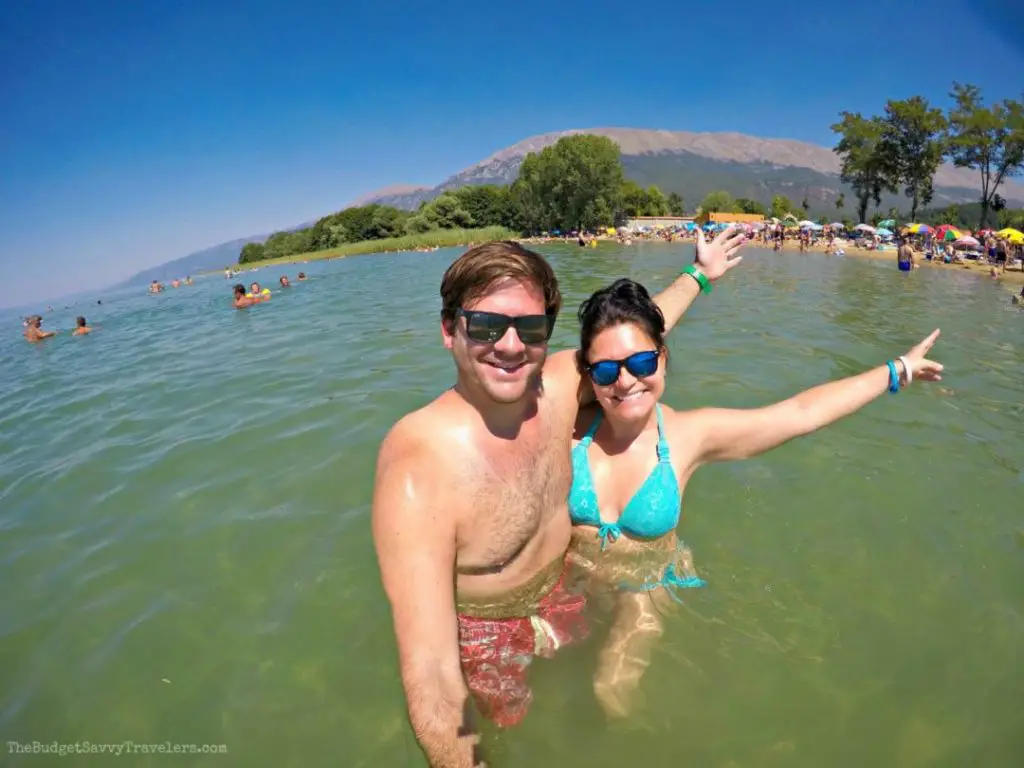
The lake water is astonishingly clean, clear, and a perfect temperature for swimming in the summer. The charming resort town also has great nightlife, outdoor adventures, and delicious local cuisine to ensure the perfect summer getaway.
5. It’s a Foodie Haven
As travelers, we love the flavors and cuisine of Macedonia. Generally, the dishes are hearty, full of protein, but never too heavy on the stomach. Popular meals include meat and vegetable platters, fresh salads, stuffed peppers, and cabbage rolls. In Ohrid, belvica is a lake fish and a local delicacy.
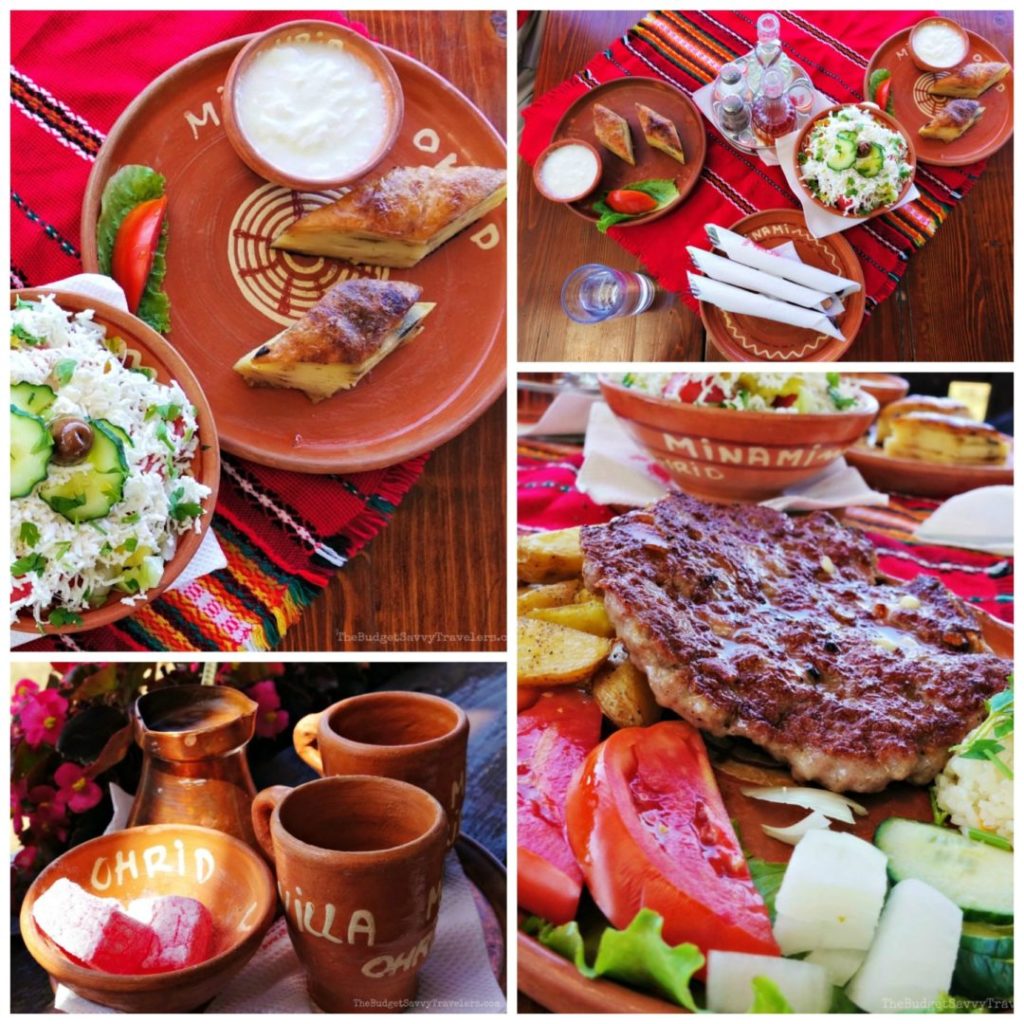
However, our most memorable dish was a meaty stew called chorba. In Ohrid, it is widely served with a homemade garlic dressing and fresh bread. It was phenomenal.
6. Best Wine of the Balkans
As red wine drinkers, we reveled in the fact that 80 percent of Macedonia’s wine production is red. The sunny, dry climate is the perfect environment to produce full-bodied, fruity red wines. The earliest archeological excavations revealed that Macedonia has been growing grapes and producing wine since the 13th century B.C.
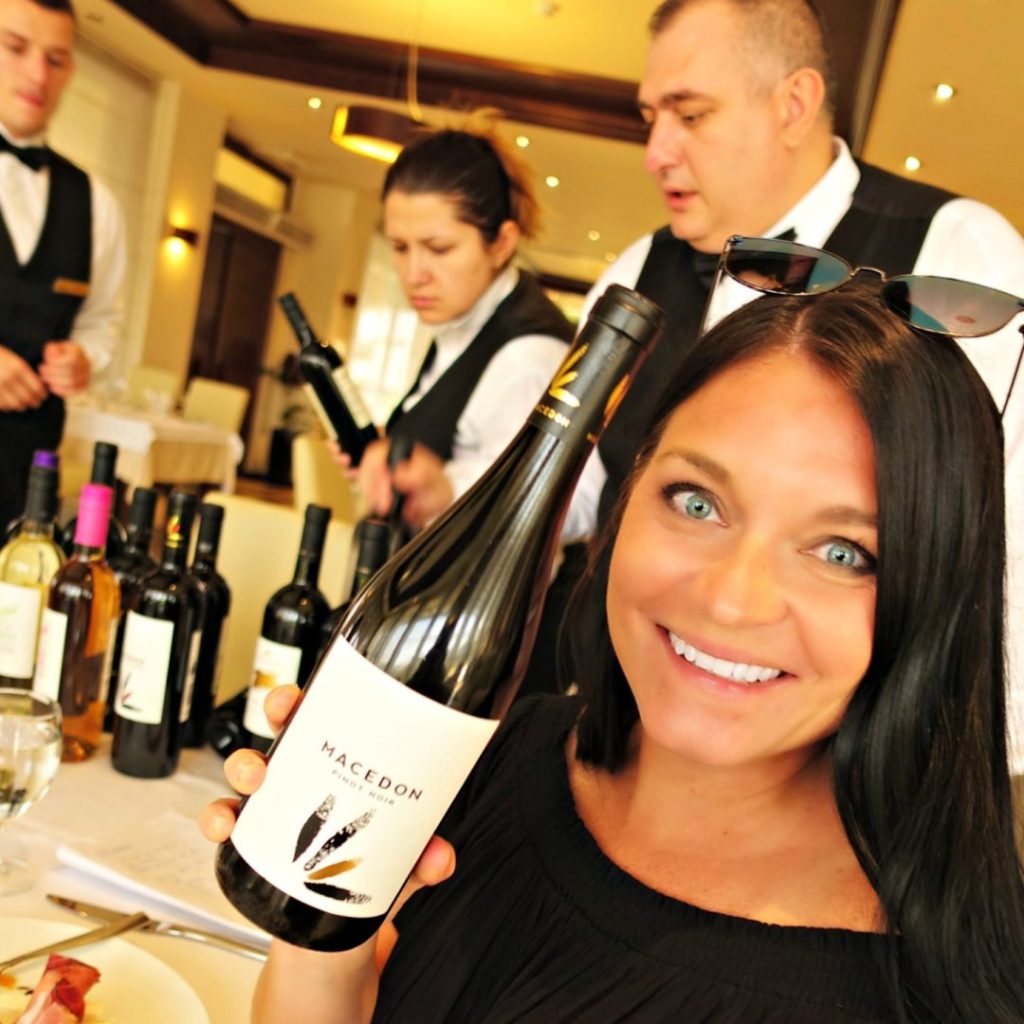
With thousands of years of wine production, the region has perfected its craft! Those interested in visiting Macedonian wine country will find an elegant, yet unpretentious wine region richly laced with both ancient and familial history.
7. Sweeping Mountain Views
Macedonia’s mountainous terrain is a hiker’s dream! For those that get all the feels from dramatic landscapes, then you’ll love exploring this rugged country. Cities like Prilep and Ohrid even offer hiking opportunities right outside the front door. The mountain trails are easily accessible and there’s no need to hire a costly rental car.

8. Magnificent Roman Ruins
Travelers that enjoy exploring Roman ruins will love touring Macedonia. The country has spectacular ancient cities that are often wonderfully quiet and serene. Two of the more popular sites are Heracela just outside Bitola and the Ancient City of Stobi .
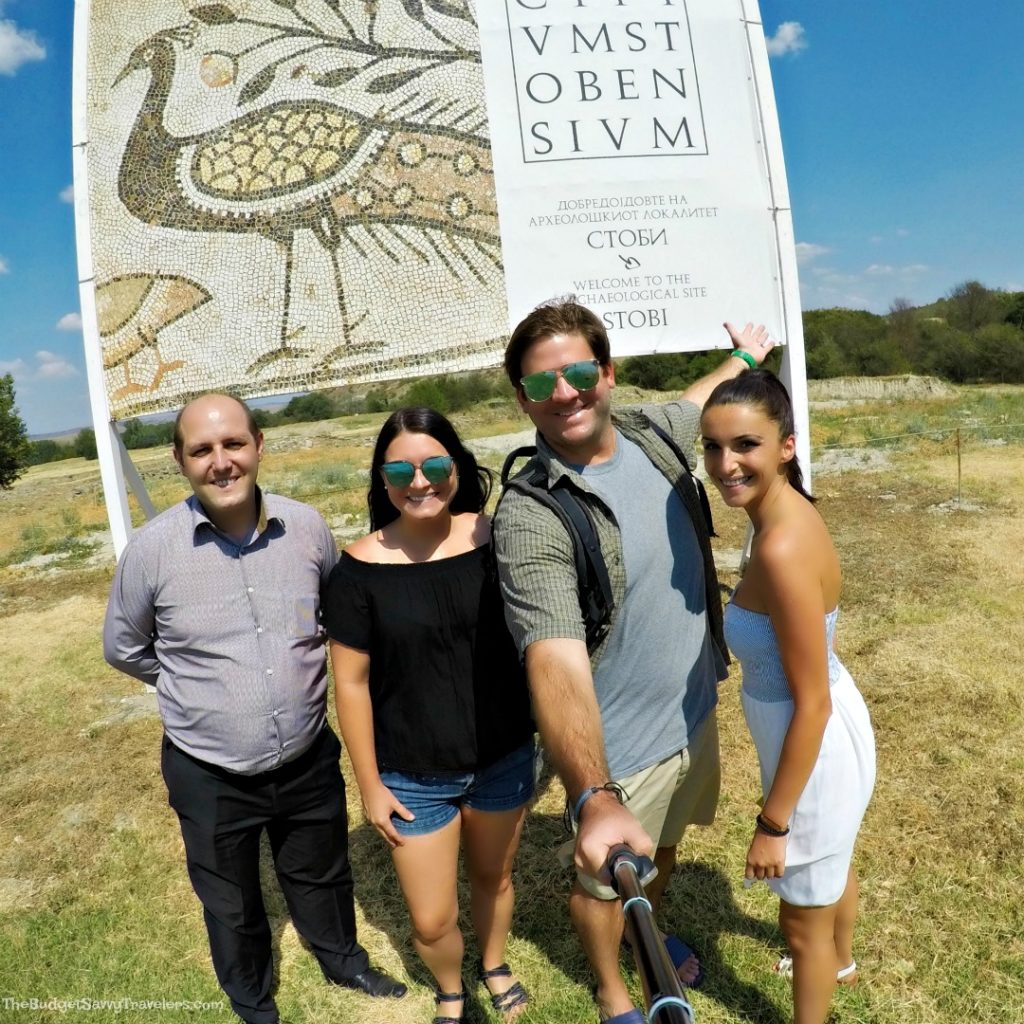
These locations boast some of the most beautiful, detailed tiled mosaics ever found in an archeological excavation. Why fight the crowds in Greece and Italy when you can have these discoveries all to yourself?
9. Las Vegas of Europe
Travelers have described Skopje as quirky, unique, and unlike any other place they’ve ever visited, so we were intrigued to explore it for ourselves. After visiting Macedonia’s capital city, we deemed it the Las Vegas of Europe.
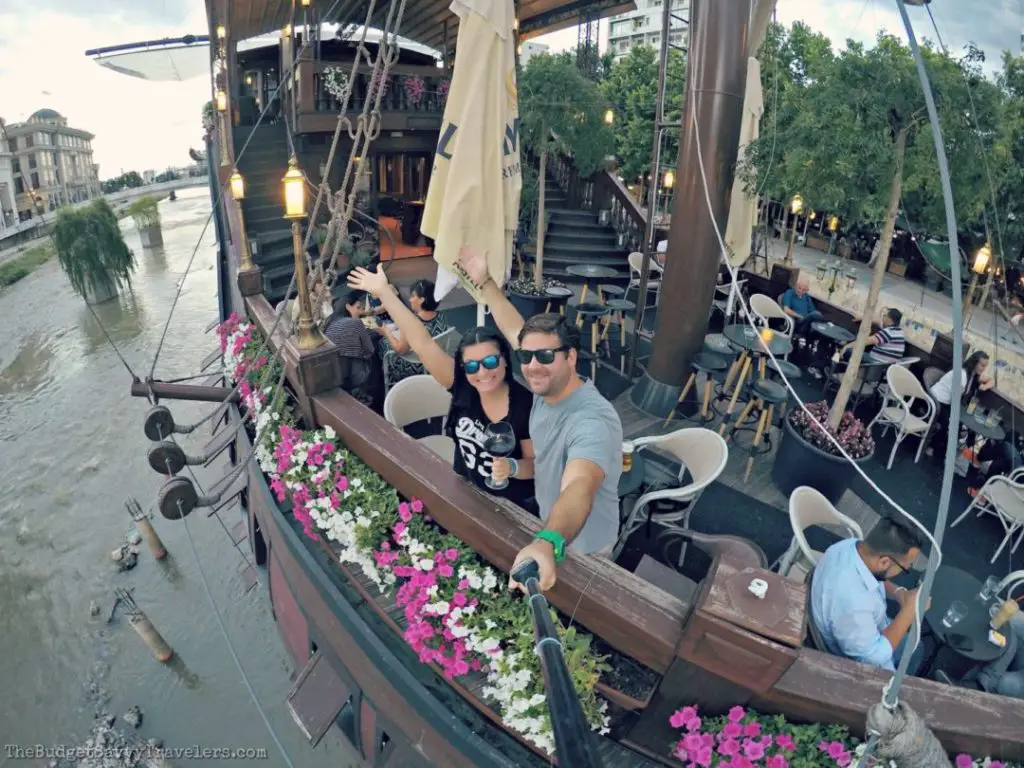
At night, the city center comes alive with activity. The massive statues, colossal buildings, and pirate ships along the Vadar River give off Las Vegas vibes. There is so much to visually process, it’s a city to awaken the senses.
10. Few Crowds and Tourists
Macedonia feels like it is just on the brink of becoming an emerging tourist destination. Outside of Lake Ohrid, we received lots of curious stares and questions from locals wondering why we were in their country. In fact, Macedonians seemed genuinely surprised when we told them how much we were enjoying our tour.
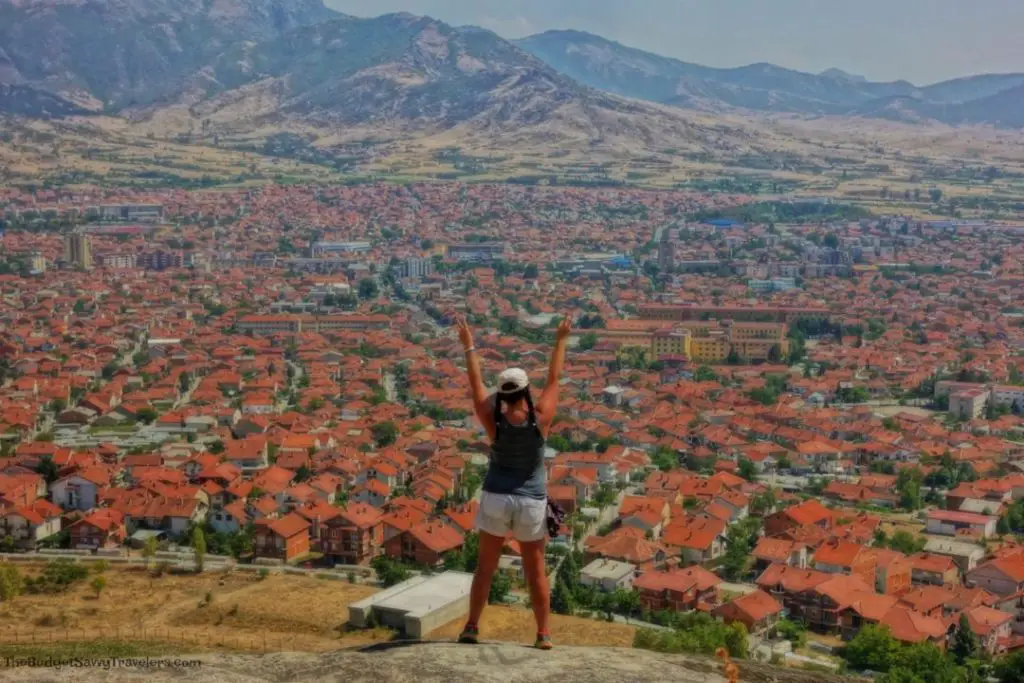
This is the route we took to explore Macedonia .
Truth be told, mass tourism hasn’t ruined travel in Macedonia yet. Locals are warm, welcoming, and friendly. Also, prices are extremely affordable and attractions are often uncrowded. As a result, if you enjoy getting off the beaten path then Macedonia is a great country to explore.
TRAVEL TIPS
🏘️ Book Your Accommodation
We use Tripadvisor and Priceline’s Express Deals to compare prices and reviews in advance and check availability
✈️ Book Your Flight in Advance
To find the cheapest flight options, you can use WayAway and Skyscanner to find the most suitable choice for you
🚗 Reserve Your Rental Car
Use DiscoverCars and Skyscanner to compare prices and view the largest selection of vehicles
- ← How to View the Chest of Saint Simeon in Zadar, Croatia
- Mali Losinj Croatia Travel Guide and Itinerary →
Similar Posts
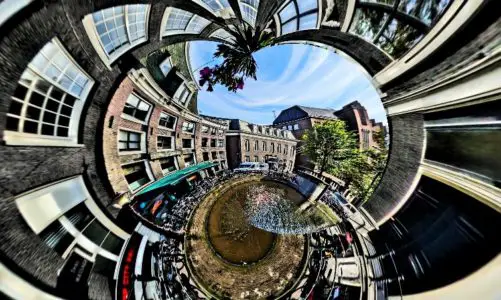
How to Get Free Marijuana in Amsterdam – Right to Your Door!
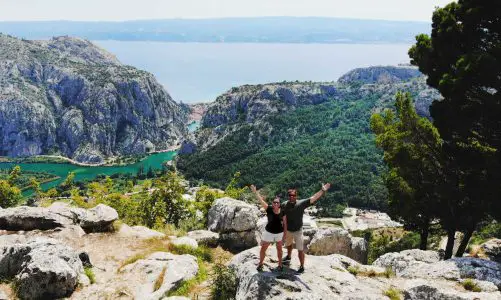
How to Move to a Different Country and Start a New Life
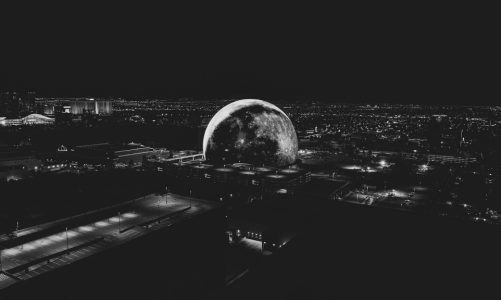
Londoners Agree – They Want the London Sphere
Leave a reply cancel reply.
You must be logged in to post a comment.
- TRAVEL ARTICLES
- BOSNIA AND HERZEGOVINA
- GEORGIA-SAKARTVELO
- GREAT BRITAIN
- NETHERLANDS
- MASSACHUSETTS
- NORTH CAROLINA
- PENNSYLVANIA
- SOUTH CAROLINA
- PHILIPPINES
- SAUDI ARABIA
- UNITED ARAB EMIRATES
- REPUBLIC OF THE CONGO
- SOUTH AFRICA
- AMERICAN SAMOA
- COOK ISLANDS
- NEW ZEALAND
- DOMINICAN REPUBLIC
- PUERTO RICO
- TIPS, TRICKS, AND BUDGET-SAVVINESS
- FIRST 6 MONTHS
- MONTHS 7-10
- MONTHS 11-15
- MONTHS 16-18
- MONTHS 19-24
- PROJECTED ROUTE
- LATEST VLOGS
- EPISODE 1-5: BUENOS AIRES, ARGENTINA
- EPISODE 6: URUGUAY
- EPISODE 7: ANTARCTICA
- EPISODE 8: PATAGONIA
- EPISODE 9: SOUTH AMERICAN WINE COUNTRY
- EPISODE 10: THE COOK ISLANDS
- EPISODE 11: NEW ZEALAND AND AUSTRALIA
- EPISODE 12: INDIA
- EPISODE 13: BORNEO
- EPISODE 14: THAILAND
- SPONSORED CONTENT
- WHY DID WE QUIT OUR JOBS TO TRAVEL?
- OUR PAST TRAVELS
- HOW CAN YOU HELP?
North Macedonia
Geographically and historically there is much more to North Macedonia if you veer off the tarred and hardened road, and you will only ever be rewarded for taking the bumpy side track. Thammy Evans , author of North Macedonia: the Bradt Guide
Long buffeted by the struggles of the Balkan Peninsula, North Macedonia is emerging as one of the most entrancing corners of Europe. A captivating blend of the ancient and the brand new, the country’s crumbling mountain monasteries and rustic hostelries are as much a part of its charm as its excessive new monuments and nascent boutique vineyards.
Sip heady cocktails beside the crystal-clear waters of Lake Ohrid, immerse yourself in Skopje’s burgeoning café culture or discover the hidden hot springs dotted around the country, all of which make North Macedonia a traveller’s tale like no other and worth more than just a pit-stop on a trip to somewhere else.
Food and drink in North Macedonia
Macedonian cuisine combines simple, healthy, Mediterranean cooking with centuries of spicy Ottoman influence. It is a celebration of fresh, organic, small-scale produce, and its wine is traditionally made with no sulphites. Summer markets teem with good local fruit and vegetables, while the winter holds crisp pickles ( turšija ) and jars of tasty red pepper spreads. Restaurants are getting better at offering some of the delicious domašni (home-style) dishes, but outside the main towns simple restaurants might only serve grilled chicken breast or pork chops and a few basic side dishes. Like most of continental Europe, Macedonians have a tradition of going out to eat, and with their children. So you’ll find many places (fewer in Skopje) are very child friendly.
Macedonian meze (from the Turkish, and ultimately Persian maze ; also known as ordever , literally ‘hors d’oeuvre’) is the best-kept secret of Macedonian cuisine. Usually served at the start of a banquet, meze is so tasty and varied that it can make a whole meal on its own. The Macedonian meze are a variety of cold ‘creamed’ vegetable spreads, initially cooked till soft and then hand blended with herbs and spices, onions and garlic, and doused with not too much oil. The most common are ajvar , pindžur (roasted aubergine and peppers), tarator (yoghurt, cucumber, walnuts and garlic), kajmak (a type of clotted cream, often mixed with hot chillis and potatoes), egg and mushroom, and sweet grilled red peppers doused in garlic and oil (the latter usually only available in late summer). Eaten with pitta bread, sarma (stuffed vine leaves), local cured ham, Parmesan and a strong local drink like mastika or rakija , it is a real treat.
The most famous of these meze is ajvar, made every autumn when red peppers are at their most abundant. The best, of course, is homemade ( domašni ). To be invited into a Macedonian home to make ajvar is quite a privilege (some say it is like being offered the possibility of citizenship), and will give you an idea of the meticulous preparation that must go into preparing this Macedonian speciality.
The main fare of any Macedonian meal is either meat or freshwater fish. Lamb is the most expensive and therefore not often served in cheaper restaurants. It comes roasted either in the oven or on a spit, and served in a big chunk on your plate, usually without rosemary, never mind mint. Otherwise the staple meat dish for most Macedonians is skara: plain grilled pork or chicken, usually salted and basted. Skara is so popular that you can buy it from street stalls by the kilo! Veal ( teleško meso) , beef, eel ( jagula) , stroganoff, thinly sliced garlic liver ( džigr) , schnitzel, fresh pork ribs ( svježe rebra ), pork chops ( kremenadle) and skewered kebabs ( ražnič ) are also prolific. Kebapči are an extremely popular form of skara, a Balkan speciality of small sausage-shaped burger meat, well seasoned and very tasty with a beer and some good bread. Other popular traditional meat dishes are stuffed peppers, pork knee joint and selsko meso (village meat), which is a stew of different meats and sausages in an earthenware pot. Makedonsko meso is a variation of this with North Macedonia’s famous capsicum peppers.
Freshwater fish, either trout or carp ( krap in Macedonian), is abundant in North Macedonia. Ohrid is most famous for its letnica and belvica trout, and Dojran for its native carp. These particular fish varieties are peculiar to the lakes and cannot be found outside North Macedonia, and for this reason (among others) Ohrid is protected under UNESCO. Sadly, Ohrid trout, which has been caught in the past at over 20kg in weight, has been over-fished and this is not helped on the Albanian side of the border by lakeside boys selling trout by the bucketful. You may, therefore, want to think twice before partaking too often of this famous and increasingly rare Ohrid dish. It is now illegal to fish for Ohrid trout.
Fresh salads in North Macedonia, especially outside Skopje, are not very inventive. Your four main choices are a green salad (lettuce); a mixed salad (cucumber, tomato, grated cabbage and carrot); a Šopska salad (cucumber, tomato and grated white goat’s cheese); and Greek salad (cucumber, tomato, cubes of feta cheese and maybe some olives). Vinaigrettes and salad dressings are almost unheard of, so don’t expect a choice of thousand island dressing, blue cheese or ranch, or even salad cream. There is usually olive oil and vinegar served alongside and balsamic vinegar available in Skopje.
The art of breakfast is slowly coming to North Macedonia and traditionally consists of a strong coffee before work possibly with bread and cheese or jam, and at the weekends juvki or tarama (a cereal-based baked dish), then a break at around ten for a gevrek or kifla (sesame bread ring) and plain drinking yoghurt or ajran before settling down for a long lunch around 14.00. In Skopje, bakeries serving delicious pastries are becoming common, but outside the capital it is wise to make sure you have breakfast included in your hotel bill, or buy something in, as you’ll find few places on the streets that will serve you anything to eat. In Ohrid you can get sweet and savoury muffins, including proja (corn muffin with spinach) at Dva Biseri café from 08.00 in the morning.
If you’re a vegetarian, travelling in North Macedonia need not be too difficult although you’ll probably have had enough of meze, turlitava, tavče gravče and pohovani kromid (breaded onions) by the end of your stay. If you’re a coeliac, then your time might be more difficult as rice dishes and chips are usually served everywhere. You might want to make sure you ask for everything bez leb in order to avoid the waste of ubiquitous bread.
The preferred drink in North Macedonia is coffee, either the strong Turkish variety which is a challenge to drink without sugar, served in espresso-size cups, or the usual cappucinos, machiattos and espressos. Turkish tea, served in small glasses, is popular in Albanian areas, and you’ll sometimes see servers on bicycles or rollerblades carrying trays of them through the streets to customers. Fruit tea is usually considered a drink for the sick, but don’t be deterred! North Macedonia has lots of fruit teas ( ovošen čaj ) and mint tea ( čaj od nane ), and their mountain tea ( planinski čaj ) is a refreshing drink served in all the mountain huts and many restaurants. Majčina dušica (mother’s little soul) tea is also a very popular tea of wild thyme. And beware the hot chocolate – it is often a filling warm chocolate mousse served in a cup!
Salep , a drink made of ground wild orchid root and hot milk, is of Turkish origin and usually served with a sprinkling of ground cinnamon. You won’t find it everywhere, but it’s very tasty and warming on a cold winter’s day. Another Turkish drink plentiful in B vitamins and carbohydrates is boza , a thick tart drink made from slightly fermented wheat (4% alcohol content) whose origins go back to Mesopotamia and it came to North Macedonia with the Ottoman Empire. Available in ice-cream parlours and sweet shops, it is also good mixed with blueberry juice ( borovnica ).
Health and safety in North Macedonia
Make sure you get health insurance that is valid for North Macedonia before arrival, unless you are prepared to pay for any mishaps yourself. Macedonian doctors and hospitals expect to be paid in cash on the spot by foreigners seeking treatment, and once furnished with your receipt, appropriately translated, you can reclaim your money back from your insurer. Most travel agents abroad will be able to sort you out with the appropriate health insurance, and some give a good deal, combining health and travel insurance with insurance against theft.
It is usually a good idea to get any treatment that you need before you go travelling. Compared with some countries, medical treatment is cheaper in North Macedonia than in, say, the US, and standards can be as good as at home. Most doctors speak English. Nevertheless, it is always more comforting to get treatment at home.
Common illnesses can be treated in North Macedonia by the pharmacists in any local pharmacy ( apteka ). Many have English-speaking staff, and they can also advise you of the nearest family practitioner if you are in need of a doctor. If you need hospitalisation, this is best left till you get home, unless it is an emergency, in which case either call 194, or it may be quicker to get a taxi to take you to the nearest hospital ( bolnica ). In Skopje, City Hospital (Gradska Bolnica), the red-brick building on 11th Oktomvri opposite the parliament, deals with all emergencies requiring anaesthesia. The emergency outpatients’ entrance is around the back. There are several 24-hour pharmacies in big towns. In Skopje there is one on Dimitri Čupovski between McDonald’s and the traffic lights.
The security situation in North Macedonia has calmed down significantly since the end of the hostilities of 2001 and foreigners have never been a target. In fact, you are undoubtedly safer in North Macedonia than you are in most major Western cities, from both theft and terrorism.
To be on the safe side, avoid areas known to be unsafe and large public demonstrations which may get heated. The website of your embassy in North Macedonia will usually carry the most up-to-date information on the security situation, and the US embassy site also has comprehensive security and safety advice on their Consular Information Sheets at www.travel.state.gov . Many embassies advise their citizens to register at the embassy if they intend to stay in the country for any length of time, and to phone for the latest security advice on a particular area if they are going off the beaten track.
Female travellers
Sexual harassment is not usually a problem in North Macedonia, and women here dress as skimpily as in the West. Macedonians think it is a bit strange, however, to travel on your own, especially as a woman; and keeping in mind the high level of trafficking in women which has gone on in North Macedonia in the past, you’d better have your wits about you if you travel alone as a woman in out-of-the-way places after dark. There are no obvious red-light districts in North Macedonia, as prostitution is illegal, but there are bars and hotels and parts of towns that service this trade.
As with anywhere in the rest of the world, if you are a single female driver and an unmarked police car indicates that you should pull over, you should turn on your hazard lights and drive slowly to a public area such as a petrol station before stopping. You could also phone the police on the number: 192 to check if the police car is genuine.
LGBTQ+ travellers
The gay and lesbian scene is very limited in North Macedonia and it would be considered most strange if not offensive for same-sex couples to walk hand in hand down the street, never mind kiss in public. Booking into a hotel would not be considered so strange unless you insisted on a ‘ francuski krevet ’ (double bed), as double rooms normally come with twin beds.
When being gay was decriminalised in 1996, the gay community in North Macedonia cautiously took steps to promote greater acceptance. That trend has ground to a halt over more recent years, however, and LGBT United Macedonia is currently one of the only organisations in Skopje working on gay and lesbian issues. There are currently no venues openly welcoming gays and lesbians in North Macedonia, although private parties in some public venues do take place.
Travelling with children
Visitors to North Macedonia will quickly realise that the country is very accommodating towards children. Macedonian attitudes towards children are tolerant and relaxed and Macedonians themselves are exceptionally welcoming to families with children. Safety standards will not be up to US litigious culture, but costs are low, making a family holiday less of a shock to your wallet.
Travel and visas in North Macedonia
Nationals from neighbouring countries, Australia, Canada, the EU, Iceland, Israel, New Zealand, Norway, Switzerland and the US, among others, do not need visas at present for stays of less than 90 days within a six-month period starting from the day you first enter the country. Nationals of Japan, Montenegro and Turkey can enter visa-free for up to 60 days in a six-month period. For those who do require visas, these can be obtained through any Macedonian embassy abroad, a full list of which is maintained at mfa.gov.mk . For an up-to-date check on which nationals do require visas, visit macedonia.visahq.co.uk . Visa requirements tend to change with a change of government, so keep this in mind. Your passport will need to be valid for at least six months beyond the end of your visa. If you wish to change your status in the country from one of short business trip or holiday to one of temporary residence, this can only be done back in your home country through your country’s Macedonian embassy. The US Embassy in North Macedonia has a good webpage on the requirements of foreign stay in North Macedonia.
Getting there and away
Low-cost airlines serve Skopje throughout the year, though the volume of flights increases in summer. Most regional public transport users travel by the frequent and cheap buses to North Macedonia as the train is slow and decrepit. Aside from the car option, and if you are thinking of walking in, make sure you enter at a designated border crossing.
For daily flight times in and out of North Macedonia see www.airports.com.mk . At the time of writing, Wizzair is the only airline offering direct flights to Skopje from the UK (London Luton). Wizzair and Pegasus (via Istanbul) are the only budget operators flying to Skopje, the latter from London Stansted, as well as from Istanbul. A Wizzair flight from London can cost as little as £20 one-way (though the return portion is often significantly higher and, as with all so-called budget airlines, checked-in luggage brings the price of a ticket up steeply).
In the summer a few airlines also fly direct to Ohrid’s St Paul the Apostle Airport, including from London Luton, Vienna and Zurich.
Various other airlines which also operate flights to the UK fly direct to Skopje from continental Europe (for example Croatia Airlines from London via Zagreb, Swiss from London via Zurich, Alitalia via Rome). The alternative to expensive flights into Skopje is to look at neighbouring airports such as Priština, Sofia or Thessaloniki for cheap deals and then take the bus.
There are only three international trains to North Macedonia. The daily overnight service from and to Belgrade takes 9 hours, which is ludicrously slow and you would be much better taking the 4-hour bus service. The daily service from Priština leaves Skopje mid-afternoon and departs Priština early in the morning, and the 2½-hour journey spends 40 minutes at the border changing engines. The train is well used on the Kosovo side, but few use it on the 35-minute Macedonian passage. If you get stuck at Blace border on the way to Skopje, then it is only a 20-minute walk to the road crossing where you can pick up a taxi to Skopje for 900MKD. There’s also a daily service to Thessaloniki (Solun), which takes 4–5 hours from Skopje.
Due to the lack of cheap flights and frequent comfortable trains, North Macedonia is well served by international-standard coaches, especially to and from Germany and Switzerland. See www.balkanviator.com or www.sas.com.mk for more-or-less complete bus listings. International coaches also serve other locations in North Macedonia, especially between Germany and the northwestern towns of Gostivar and Tetovo. Timetables and price information from some countries to Macedonian are available at www.balkanaviator.com . At the time of writing North Macedonia had yet to put its international coach services on the Eurolines website. There is a left luggage service at Skopje Bus Station.
The easiest and most convenient way to get around North Macedonia is still by car (a 4×4 if you plan to go anywhere off the beaten track). But driving to North Macedonia from the further reaches of Europe, especially places like Britain and Finland, is an extremely long journey – at least three days.
If you do intend to drive from Britain, for instance, a recommended route would be to cross at Calais for a cheap, short ferry journey, drive along the roads of France, which are usually fairly empty although there are road tolls to pay (German roads are toll-free, but packed, and speed restrictions are becoming more widespread), cross the Alps at the Simplon Pass and head for Venice. From here take the overnight car ferry to Durres in Albania, or Igoumenitsa in Greece. Either journey from these ports to Skopje is arduous mountain driving (six hours from Durres via Ohrid, or ten hours via Bitola from Igoumenitsa), but the scenery is fantastic. The drive down through Italy, whilst making the ferry journey shorter, is packed with other drivers, often resulting in traffic jams in motorway scenery. For times and prices of ferries between Italy and the Balkans see www.cemar.it .
Getting around
Buses cover all main routes and are the preferred mode of transport for Macedonians because they’re frequent and cheap, despite the fact that they are not air conditioned and do sometimes break down. Few of them have on-board toilet facilities either, so you may have to wait for the toilet break along the road. For more on bus times and prices, check the following searchable link: www.sas.com.mk/en/VozenRed.aspx.
There are fairly limited options available for travel by train and the number of services has decreased in recent years as most people prefer to use buses, which are faster and leave more regularly. The most important lines run from Skopje to Kičevo via Tetovo and Gostivar (but not Mavrovo and Debar), from Skopje to Bitola via a scenic route through Veles and Prilep, from Skopje to Kumanovo, and from Skopje to Gevgelija via Veles and Demir Kapija. Up-to-date timetables can usually be obtained at www.mzt.mk . Fares are very cheap; the maximum one could pay for a train ride anywhere in North Macedonia would still be under 500MKD for a Skopje–Bitola single ticket.
North Macedonia’s roads are currently undergoing a facelift and driving around the country is now a joy, and in fact highly recommended. If you love driving and yearn for the open road with uncluttered vistas and little in your way except for the odd turtle/tortoise or a few goats, then North Macedonia is the place to drive.
There are many places to hire clean, reliable, modern cars in Skopje and other big cities, as well as at the airport. Setkom in the Hotel Continental in Skopje rent out a Kia Rio for as little as €27 per day for a two-week period, making them the cheapest place in North Macedonia for car hire; 4×4 vehicles are also available. You’ll pay about 72MKD per litre for unleaded petrol in North Macedonia, and about 62MKD per litre for diesel.
All taxis now have a minimum fare of 40MKD (50MKD in Ohrid) with a 30MKD/km and 5MKD/minute tariff (40MKD/km and 5MKD/minute in Skopje). It is difficult to take even a short taxi ride in Skopje now for less than 100MKD. Outside Skopje, taxis are still a quick and cheap way to get around town and to places further afield. All official taxis should be metered and carry a taxi sign on the roof of the car. When phoning for a taxi from a mobile phone always add the local prefix before the four- or five-digit taxi number.
Most of the longer journeys outside of the main towns have a fixed price and drivers will often refer to a printed list provided by their company. Make sure you agree the price before taking a longer journey so that you run less risk of being overcharged. For instance, the posted price for a trip from Skopje Airport to the centre of town is 1,220MKD, but most drivers charge 1,500MKD. If you book with a taxi firm in advance they can send a taxi to the airport to bring you into the centre for only 900MKD. They will usually run the meter, then stop the car at the 900MKD point to turn off the meter and continue the journey unmetered.
If you are going to a remote part of town, there’s quite a high chance that the taxi driver taking you there will not know where it is, so you may wish to ask a few drivers until you get one who knows, or make him (there are extremely few female taxi drivers) phone into his radio centre so that they can give him directions. Otherwise they may drive around for a while and charge you the extra time and fuel.
A good, clean and reliable taxi firm, based in Skopje, who can drive you or transport personal items (including pets) on your behalf anywhere in North Macedonia is Lotus Transport.
When to visit North Macedonia
Located so far south in Europe, North Macedonia is great to visit most of the year round. It is particularly welcoming during spring and autumn, outside the high tourist seasons and when the weather is at its most pleasant. It can be warm and sunny during the day from as early as March until as late as November, while skiing is usually available from December through to early April. July and August can be very hot, sometimes getting up to 40°C during the day in Skopje and along the Vardar Valley. This can be particularly unpleasant if taking lengthy journeys by public transport where there is no air conditioning and the local population fears getting ill from a breeze from an open window. The mountains remain pleasantly cool, however, and even Ohrid is relatively quiet midweek in the summer.
North Macedonia has a relatively dry Mediterranean climate with the full array of four seasons, although spring can be quite short, and each season is tempered by the altitude. In the Vardar Valley, Ovče Polje and the lower Pelagonia plains, temperatures are roasting hot in the summer and relatively mild in the winter. Skopjites tend to empty out of the capital during the hottest months of July and August, when temperatures can reach 40˚C. These summer highs are infrequently punctuated by summer storms, but they do occur, especially in the mountains. Favourite summer retreats to the cool and welcoming mountains are Mavrovo and Pelister national parks, Popova Šapka, Kriva Palanka, Berovo and Kruševo. Bitola, a mere 380m above Skopje, is usually a good 10–12°C lower in temperature year round than the city itself.
Although the winters are mild in the low areas along the River Vardar, rarely getting below freezing, there are occasionally freak winters, such as in 2001–02, which saw Skopje come to a standstill when snow and ice blocked the roads for weeks. The mountains, however, regularly see 1–2m of snow. This makes for decent skiing, limited only by the standard of facilities or a skier’s own abilities to go off-piste. Regions above 2,000m will see pockets of snow as early as August, and the peaks are certainly dusted with a light coat of snow by early November.
September and April may see longer spells of cloud and rain. In general though, the weather is warm and sunny from March through to November and perfect for outdoor sports. October to November is when the mountain trees turn colour before they shed their leaves and this is the time to take a drive or hike through the ravines of Mavrovo, the Radika, Treška, Babuna and Maleševo. Skopje can get caught in fog during this time, but 20 minutes outside of the capital usually reveals bright sunny weather.
What to see and do in North Macedonia
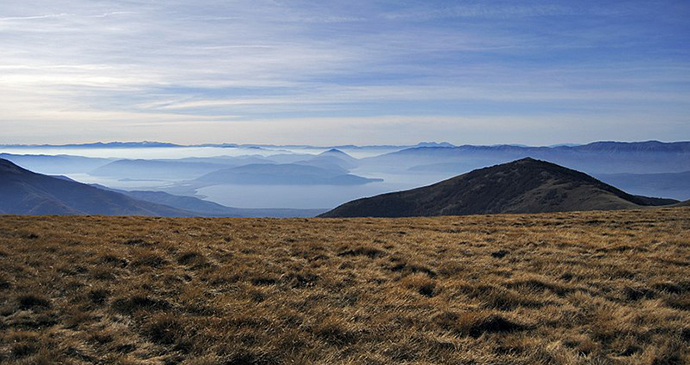
Brajčino offers beautiful views over both major and minor Prespa lakes © Ptahhotep, Wikimedia Commons
The traditional village of Brajčino, perched on the edge of Pelister National Park less than 5km from the border with Greece, can claim to be the first ecotourism initiative in North Macedonia. Pristine and picturesque, it has an idyllic location away from the hustle and bustle of city life, and is protected by the Baba massif, with a view on to Lake Prespa. It offers good access to the glacial lakes atop the range and from there to Pelister summit and the mountain huts. It is easily accessible by car, or by bus from Bitola (two daily) or Resen (several daily). It is also the starting point for the longer day or overnight hike to Hotel Molika via Pelister National Park.
Formerly a rich trading village, Brajčino still has a small population of mixed ages despite the emigration of many of the villagers in the middle of the 20th century to Canada and Scandinavia due to a lack of employment or in order to escape communist persecution. However, the departure of most of the business know-how from the village has left it in hard times, even more so since the break-up of Yugoslavia which has taken its toll on the village’s formerly prosperous apple trade. Previously, apples from the area would be sold as far away as Zagreb and Ljubljana, whereas new borders and taxes have all but eliminated the apple export. Today, the villagers, through the help of Swiss funding and the local non-governmental organisations of DEM (Ecological Movement of Macedonia) and BSPM (Bird Society Protection of Macedonia), are reviving the local economy by offering visitors access to their pristine lifestyle in return for keeping it so. Ten percent of the income of the guides, accommodation and the village shop is reinvested into preserving the local area.
About 3km before the road arrives at Brajčino, it weaves through Ljubojno, a larger village comprising a similar style of traditional stone houses, together with a few 19th- and 20th-century town houses on the central square. Clearly seen above the village are the two churches of Sv Petka and Sv Pavle, which vigilantly watch over Ljubojno.
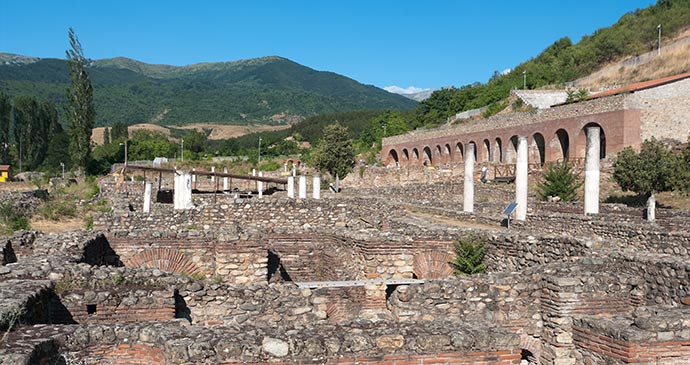
This impressive Roman archaeological site lies on the southern outskirts of Bitola © ollirg, Shutterstock
Heraklea Linkestis
Founded by Philip II in the 4th century BC and an active centre of trade for another eight centuries afterwards, this once-significant town on what is now the southern outskirts of Bitola rivals Stobi as the most worthwhile Roman-era archaeological site in North Macedonia. Only a small part of the old town has been uncovered and excavated, so visits in future years should prove ever more fruitful, especially as historical records show that there are still a number of houses and tombs of the rich and famous at the time to be found. Several important relics and buildings have already been uncovered including the amphitheatre, baths, basilicas and some impressive mosaics, only some of which are on show in the summer. There is a small museum, a snack and drink shop, and a souvenir shop with books on the site in English available for sale. Most of the more important statues are on display in the town museum or in the National Museum in Skopje.
The site lies about 2.5km south of the town centre, a 25–30-minute walk depending on where you start. To get here, follow the pedestrianised Maršal Tito Street south across Partizanski and through Bitola Park until you reach a T-junction in front of a car park. Turn left here, then continue for 100m to another T-junction where you need to turn right on to Ivo Lola Ribar Street. Shortly after this, immediately past the Belcom supermarket, turn right on to the (indistinctly signposted) 500m feeder road that leads to the archaeological site. If you don’t feel like the walk, a taxi shouldn’t cost more than 100MKD.
Considerable archaeological work continues here every year, and for those who wish to take part, the Balkan Heritage School has organised volunteer workshops here in recent years.
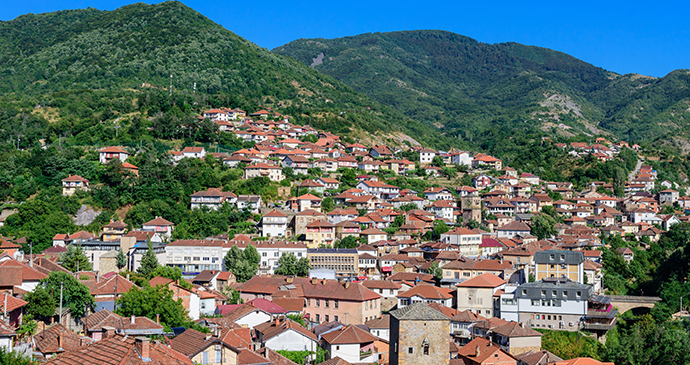
Midway between the start of the E871 (Highway 2) at Kumanovo and Kriva Palanka is the turn-off for Kratovo and Probištip, which joins Highway 2 to Highway 27. On this road, deep in the belly of an ancient and burnt-out volcanic crater, is the small village of Kratovo, a great base to explore this little-visited but fascinating region of North Macedonia.
In Roman times this mining town was known as Kratiskara, meaning ‘crater’, and variations of its name, Koriton and Koritos in Byzantine times, have centred around this meaning. The crater-like hollow of the village has demanded high-arched bridges to cross the river and ingenious architecture to scale the steep ravine. The difficulty of getting to Kratovo has also left the town relatively free of communist concrete. Six defensive towers hark back to the time of King Karpoš. At its commercial peak in the 19th century, Kratovo was reputedly the only town in North Macedonia to support distinct but harmonious Orthodox, Catholic, Muslim and Jewish communities, each of which had its own quarter – these are still recognised today, though boundaries have blurred in recent decades.
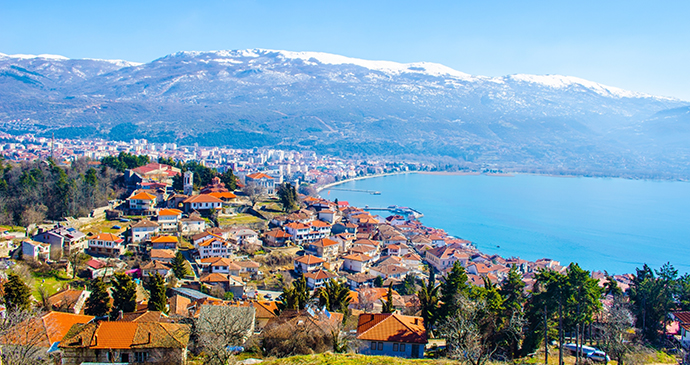
Ohrid boasts a memorable setting on a hilly peninsula lapped by a calm aquamarine lake © trabantos, Shutterstock
Ohrid is the jewel of the Macedonian crown. Both the lake and town of that name form part of the country’s only UNESCO World Heritage Site, which was inscribed as a mixed natural and cultural property in 1997 in recognition of its rare environmental and historical significance. And not without reason. The oldest continuously existing lake in Europe, Ohrid formed in a geotectonic depression around five million years ago, placing it in the same ranks of antiquity as lakes Baikal (Russia), Tanganyika (East Africa) and Titicaca (Peru/Bolivia). Extending over 358km², it is the deepest lake in the Balkans, with a maximum depth of 288m, and some scientists regard it as the world’s most biodiverse water body of comparable size, hosting more than 200 endemic species, most famously the heavily fished Ohrid trout ( Salmo letnica ).
The lake’s principal port town, also called Ohrid, sprawls picturesquely across the hilly northeastern shore. One of the oldest continuously occupied towns in Europe, with roots going back to Neolithic times, it’s renowned for the old churches and traditional architecture that characterise its atmospheric old town. The most important tourist focus on the lake, the town is serviced by a large and varied selection of hotels, restaurants and other amenities catering to domestic and foreign visitors alike. And although it can get very busy during July and August and over long weekends, the old town is much quieter and cheaper on weekdays and out of season.
Enclosed on all sides by pretty green mountains whose peaks are brushed white with snow in winter, Lake Ohrid is noted for its beaches and transparent clean blue water, which offer ideal swimming conditions in the warm Balkan summer, as well as some great diving and sailing opportunities. Points of interest include the little-visited but quaint port town of Struga on the northern shore, the historic Monastery of Sv Naum and associated lake springs near the Albanian border, the tiny cave churches at Kališta and Radožda, and tranquil lakeshore villages such as Trpejca, Peštani and Lagadin. Lake Ohrid is also the obvious base from which to make day trips by jeep, donkey or foot to the characterful old mountain villages of Oktisi and Vevčani, or to go caving, hiking and paragliding in the scenic Galičica National Park.
Monospitovo Wetlands
For an authentic off-the-beaten-track experience, make a stop at the Monospitovo Blato near Monospitovo village, itself an authentic rural village where time seems to have stood still. The Blato, as it’s affectionately known by its nearby residents, is a marsh, purported to be one of the last and biggest in North Macedonia. It lies sprawled at the base of Mount Belasica, 17km southeast of Strumica, and has been officially designated as an environmentally protected site, conferring upon it the status ‘monument of nature’.
Monospitovo Blato lies between Bansko and Kolešino in the municipality of Bosilovo. To get here take the road to Bansko and Murtino, and at Murtino turn east towards Monospitovo village; the entrance to the wetlands lies to the south of the village. In Bosilovo itself, a good place to eat is at Pizzeria Park, which is famous for its bosilanka deep-pan pizza, made with pork, or with chicken and vegetables, and served with a delicious tomato sauce on the side.
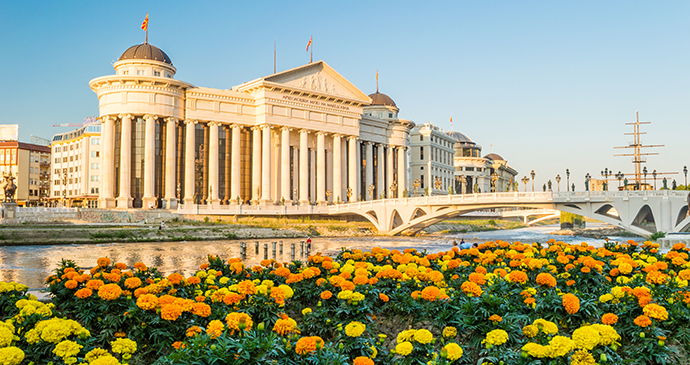
The capital of North Macedonia and main port of entry to the country, Skopje is an up-and-coming city whose population of 550,000 represents more than a quarter of the national total. It boasts a strategic location on the River Vardar and has been an important centre of regional trade for several millennia, as evidenced by the presence within the city limits of archaeological sites dating back to Neolithic, Roman and Ottoman times. The Vardar divides Skopje into a predominantly Muslim northern half and predominantly Orthodox Christian southern half. Most government offices, hotels and shopping malls can be found south of the river, along with the railway station and main intercity bus station.
A city of many cultures, Skopje is worth at least a couple of days’ exploration. The main attraction is the old Turkish quarter known as Čaršija, which lies to the north of the river below the imposing Kale Fortress, and houses a large daily bazaar, several Ottoman architectural landmarks, and a small but buzzing café and nightlife scene. The city also boasts a varied selection of museums, art galleries and archaeological sites, ranging from the recently opened Archaeological Museum of Macedonia and Holocaust Memorial Centre to the Roman-era ruins at Skupi and reconstructed Neolithic village of Tumba Madžari. Further afield, don’t miss out on the cable car up Mount Vodno, the rare Byzantine frescoes in the 12th-century Church of Sv Pantelejmon, and the spectacular lake set within the sheer cliffs of the Matka Canyon.
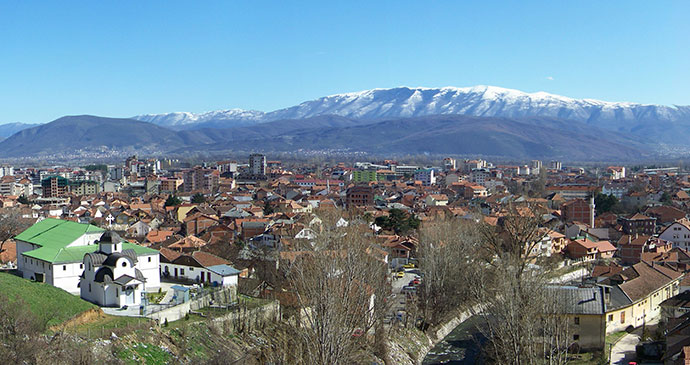
A visit to the lovely town of Tetovo offers the opportunity to take in some stunning mountain scenery © vesnickamarkoska, Flickr
Bisected by the Pena River some 40km west of Skopje, Tetovo is a substantial and lively university town with an estimated population of 70,000. The atmospheric old town, flanking the Pena, is lined with jewellery shops, old-fashioned tailors and boutiques selling modern and traditional clothes, and it also houses a museum and art gallery, and a number of historic mosques and churches, most famously the colourful 15th-century mosque known as Šarena Džamija. Other worthwhile historical sites in Tetovo include the well-tended complex of early 19th-century Islamic buildings known as Arabati Baba Bektaši Teke, and an impressive hilltop fort.
Tetovo is also the gateway to the Šar Mountains and to the popular Popova Šapka ski resort. Towering above the town, covered in snow until July and as early as September, is North Macedonia’s second highest mountain, Titov Vrv (Tito’s Summit, 2,748m). This is in fact the highest mountain that lies completely in North Macedonia; the higher peak of Mount Korab (2,764m) lies further to the south above Lake Mavrovo on the border with Albania.
Nestled close to Kosovo and Albania, Tetovo is the de facto capital of North Macedonia’s significantly sized Albanian minority. It is also the headquarters of the main Albanian-centred political parties, the Democratic Union of Integration and the Democratic Party of Albanians. Just outside Tetovo is the South East European University, North Macedonia’s third-largest university after Skopje and Bitola.
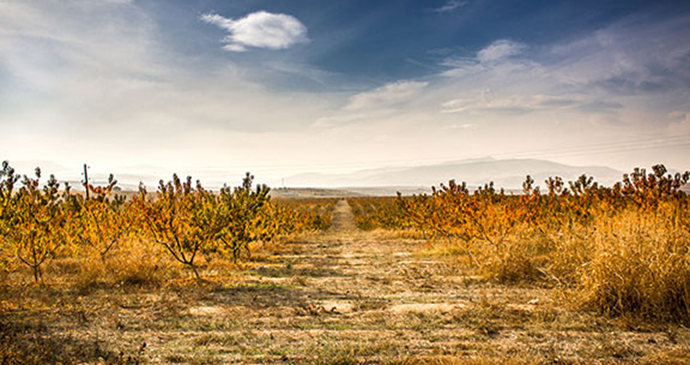
The rich Tikveš Plain is an area renowned throughout North Macedonia for its fabulous wine © Marjan Lazarevski, Flickr
Wines of the Tikveš Plains
The entire course of the Vardar Valley from Veles all the way south to Thessaloniki is fertile grape-growing country, and within North Macedonia the Tikveš Plain around Negotino, Kavadarci and Demir Kapija produces some of the country’s best wines. There are more than 50 small private wineries in North Macedonia and the number is growing, as is the quality. A visit to one of the vineyards in September and October or around Sv Trifun Day in February is always well worth the time if you’d like to try out the season’s newest, or the best of last year’s stock.
Near Demir Kapija, the former boutique vineyard Popova Kula is well worth a visit or overnight stay at any time of year, and you might also want to pop into the historic Royal Winery Queen Maria. Kavadarci is home to the massive Tikveš Winery, while Negotino boasts nine vineyards in its vicinity. There are also vineyards further north around Skopje, and you’ll find the local wines of smaller vineyards served in plastic bottles and cardboard cartons at local petrol stations and stores.
Macedonian wines are unique in European for being made with very little, if any, additional sugar or sulphite preservatives. They are preserved, therefore, mostly by the grapes’ own natural sugars and it is for this reason that almost all Macedonian wines are dry rather than sweet, and why you won’t get such a big hangover the next day after drinking a bottle of T’ga za Jug (Longing for the South) or Alexandria.
Related books
For more information, see our guide to North Macedonia :
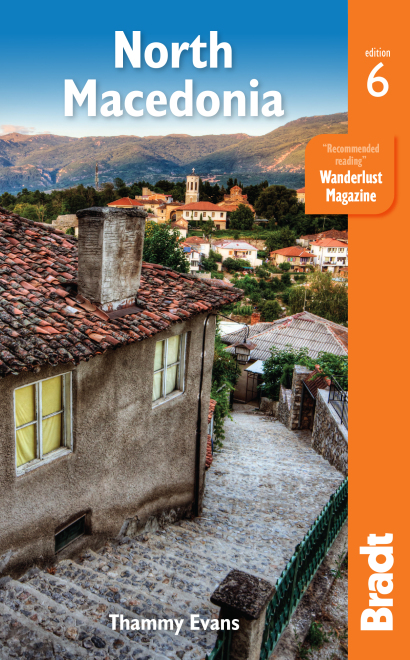
Related articles
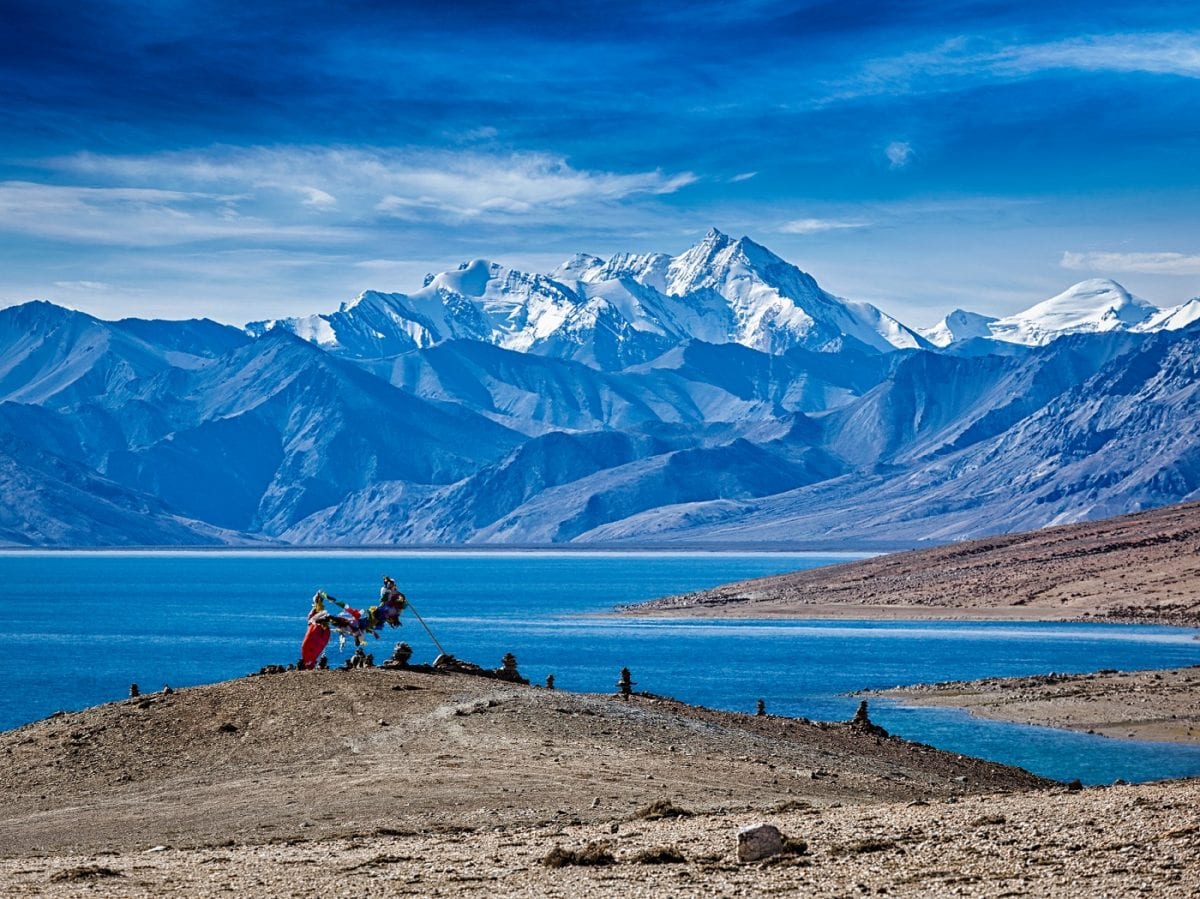
The most impressive lakes in the world
From boiling lakes to vast alpine bodies of water, these are our favourite lakes from around the world.
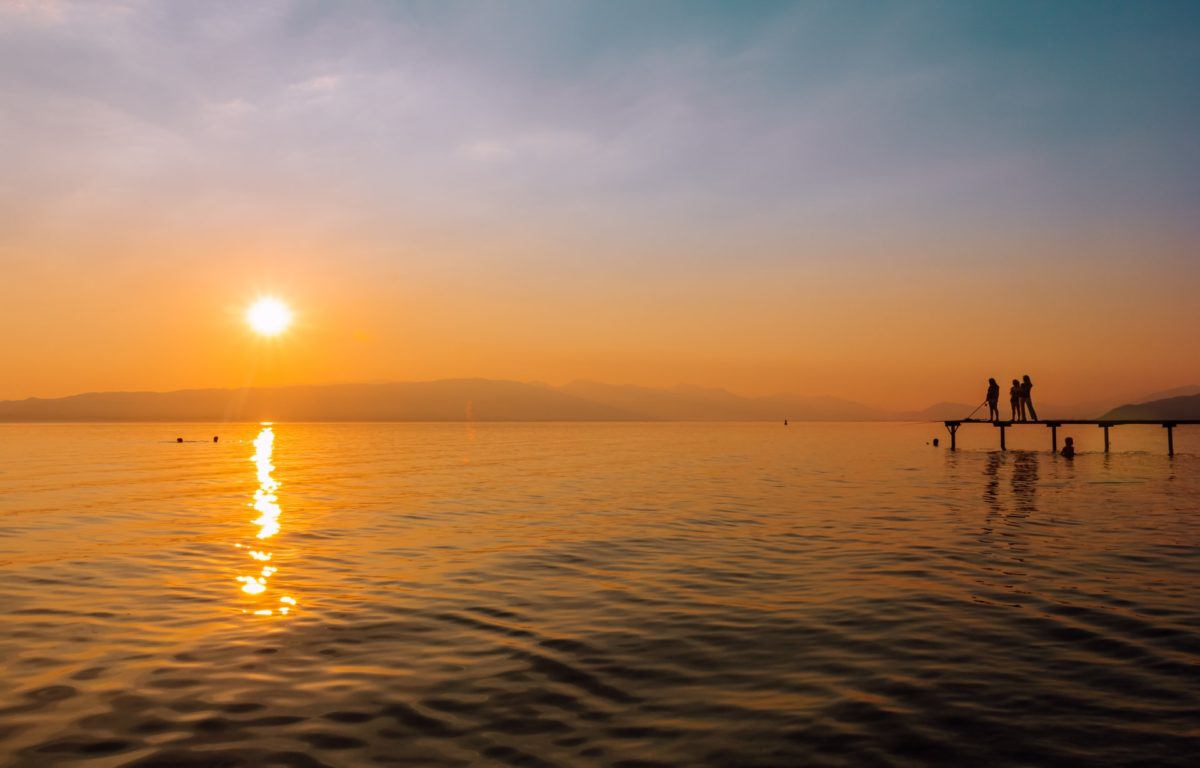
Five reasons to visit North Macedonia
North Macedonia might not necessarily be on your list of European destinations to visit, but it certainly should be.
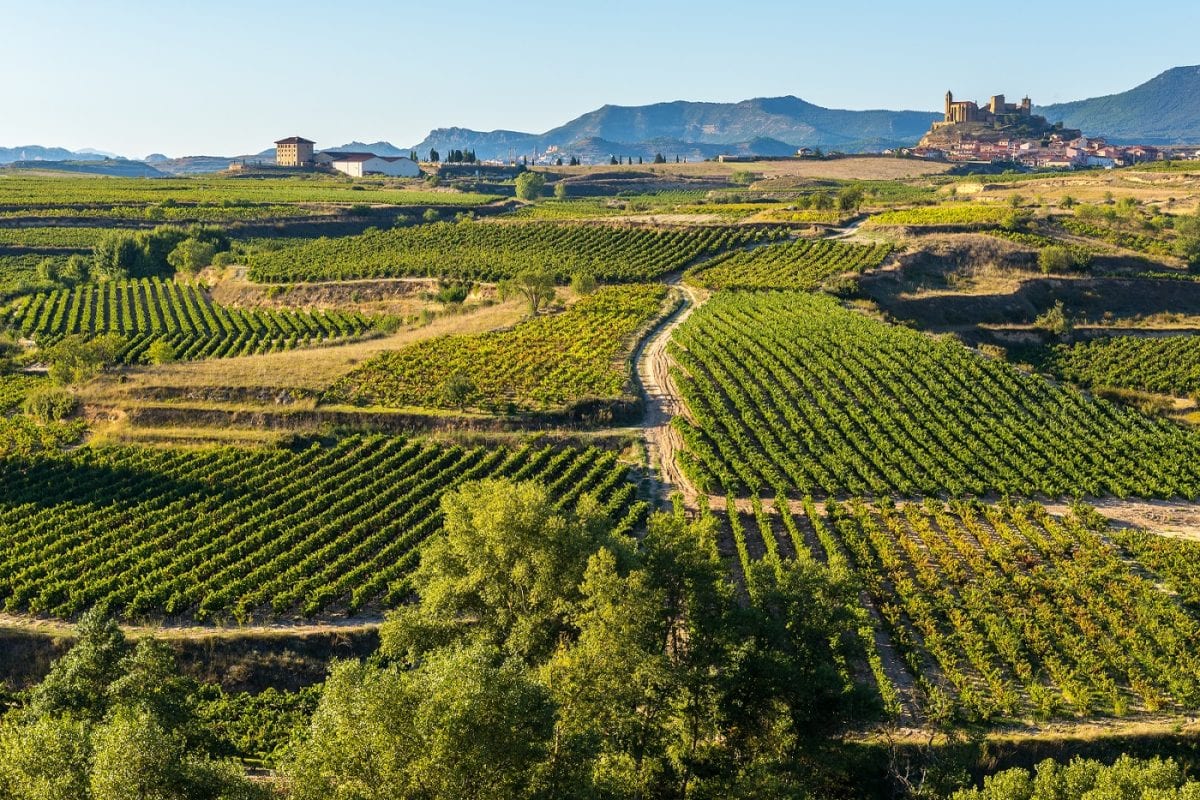
The world’s best lesser-known wine regions
We’ve all heard of Burgundy and Tuscany, but what about Kosovo and Israel?
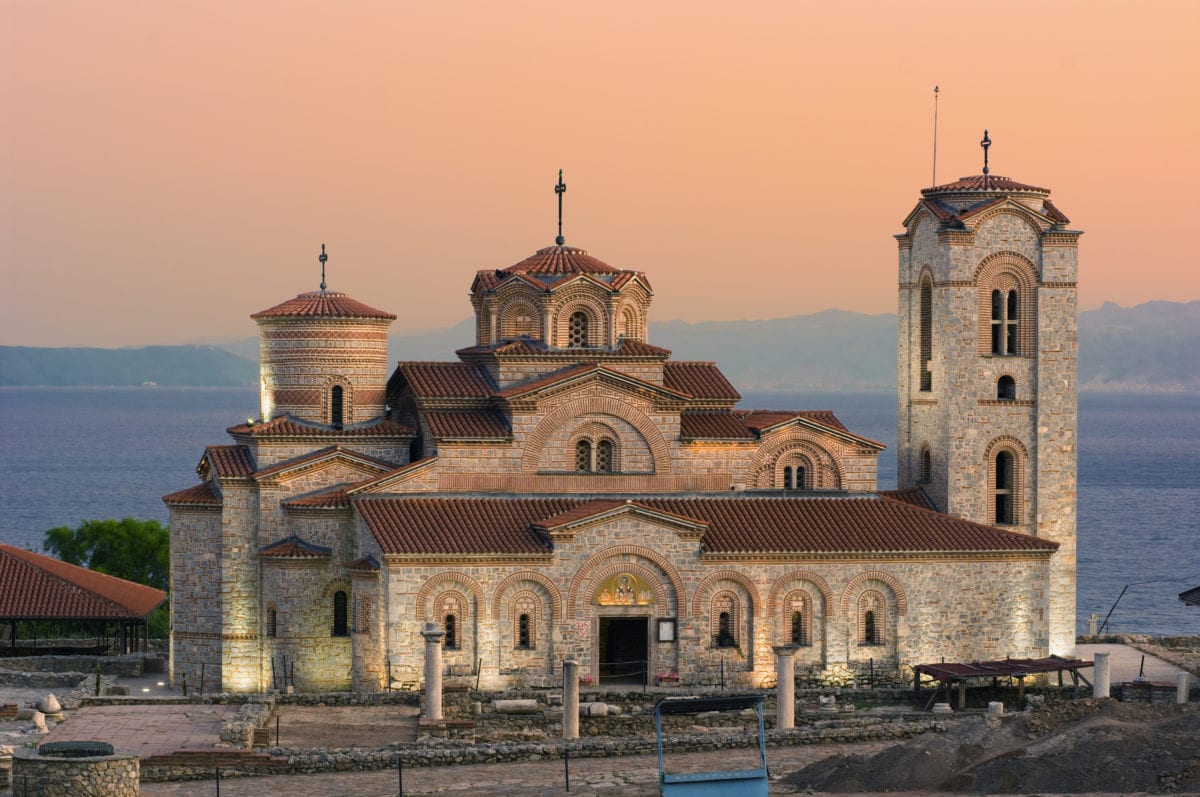
The best monasteries in North Macedonia
From large lakeside complexes to tiny clifftop churches, North Macedonia is home to some of the best monasteries in Europe.
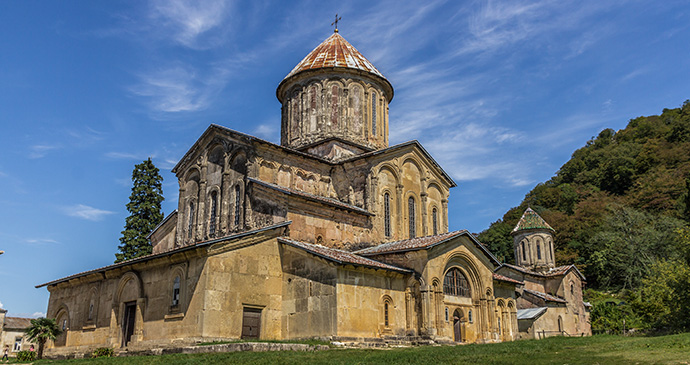
The best monasteries in Europe
From stunning landscapes to sites of historical and cultural importance, monasteries provide a wealth of interest for the avid traveller.
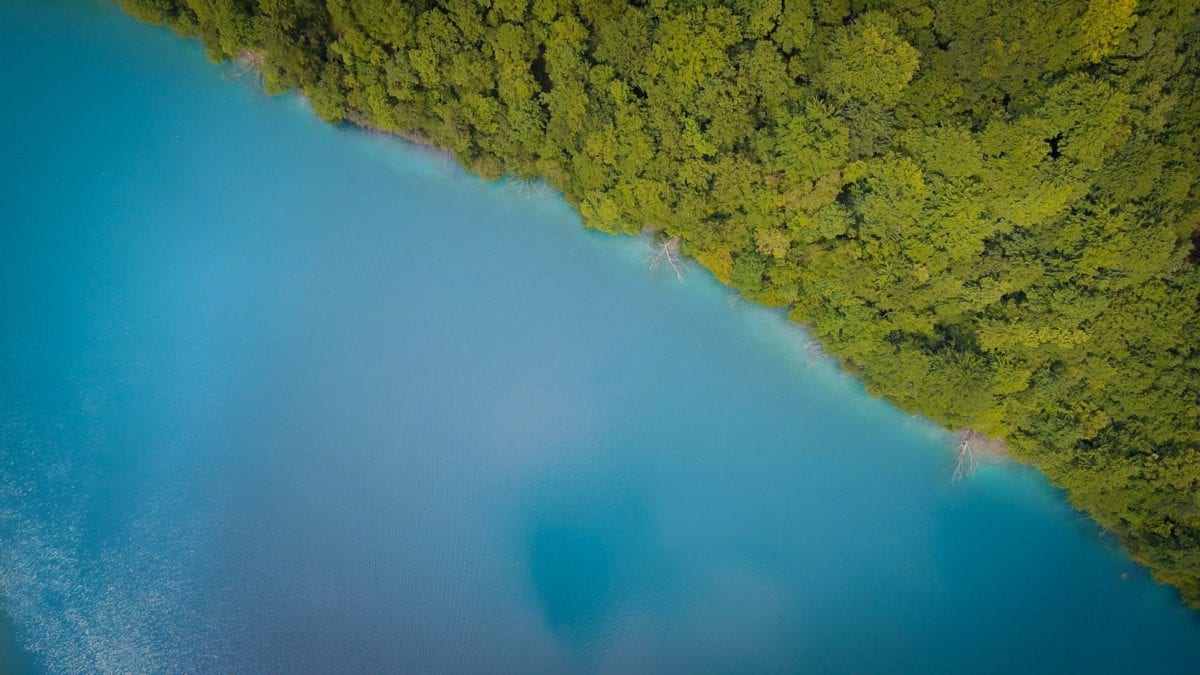
14 European national parks that you’ve probably never heard of
There are many national parks in Europe that remain fairly unknown. Here you can discover 14 of the best. Why miss out on visiting somewhere spectacular?
- South Africa
- El Salvador
- Bosnia and Herzegovina
- North Macedonia
- Czech Republic
- Transnistria
- Liechtenstein
- North Cyprus
- New Zealand
- Map with posts
- Alternative Guides
- Architecture Guides
- Cafe Guides
- Itineraries
- Neighborhood Guides
- Travel Guides
- Travel Tips
- Photo Galleries
- Photo Locations
- Solo female travel
- Train Travels
- Work with me
- Privacy Policy
19 Amazing Places to Visit in North Macedonia
Last Updated on 18/04/2024 by kami
North Macedonia is one of the most underrated countries in the Balkans, often overlooked by tourists exploring the region. And even if they decide to visit Macedonia, it’s often just Lake Ohrid and Skopje. But there are so many more great places to visit in Macedonia: breathtaking mountains, charming towns, ancient sites, interesting architecture, and more.

I’ve been visiting Macedonia frequently for some 10 years now and it quickly became one of my favorite countries to travel to. There always seem to be new places to discover and returning to the old ones is always a pleasure. Add to that delicious food, friendly locals, and affordable prices and you will see why I enjoy North Macedonia so much.
But creating this list of best places to visit in North Macedonia made me realize that there are still some awesome destinations there that I need to see (and need a car to get to as not everything is reachable by public transport, unfortunately). That’s the plan for the near future, though!
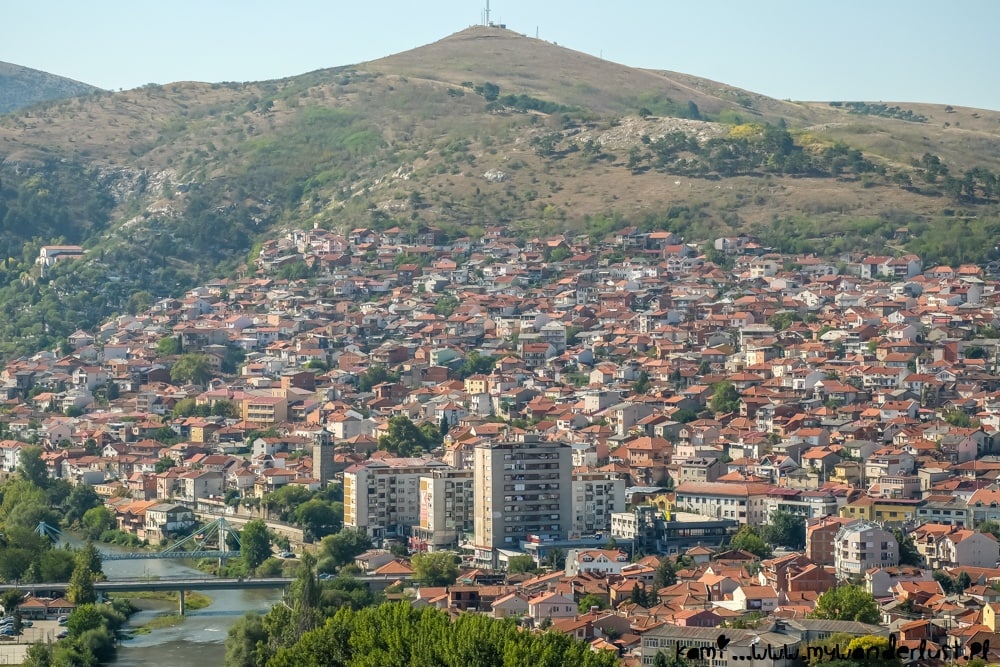
When you decide to visit North Macedonia be sure to include more than just the popular destinations in your itinerary. Below you can find the list of what to see in Macedonia that can hopefully serve as the inspiration for your trip.
Planning a trip to North Macedonia?
Here are the services I always use and personally recommend:
- Accommodation : I always book a place to stay on Booking.com
- Tours: when I decide to go on a tour I use either Viator or Get Your Guide .
- For transportation and booking tickets online , I usually use 12Go or Omio
- If you plan to rent a car during your trip to North Macedonia check Discover Cars to compare prices and find the best deals
- Get insured for your trip to North Macedonia with SafetyWing
Best places to visit in North Macedonia
Skopje, the capital of North Macedonia, is one of the quirkiest cities you will ever see. At first, it might seem pretty random, with blocks of flats covering the center, but once you dig a bit deeper into the place you are in for a treat.
You won’t find many historical sights there as the city was largely destroyed by the 1963 earthquake but Skopje is such a weird combination of architectural styles that they somehow fit together.
The central part of the city is lined with modern buildings that try to resemble ancient ones and with countless statues (some of them portray well-known historical figures, others are just random scenes). The most important one is “the warrior on the horse” located in the middle of the main square of the city – Macedonia Square. Not only it is very impressive with its 12-meter height, but it is also a very controversial statue that in fact shows Alexander the Great.
Across the Vardar river, you can explore the oldest part of Skopje – the bazaar with the maze of narrow streets and the fortress towering above the area. Wandering around there is like stepping back in time.
If you enjoy brutalist architecture (I do!), Skopje is like a huge playground with so many concrete masterpieces around.
For a quick escape from the hustle and bustle of the city, you can head to the nearby Vodno mountain from where you can go hiking or simply enjoy the stunning panorama of Skopje and its surroundings.
Read more about Skopje in my articles:
- What to do in Skopje, the kitschy yet cool capital of North Macedonia
- Guide to Skopje Brutalist Architecture
- Alternative Skopje
- North Macedonia: Skopje monuments in pictures

Matka Canyon
Only a short ride away from Skopje you will find one of the most beautiful places to visit in Macedonia – Marka Canyon. This spectacular place was actually not made by nature. In 1938 the dam was built on river Treska, creating an artificial lake surrounded by high mountains, the oldest lake of that kind in North Macedonia.
The Matka Canyon covers an area of around 5,000 hectares. 20% of the plant species you can see here are endemic, meaning they can’t be found anywhere else. You can also see 77 kinds of butterflies in the area! There are also ten caves at Matka Canyon, the most popular one being Vrelo Cave. It was even included on the list of the top 77 natural sites of the world in the New 7 Wonders of the World project.
When visiting Matka Canyon you can do here numerous activities, like hiking, fishing, or kayaking. You can also find some old monasteries in the area. But the main reason to visit Matka Canyon is to simply see what a stunning place it is.
You can get to Matka Canyon from Skopje by bus or join one of the tours that visit this place.
Read more about Matka Canyon in my article: Matka Canyon – a perfect nature getaway outside Skopje
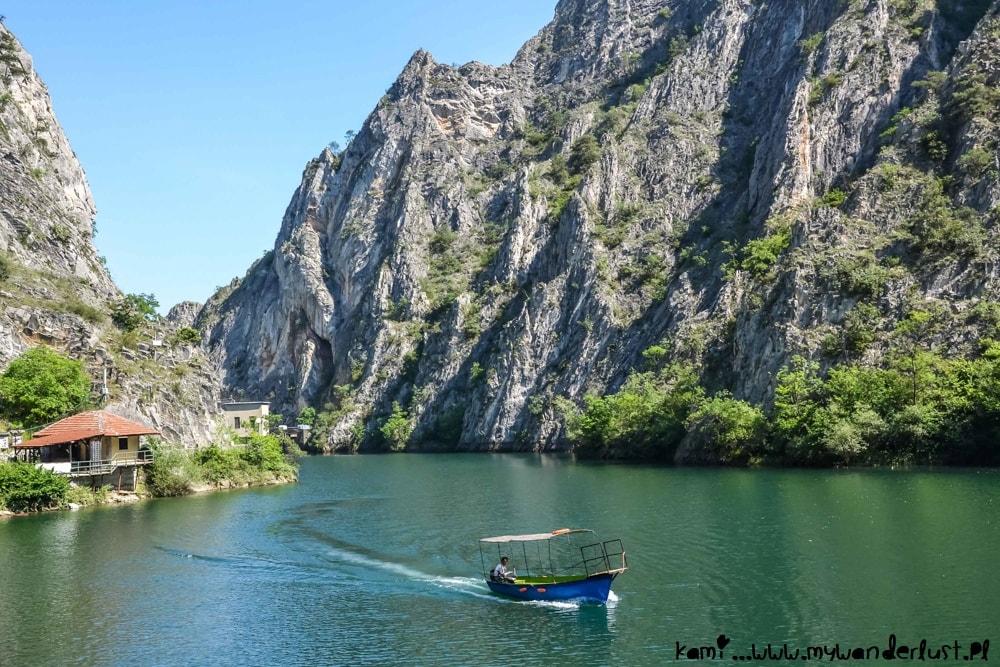
Tetovo is one of the most underrated places to visit in North Macedonia. Even if it’s conveniently located only 45 km away from Skopje, on the way to Lake Ohrid, not many tourists decide to stop there. Huge mistake as Tetovo hides one of the most stunning buildings you can see in North Macedonia – the Painted Mosque.
It was built in 1438 and later rebuilt in 1833. Even if the mosque is rather small, it surely is stunning with very rich decorations (unlike many other mosques, the dominant motifs are floral and bright). This is also the only mosque in southeast Europe where you will find the illustration of Mecca – the holy place of the Islamic world.
While the Painted Mosque is amazing there are actually more things to do in Tetovo: the 16th-century Turkish hammam turned into a gallery, Arabati Baba Tekḱe – a spiritual complex popular in Sufism religion, founded in the 16th century, or a few great brutalist buildings. Tetovo also offers some beautiful views of the surrounding Sar Mountains.
Read more about Tetovo in my article: Tetovo, North Macedonia – Stunning Painted Mosque and More

- Are you planning a trip to North Macedonia? Be sure to join my Facebook group about traveling in the Balkans and be part of the amazing community of like-minded travelers. Click here for the access!
- Don’t want to miss new articles? Sign up to the monthly newsletter to receive all the updates to your mailbox!
Lake Ohrid is, hands down, the most amazing place to visit in Macedonia and one of the best in the Balkans. Every time I’m there my jaw drops at how stunning this area is. Whether you are looking for cultural, relaxing, or active holidays – Lake Ohrid falls into all of these categories.
The main town at the lake is Ohrid where you will find most of the attractions and monuments. The best way to get to know Ohrid is to simply wander around the Old Town and stumble across all it has to offer: numerous churches (it is said that in the past there were 365 churches in town), the 10th-century fortress or the ancient amphitheater. The most iconic view in Ohrid (or even the whole country) is the 14th-century church dedicated to Saint John at Kaneo, built on a high cliff above the lake.
Once you are done with visiting Ohrid, there are more places along the lake that you shouldn’t miss: Saint Naum Monastery (founded at the very beginning of the 10th century, it is one of the most important religious sites in North Macedonia), Bay of Bones, Holy Mother of God Zahumska church or Struga (another large town on the lakeside).
Both, the city of Ohrid and the lake were included in the UNESCO World Heritage List and are one of the few places that are both on the Cultural and Natural list.
Read more about Lake Ohrid in my articles:
- 17 Best Things to Do in Ohrid, North Macedonia
- Beautiful Ohrid, North Macedonia off season
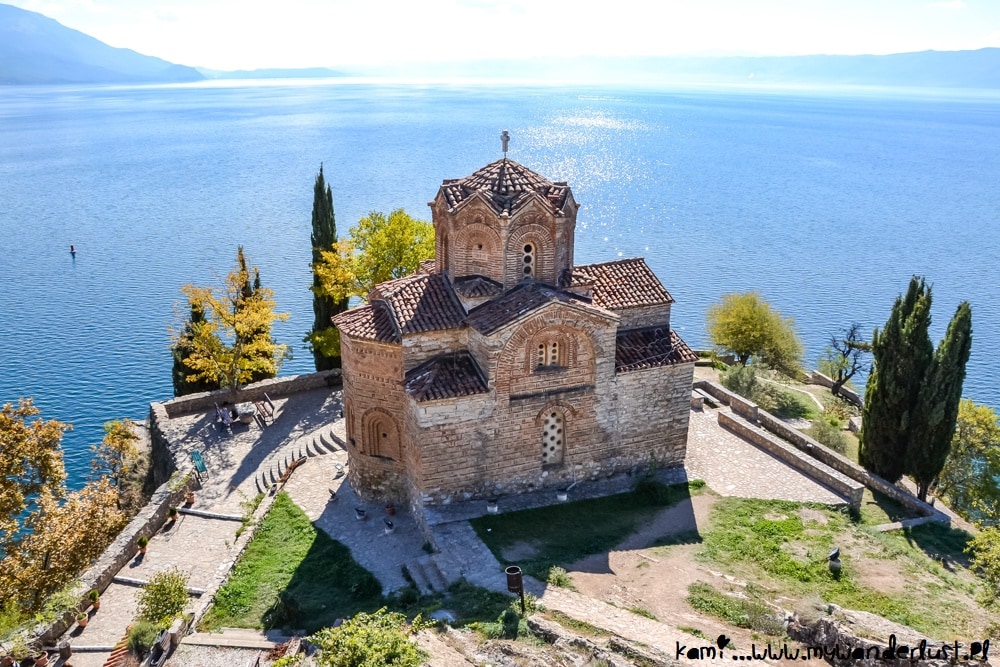
Veles might not be the not obvious destination choice when visiting Macedonia but the city, located 55 km south-east of Skopje, has at least one landmark that is worth the attention. If you are familiar with the concept of Yugoslav spomeniks – the WW2 memorials that often have rather unusual shapes – you might want to come to Veles to see one of them.
Kosturnica Memorial, dating back to the late 1970s, was created to honor Partisan soldiers from Veles and surrounding areas who were fighting against the fascist German and Bulgarian forces during the National Liberation War from 1941 to 1945. The memorial was supposed to look like the open poppy-seed flower, the symbol of life and rebirth. Inside you can find the museum with the biggest mosaic in North Macedonia.
Visiting Kosturnica Memorial has one more advantage – from the monument, you can admire a beautiful panorama of Veles (the city has a really picturesque location). Besides the abstract-looking spomenik other places worth seeing in Veles include the historical clock tower from the 18th century and the Church of Saint Pantaleon from the 19th century.
Read more about Veles in my article: Veles, North Macedonia – an underrated city in the Balkans

Even if today Kratovo is a sleepy little town, it has a long and interesting history, dating back to Roman times and for centuries it’s been an important mine center with various raw materials mined here.
Kratovo is picturesquely located in a basin surrounded by green hills at the edge of Osogovo mountains and the townscape is packed with red rooftops and medieval stone towers. In the past there were seventeen stone towers from the 12th to 14th century (the highest number of medieval towers in Macedonia), today only six remain but they sure are impressive. Another remnants of the old times are medieval stone bridges connecting two sides of the small rivers and creeks, there are still five of them in Kratovo.
Altogether, visiting Kratovo feels a bit like stepping back in time. This is one of the most underrated places to visit in Macedonia.
Read more about Kratovo in my article: Kratovo, North Macedonia – the Town of Stone Bridges and Towers

Bitola , known also as the “City of Consuls” is the second-largest city in North Macedonia, located in the south of the country near the border with Greece.
Thanks to the many consuls who had their seats here in the 19th century the city still has a different, more laid-back, and European vibe than other places in Macedonia. The center is lined with beautiful 19th-century buildings and the pedestrian central street – Shirok Sokak – is packed with cafes where you can sit down, observe the world around and enjoy the relaxing atmosphere of Bitola.
Even if the city is known for its 19th-century importance, Bitola is much older and you can find some older monuments here too, especially mosques and the bazaar area (which can compete with the one in Skopje).
But the real highlight of visiting Bitola is Heraclea Lyncestis – the ruins of the ancient town located just 2 km outside of the center.
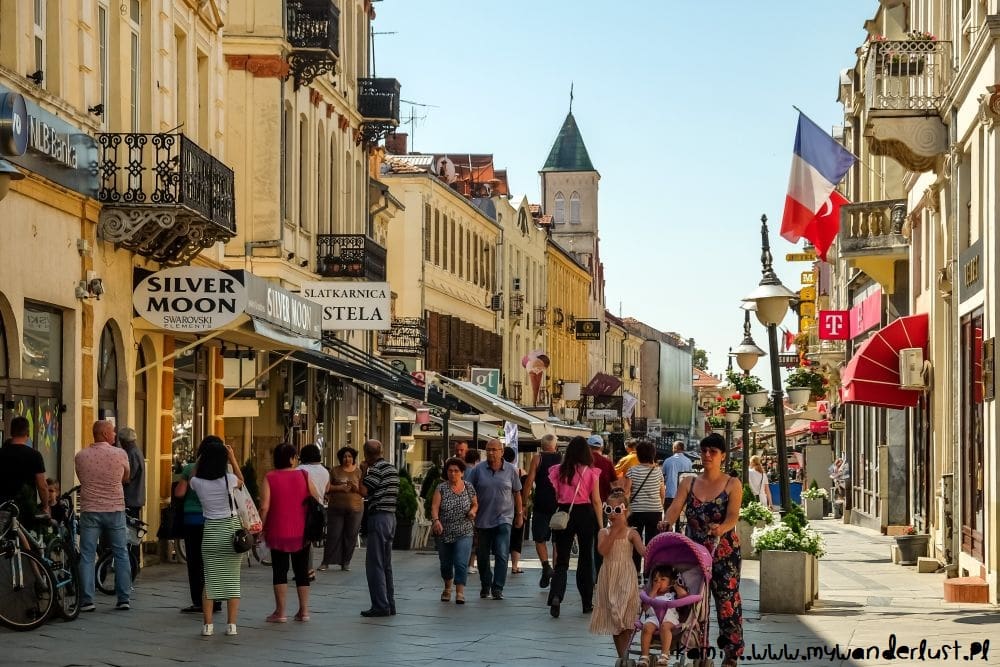
Pelister National Park
When visiting Bitola don’t also miss Pelister National Park, located just outside of the city. This is the oldest national park in North Macedonia, established in 1848, and surrounds the Baba Mountain massif with its highest peak Pelister (2601 m, the third highest mountain in the country).
The park is known for its exquisite flora and fauna, it is also a perfect place for hiking around and the close proximity to Bitola makes it a popular nature getaway among locals. When wandering around you can expect some amazing views, you can also visit two mountain lakes called Pelister’s Eyes.

Prilep is known mostly as the Macedonian tobacco and beer capital but this city, located between Skopje and Bitola, has actually a lot to offer.
The central part of Prilep isn’t large but it’s packed with monuments from the ancient, Byzantine, Ottoman, neoclassical, communist, and modern times. The old bazaar is rather small but really pleasant with its vibrant atmosphere. On the edge of it, you can see the ruins of the Čarši Mosque from 1475 (the oldest mosque in Europe with a double balcony on its minaret) that was sadly set on fire during the 2001 protests. Despite its current condition, you can still easily imagine what a beautiful place it used to be.
In Prilep, you can also see another Yugoslav spomenik – Mound of the Unbeaten – commemorating the Prilep area’s fallen in the Struggle for the Liberation of Macedonia.
What catches the attention right away when visiting Prilep is the city’s beautiful location with rocky hills surrounding the place. On those hills on the edge of the city, you can find remnants of the medieval fortress from times when Prilep was the capital of the medieval kingdom of Kings Vukašin and Marko. This is one of the best places to visit in Prilep, not only for its historical value but also stunning views around.
10 km away from the city you can also visit the secluded Treskavec Monastery from the 12th century with incredible frescoes inside. The hike to the monastery is a bit challenging but the landscape and views around are the best rewards for the effort.
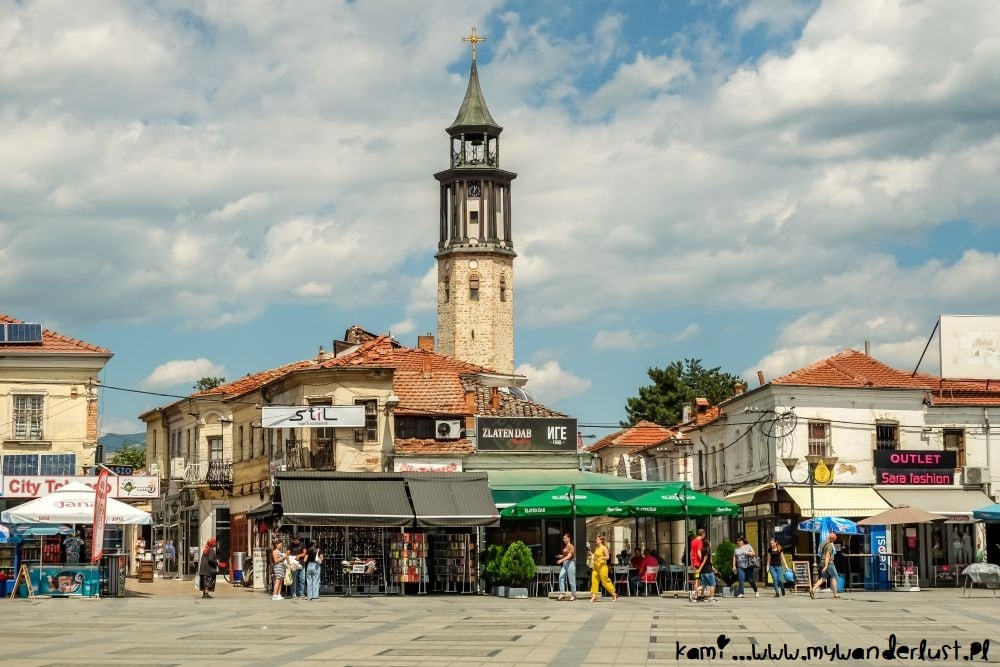
With an elevation of 1,350 m Krusevo is the highest-located town in the country that, in 1903, was the center of the Ilinden Uprising against the Ottoman Empire. Today it is a very picturesque yet sleepy town with a few monuments worth visiting.
The highlight of Krusevo is yet another spomenik, probably the most known one in North Macedonia – Makedonium, opened in 1974 on the 30th anniversary of the Second Session of the Anti-fascist Assembly for the National Liberation of Macedonia and the 71st anniversary of Ilinden Uprising. The design of this structure is really unique and looks like from outer space. If you are lucky and Makedonium is open be sure to visit it inside too to see some interesting stained glass windows and basreliefs.
Krusevo was also the hometown of the most popular Macedonian singer, Tose Proeski who died in a car accident in 2007 at the age of 26. Today you can visit his memorial home and his grave in Krusevo, there are also numerous signs all over the town commemorating this famous artist.
Krusevo is also a perfect place for a lazy stroll around, to admire the beautiful architecture of the town and beautiful views of the town and beyond.
Read more about Krusevo in my article: Visit Krusevo – the Picturesque Town in North Macedonia
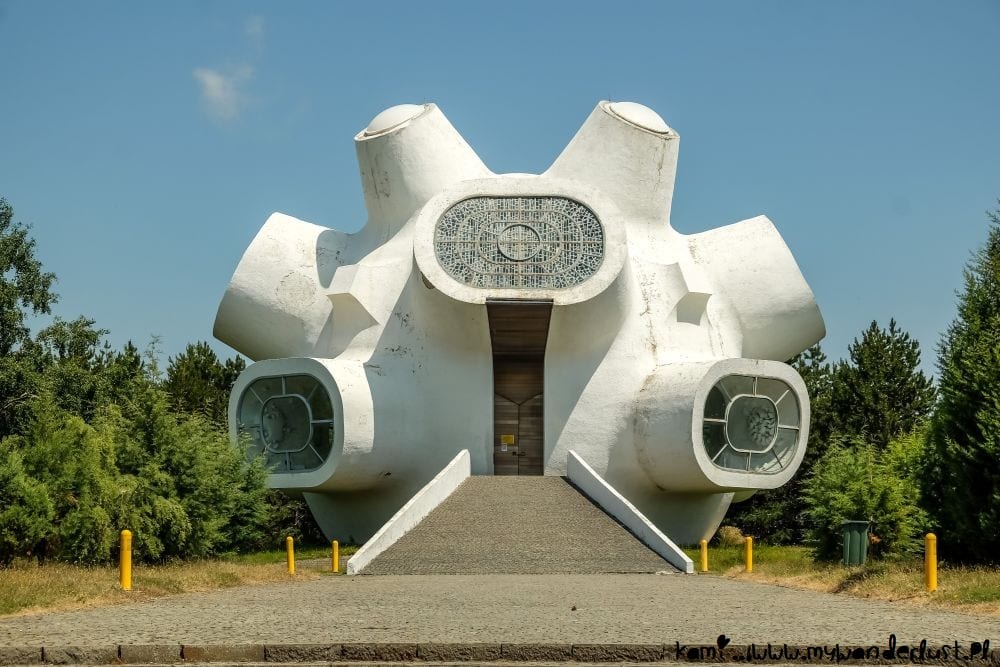
Mavrovo National Park
Mavrovo National Park is the largest national park in the country, located in the western part of North Macedonia, near the border with Albania . You can find there some beautiful landscapes with lakes, rivers, and caves as well as the highest peak of Macedonia – Mount Korab (2,764 m).
The most popular place to visit in Mavrovo National Park is the submerged Church of Saint Nicholas from the mid-19th century. How much of it you can actually see depends on the water level in Lake Mavrovo, in the summertime when the lake dries up you can even visit the church inside.
The area of the national park has actually more interesting monuments you can visit, the highlight being Saint Jovan Bigorski Monastery originally from the early 11th century, with the impressive wood-carved iconostasis. Don’t also miss the village of Galičnik, known for its historic architecture – it has the biggest number of buildings under protection in the whole country.
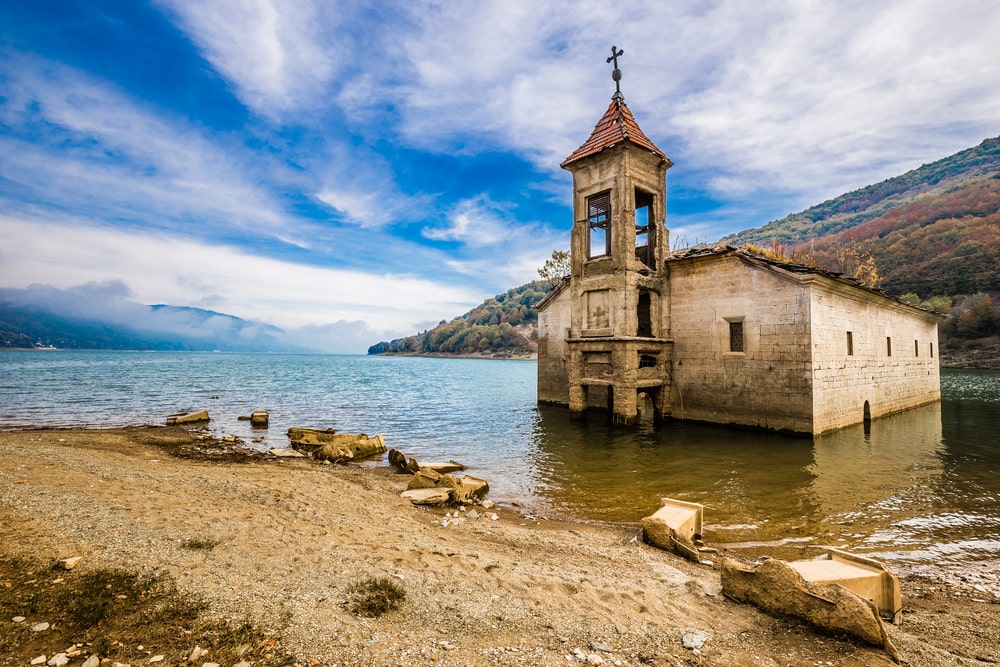
Stobi is probably the most impressive ancient town you can find in the territory of North Macedonia, dating back to BC times. Around the 2nd century BC, it fell under Roman rule and was developing until the 6th century when it was destroyed by earthquakes and invasions.
Today you can visit amazing remnants of that ancient town and see ruins of numerous historical sites: houses, basilicas, streets, and more, there are also some well-preserved mosaics still on the ground.
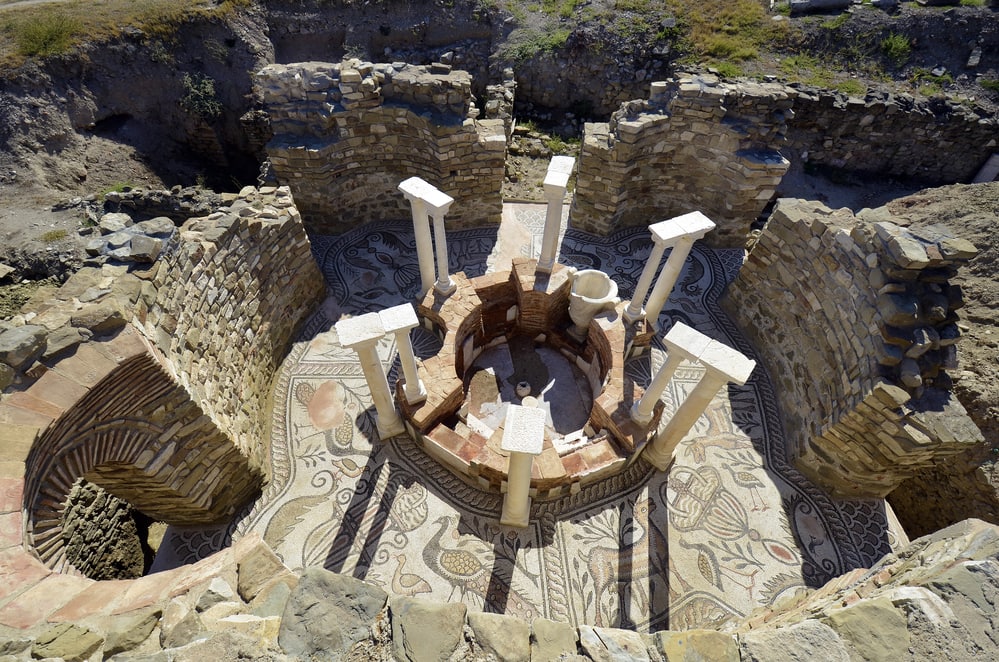
Šar Mountains
Located on the border between North Macedonia and Kosovo , Šar Mountains offer some breathtaking views and hiking possibilities. With 30 peaks higher than 2,500 m as well as a few glacial lakes located over 2,000 m, Šar Mountains is a paradise for all nature lovers.
Since the area isn’t widely popular you can expect fairly empty trails when wandering around. The highest peak of the Šar Mountains is Titov Vrv (2,747 m). The mountain range is located just outside Tetovo and is easily accessible from this city.
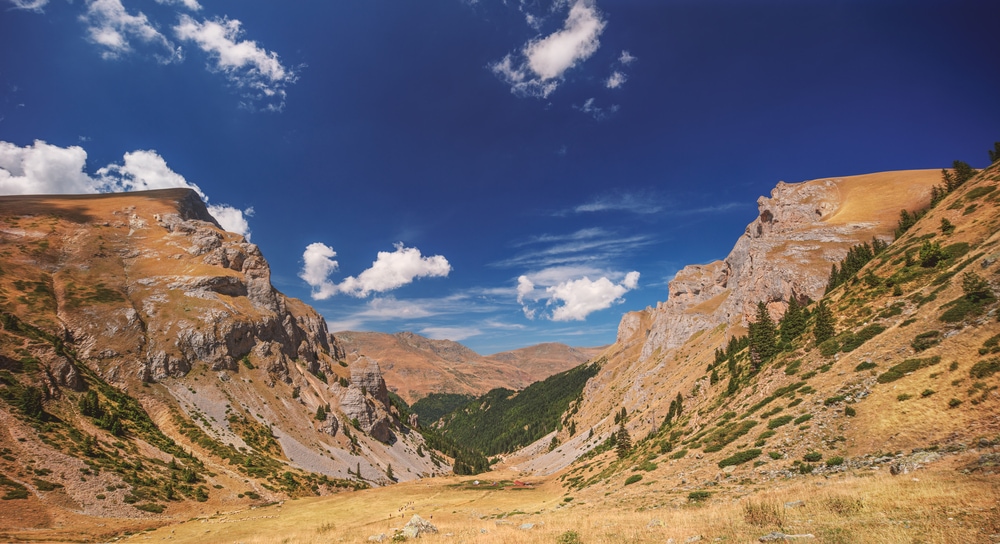
Osogovo Monastery
Located near the border with Bulgaria , Osogovo Monastery was founded in the 12th century but the oldest part of the structure we can visit today dates back to two centuries later.
The monastery in fact consists of two churches: the larger “Saint Joachim of Osogovo” and the smaller “Holy Mother of God”. That’s also where you will find a residency for the Head of the Macedonian Orthodox Church.
Besides its historical and religious value, it’s worth visiting Osogovo Monastery for the beautiful frescoes you can see inside the churches.
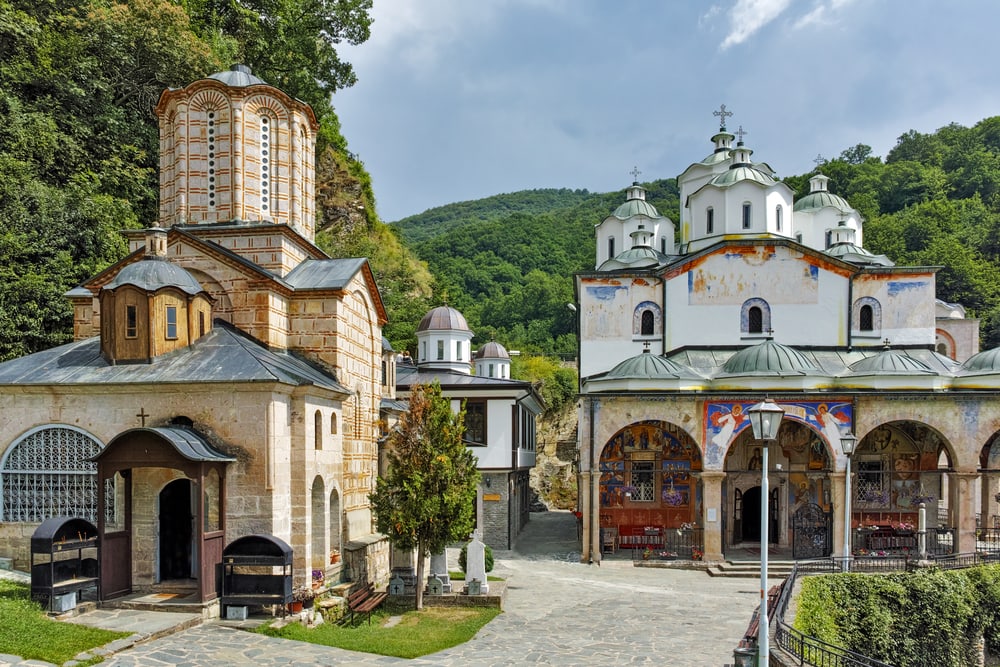
Stone Dolls of Kuklica is often called “the Macedonian Cappadocia”. There are over a hundred stone pillars: 15 large (10 meters tall) and 120 smaller ones. Since many of them resemble humans, the legend says that the pillars are in fact wedding guests that were turned into stones.
Kuklica is located only 10 km away from Kratovo so you can combine visiting these two places together.

Discovered only in 2001, Kokino is the site of the megalithic observatory that is believed to be almost four thousand years old, making it the fourth of the oldest observatories according to NASA. You can still find there special stone markers used to track the movement of the sun and moon on the eastern horizon.
What makes this place even more worth visiting is the spectacular scenery in the Kokino observatory is located in.
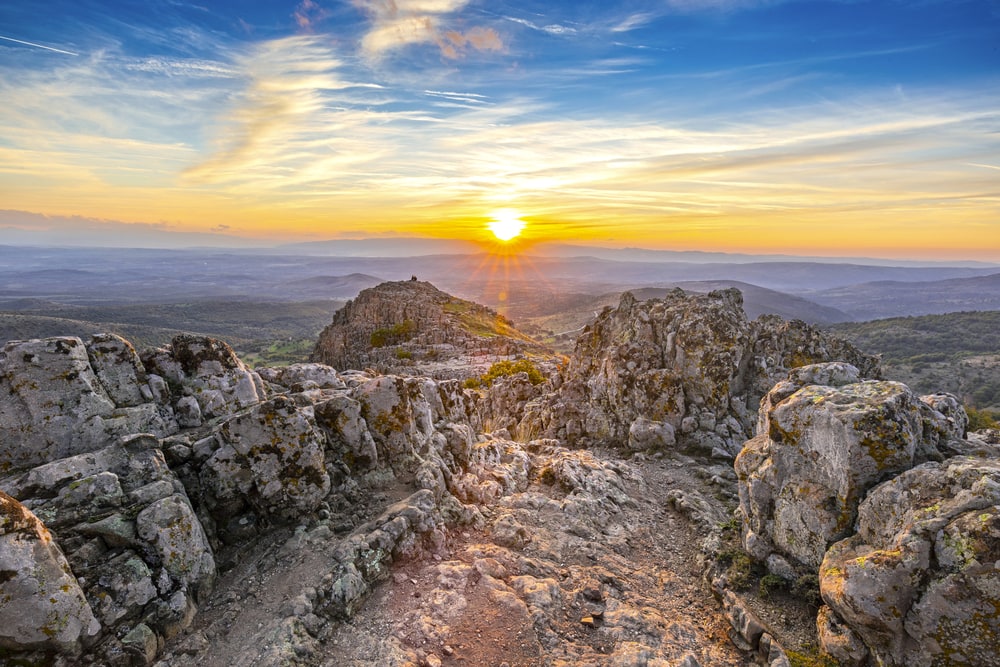
Kozjak Lake
Kozjak Lake is the largest artificial lake in North Macedonia, located not far from Skopje. Surrounded by picturesque mountains rolling down to its surface, the lake is 32 km long and in the widest place, the distance between the shores is up to 400 meters. Kozjak Lake was created in 2004 when the nearby hydroelectric power plant opened.
The lake is especially popular among fishermen but even if you are not interested in fishing you should still visit the area as the views, especially from the upper parts, are breathtaking.

Lake Prespa
Less popular than Ohrid, Lake Prespa is divided between three countries: North Macedonia (the largest part), Greece, and Albania. With an elevation of 853 meters, this is the highest tectonic lake in the Balkans, surrounded by two national parks of Macedonia: Galičica and Pelister. This is also where you will find some of the best beaches in North Macedonia, making Lake Prespa a popular destination among local tourists.
Besides the stunning views, there are other places worth visiting around Lake Prespa: Golem Grad (the largest island in the country) as well as a few old churches and monasteries.
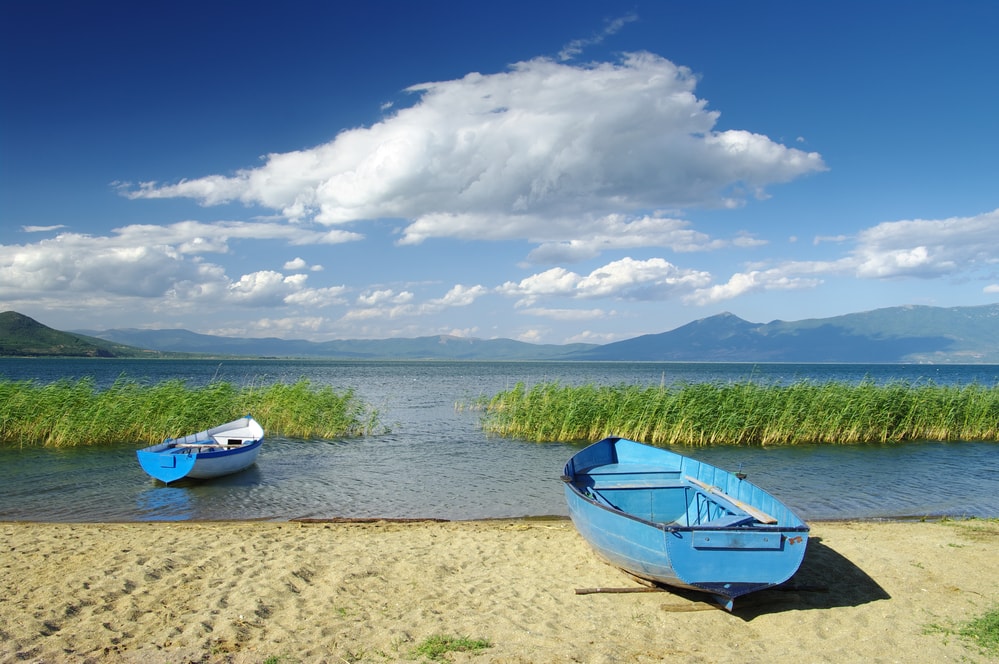
Galičica National Park
The area between Lake Ohrid and Lake Prespa is where you will find Galičica National Park, focused around the Galičica mountain range with the highest peak being Kota (2,292 meters). Within the park, you can find over 1600 floral species. The national park makes a perfect nature getaway or even a day trip destination when visiting Lake Ohrid.
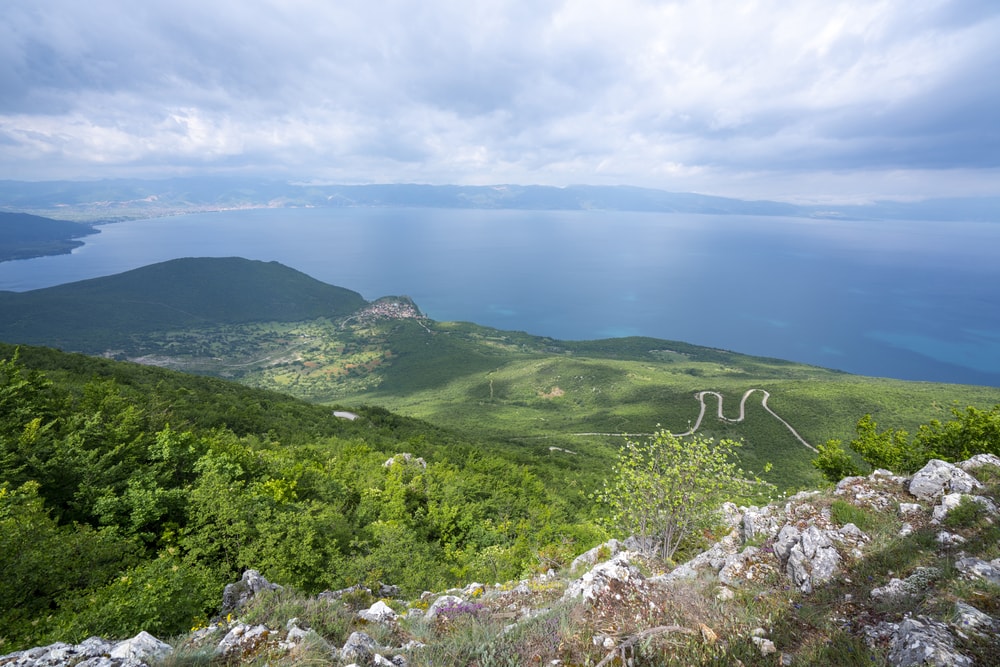
Map with the best places to visit in Macedonia
To give you a better overview of places to visit in Macedonia, here is the map with the locations of all the destonations mentioned above.
Final thoughts on visiting Macedonia
As you can see, North Macedonia really has a lot to offer and even if it doesn’t have sea access (which I think is the reason why it’s less popular than other Balkan countries) there are still plenty of great places to see in Macedonia. Give the country a chance and you will not be disappointed! You might even keep returning to North Macedonia just like I do.
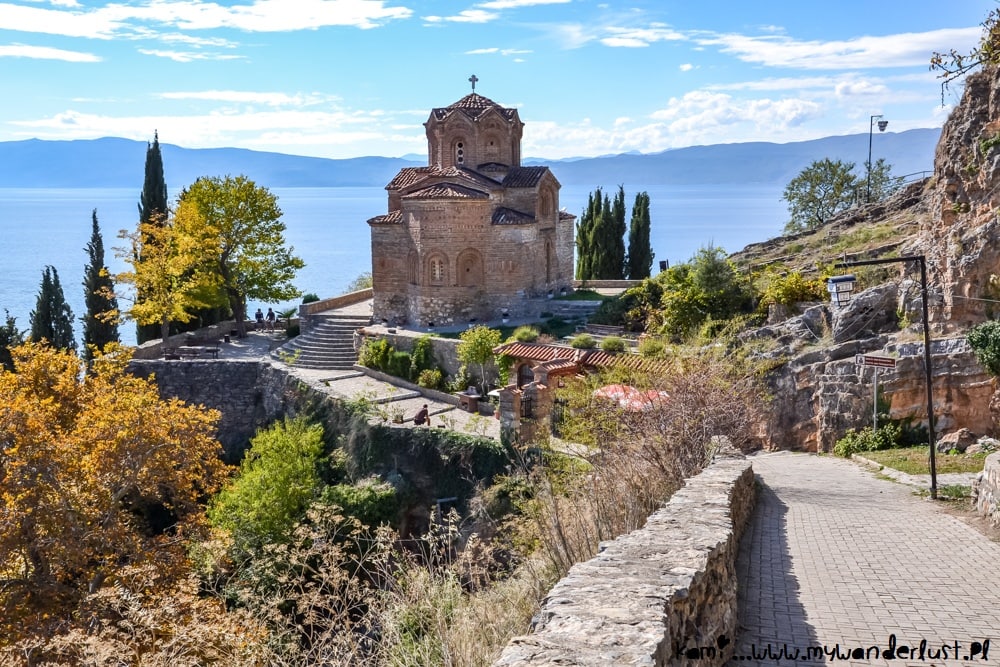
Travel Resources
Below you can find the brands I trust and use when planning trips:
- You can find the best accommodation options at Booking . They have many discounts and excellent customer service. Click here to look for the place to stay in North Macedonia
- I recommend joining organized tours to get to know the place better and to visit more places during your trip. You can find a great selection of tours at Viator or Get Your Guide .
- To always stay connected I use Airalo eSim cards – click here to get yours!
- Looking for the airport pickup ? Check Welcome Pickups!
- Never travel without travel insurance , you never know what might happen and better safe than sorry. You can check the insurance policy for North Macedonia here.
- Make sure to have the offline map always installed on your phone, they can save you so many troubles. I always use the free app Maps.Me .
For the end I left a few announcements that might interest you:
- Sign up to my newsletter or follow me on Bloglovin to get updates about the new posts
- Join my Facebook group about Eastern Europe, the Balkans and former USSR and connect with fellow travellers and enthusiasts of these regions – just click here!
- I’ve included a few handy links of services and products I personally like and use so you can plan your own trip to North Macedonia too. They are often affiliate links. This means I will get a small commission if you book/purchase anything through my links, at no extra costs for you. Thank you!
LIKED IT? PIN THIS POST FOR LATER!

If you enjoyed that post why don't you share it with your friends? That would mean so much to me! Also be sure to join 30.000+ fellow travelers and follow me on Facebook , Twitter , or Instagram for travel updates and even more pictures! If you don't want to miss new posts sign up to my newsletter or follow on Bloglovin !

Jennifer Doré Dallas
Hi! I am curious, how is the Wi-Fi for a remote worker that needs to do a lot of stable Zoom calls?
I never had issues with the wifi in North Macedonia but then I didn’t use it for zoom calls, just to work online
Leave a Reply Cancel Reply
Sign me up for the newsletter!
Let’s become friends!
Join me on Facebook for even more travel updates!
Kami and the rest of the world
- Add Your Travel Deal
- FREE Travel Newsletter

Top 10 things to see and do in North Macedonia
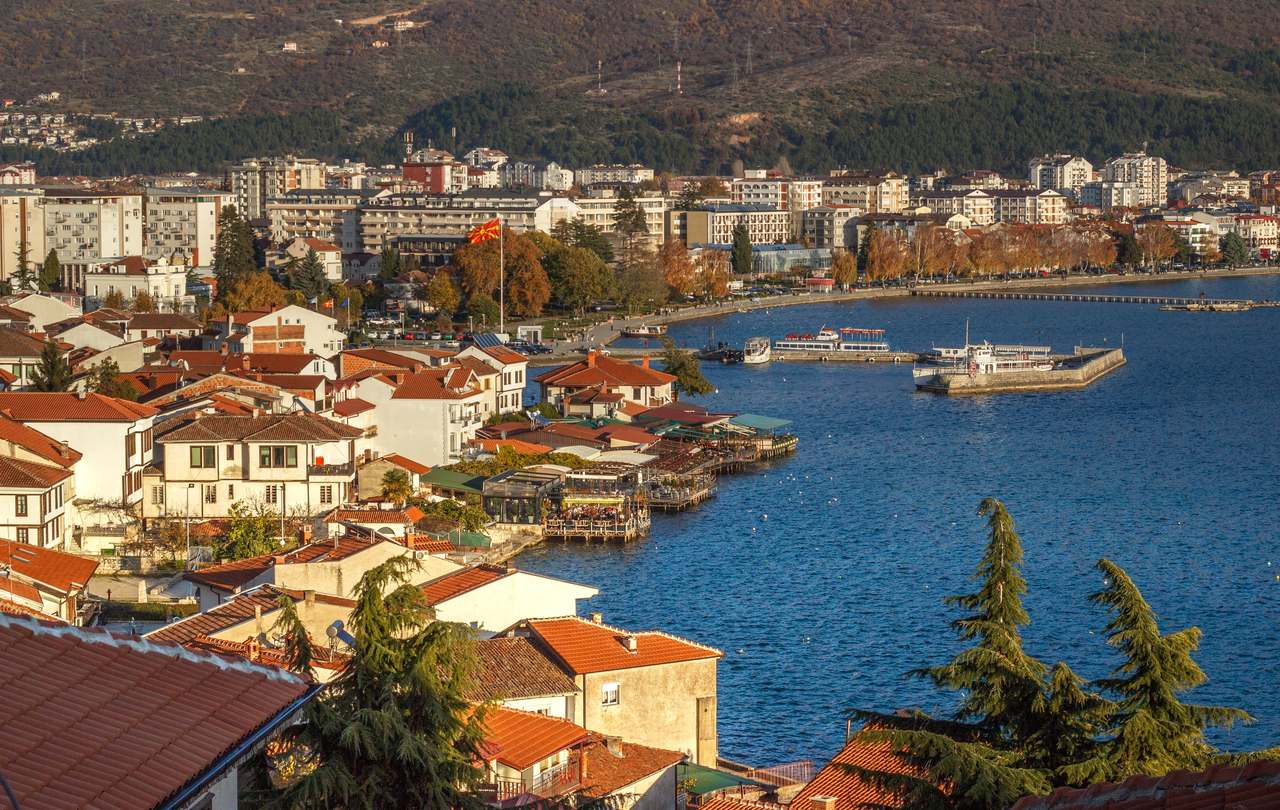
The Republic of North Macedonia is the last wilderness in Europe, a small Balkan state with thousands of years of history and culture which borders Bulgaria and Greece. Just over three-quarters of a million foreign tourists visited in 2019.
Though many of them would undoubtedly keep North Macedonia’s treasures to themselves, this extraordinary country is a secret too good not to share.
If you want an uncrowded, affordable, short-haul destination for your long-awaited travel escape this year, here are 10 reasons that North Macedonia should rocket to the front of your list.
Macedonian Wine Tour
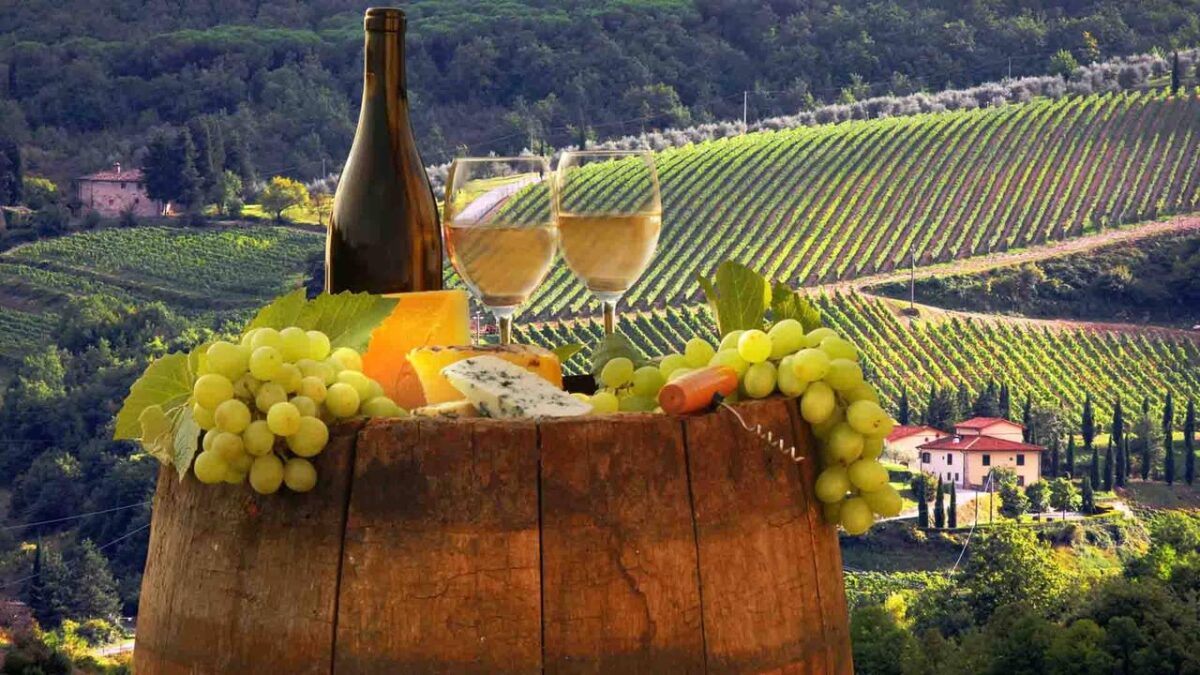
Winemaking for four millenia
Did you know wine has been produced in North Macedonia for more than 4,000 years? That’s a long time to perfect the art of making wine.
International grapes, such as Cabernet Sauvignon and Pinot Grigio growing prolifically in the vineyards, as do indigenous grapes rarely found elsewhere.
Indeed 90 per cent of all the Vranec vines in the world are planted in North Macedonia, and Macedonians celebrate World Vranec Day every October with a wine festival and tastings in their capital city Skopje.
Wine tourism in North Macedonia is growing, with more and more vineyards and wineries opening to visitors. Whet your appetite before you go with a 360-degree tour of Tikves Winery. Then plan a route taking in Lazar Winery and Popova Kula Winery. Both offer tours, tastings, and places to stay in their idyllic vineyard settings.
Skopje’s Old Bazaar
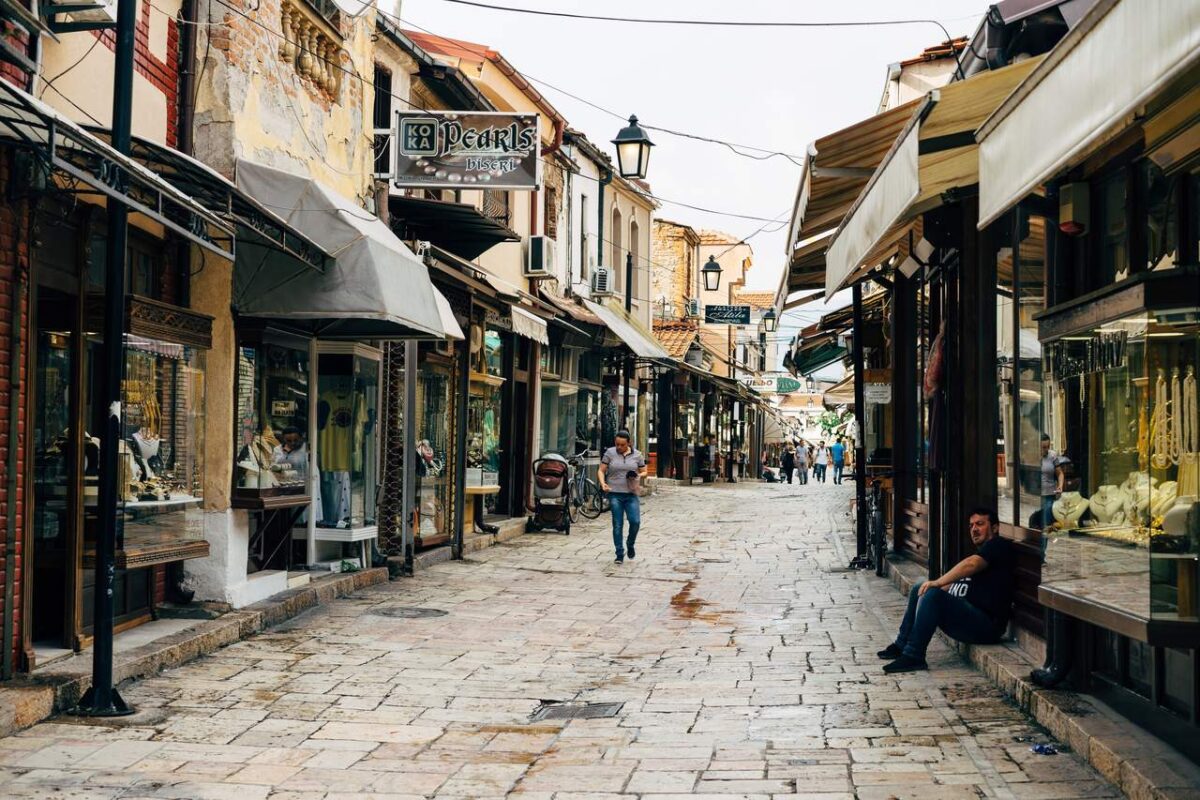
Skopje Old Town
The Old Bazaar has been Skopje’s commercial centre since the 12th century. It was close to the Vardar River and on the main trade route between Sarajevo and Athens.
The Ottomans built an extensive network of open and covered market buildings, caravanserais, mosques, monuments, and all the supporting infrastructure that a medieval merchant might need. Earthquakes, fire, and time have all taken their toll, but it’s still a fascinating, culturally rich part of the city to explore.
Today the Old Bazaar is protected as a cultural heritage site. At the same time, two museums, the Museum of the Republic of North Macedonia and the Museum of Modern Art, have been built in this part of Skopje, further enhancing its appeal. Allow plenty of time to wander the historic streets, soak up the atmosphere, and then head to the rooftop bar at Hotel Arka in time for sunset.
Monastery of St. Jovan Bigorski
The Orthodox Monastery of St Jovan Bigorski (St John the Baptist) is in Mavrovo in the western part of North Macedonia. Founded originally in 1020, it was destroyed by the Ottomans in the 16th century but then rebuilt.
The monastery clings to the hillside and has superb views across the valleys. A community of monks still live here, though they welcome respectful guests. The monastery highlights are its spectacular frescoes and wooden iconostasis, and there is also a large collection of sacred relics.
Lake Ohrid
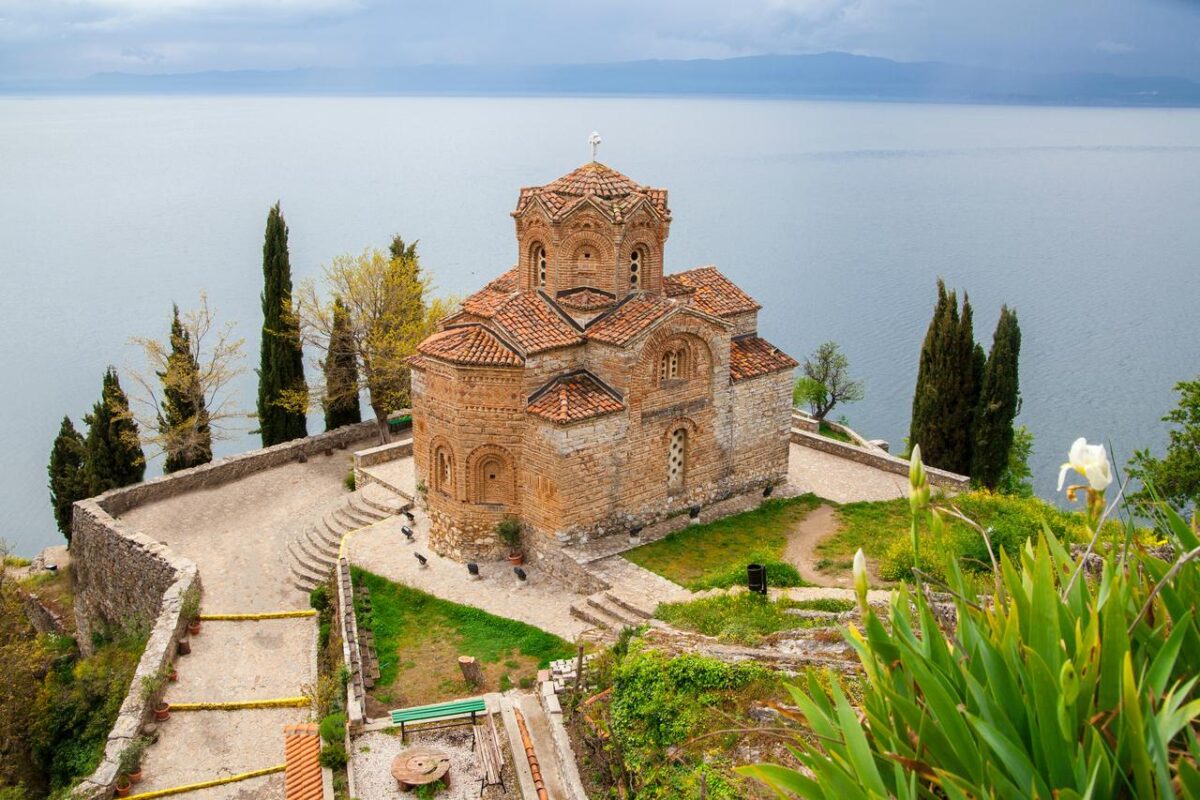
Church of St John Kaneo on Lake Ohrid
Lake Ohrid is a UNESCO World Heritage Site, and it straddles the border between North Macedonia and Albania. One of the oldest and deepest lakes in Europe, it is an important biosphere reserve, as well as being an undeniably scenic location to relax.
As a tourist, you are likely to stay in Ohrid or Struga, both of which are right on the lakeshore. Hotel Pela is tucked into the midst of a pine forest in the national park, with breathtaking views of the lake, and at Camp Krste Jon in Struga, you can spend the night in a treehouse, ramping up the excitement of your adventure.
Macedonian Hiking Trails
North Macedonia boasts some of the best hiking routes in Europe, with several new trails mapped and developed with EU funding in the past few years. Ema Fildishevska of Macedonia Travel has been at the forefront of trails development, devising options for hikers and mountain bikers alike. She has created more than 20 self-guided one-day hikes, plus a variety of longer routes, including overnight accommodation in homestays. North Macedonia’s most stunning hiking locations include the Sharr Mountains (one of the largest massifs in the Balkans), Lesnica, the Via Dinarica, and Canyon Matka.
Sherpa Horse Riding
Balkan mountain horses are hardy and sure-footed on steep terrain. In the saddle, you can ride for miles across the incredibly wild, beautiful scenery of North Macedonia’s national parks and other unspoiled areas of countryside.
Sherpa Horse Riding is based in the Mavrovo National Park, surrounded by forests, crystal clear rivers, and mountain meadows. Riding the six-day Miyak’s Tribe Trail is an unforgettable experience for horse lovers, incorporating dramatic scenery and ancient sites, opportunities to experience authentic rural hospitality, and traditional activities such as goat milking and cheese making.
Winter Sports in North Macedonia
North Macedonia is a four seasons destination, as exciting in the winter months as it is in the height of summer. From January to March, winter sports lovers will mostly be in their element, with several ski resorts and backcountry choices galore.
North Macedonia was one of the first countries in Europe to offer cat skiing, and you can ride with locals with Eskimo Freeride. The activity’s premise is simple: you travel up the mountain on a specially designed snow groomer, accessing places ski lifts don’t reach. You can then ski or snowboard through the thick, untouched snow, miles away from anyone else.
Those who prefer skiing with a little more infrastructure and a little less adrenaline can head instead to the ski centre at Resort Mavrovo for a gentler winter sports experience.
Macedonian Gastronomy
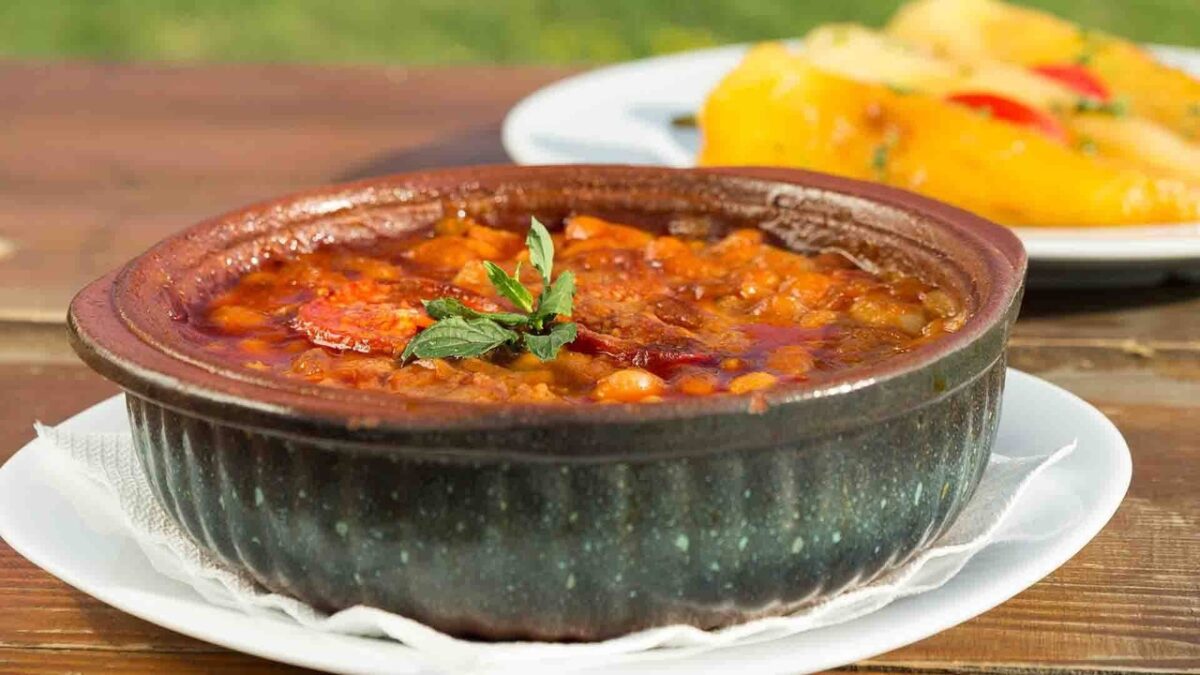
Rich stews are served baked in earthenware pots
When was the last time you ate in a Macedonian restaurant? If you haven’t yet been treated to that feast, it’s about time you put that right.
Macedonian cuisine reflects Balkan, Mediterranean, and Turkish influences and incorporates the very best local, seasonal ingredients, many of which are organic. Not only is Macedonian food delicious, but the restaurants are incredibly affordably priced, with a good meal for two often costing no more than £10.
One of the best restaurants in North Macedonia is the House of the Miyaks , very close to St Jovan Bigorski monastery.
They serve homemade bread and locally produced cheeses and charcuterie, plus mouthwatering specialities such as grilled trout, rich stews baked in earthenware pots, and malidzano, a dip or spread made from aubergine and peppers, flavoured with wild herbs from the hills.
Galicnik Wedding
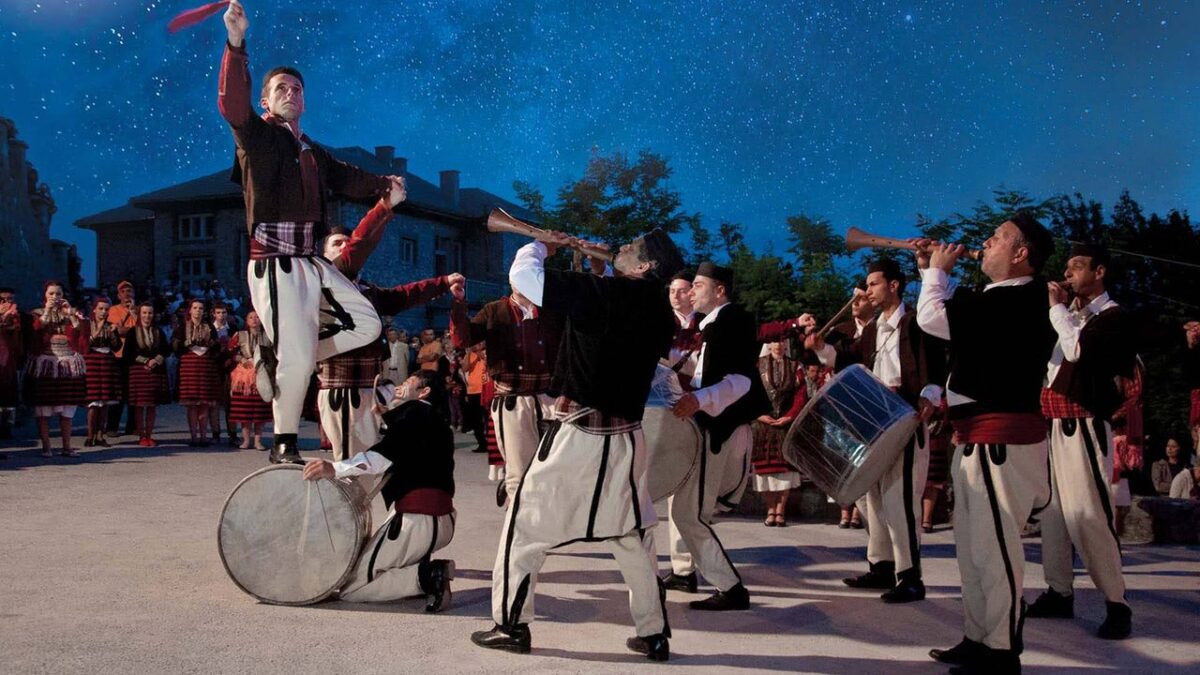
A Galicnik Wedding
Attending a wedding is an unbeatable way to immerse yourself in the local culture. In North Macedonia, the Galicnik Wedding Festival takes place every July and lasts for five days. Couples from all over the country compete to celebrate their wedding during the festival, but only one bride and groom are chosen each year.
There’s live music and traditional dancing by both men and women, and the guests dress up in their finest national attire. It’s one of the most popular events on the calendar for locals and tourists alike.
Take to the Skies
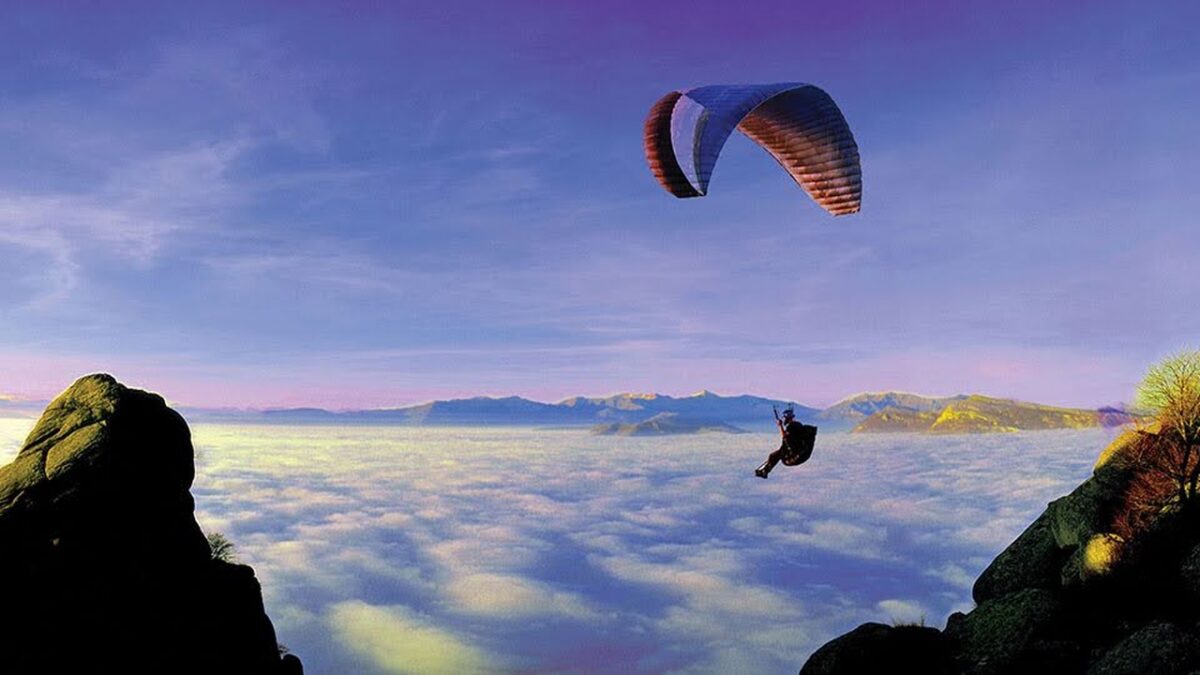
Take to the skies by paragliding
The rivers, lakes, and mountains of North Macedonia are some of the most spectacular, yet least developed, in Europe. And although these extensive wildernesses are gorgeous from the ground, it’s a whole new experience to take flight and see them from the air.
There are airborne activities for every budget and appetite for risk, from paragliding and tandem parachute jumping to more gentle hot air balloon rides floating above the national parks.
Ryanair launches Covid travel pass onto their boarding app
Turkey: british holidaymakers are welcome without vaccinations, leave a comment cancel reply.
Save my name, email, and website in this browser for the next time I comment.
This site uses Akismet to reduce spam. Learn how your comment data is processed .
Related Articles
Explore charming south of france with viva cruises..., the 6 best places to eat in aruba, aruba – one happy island in the caribbean..., the montagu arms hotel review, new forest, england, a family short break at castle howard, welburn,..., guide to perpignan mediterranee, france, travel guide to florida’s paradise coast for families, hiking and biking around whitby, yorkshire, uk, travel guide to island hopping in west sweden, viva cruises: viva one rhine river cruise review.

IMAGES
VIDEO
COMMENTS
Asia and Europe. Islam and Christianity. Religion is tied to ethnic and national identity here, and North Macedonia is mostly populated by Macedonians who are of Slavic origin and are Orthodox Christians, and by Albanians who are Muslims. Albanians are the largest minority, one-third of the inhabitants.
How much to budget for your trip. North Macedonia, like most other countries in the Balkans, is an extremely affordable travel destination by European standards. Budget traveller: 20-30 USD/day (hostel, buses, local meals) Mid-range: 30-50 USD/day (guesthouse or Airbnb, buses & taxis, restaurant meals) All-out: 50-100 USD/day (boutique hotel ...
5. Super Cheap. It's generally fair to say that Eastern Europe and the Balkans are the cheapest regions in Europe. I always loved the value you could get in countries like Bosnia Herzegovina or Bulgaria. And yet, visiting Macedonia beats them all. I've yet to encounter a country as affordable to visit as Macedonia.
Below, you'll find some of the best places to visit in North Macedonia from the vibrant capital Skopje to the stunning lakeside town (and my former home) of Ohrid, ancient ruins at Heraclea Lyncestic, mountainous national parks, sprawling vineyards, and hilltops dotted with churches and monasteries. 1. Skopje.
Here are my top 10 reasons to visit North Macedonia. 1. North Macedonia Is One Of Europe's Rising Destinations. North Macedonia is becoming one of Europe's rising destinations for tourism. In fact, 2021 saw a 50% increase in tourists. Even still, the country is relatively unexplored and untouched by mass tourism.
North Macedonia's top five foodie destinations. Wildlife & Nature. Hike through Albania, Kosovo and Macedonia on a new long-distance trail. Art. The power of art: epic Yugoslav monuments in the Balkans. Hiking. The Via Dinarica hiking trail: a cultural corridor across the Balkans. in partnership with getyourguide.
The Ultimate North Macedonia Travel Guide - Adventurous Miriam. 179 shares. 179. I've created this complete Macedonia travel guide with all the information you need to plan a trip to Macedonia. Macedonia is a landlocked country with wild natural landscapes. Mountains, rivers, and valleys make up much of the stunning beauty of this country.
Just outside Skopje, the painted mosque in Tetovo is the most beautiful in all of the Balkans. In the centre of the country, North Macedonia's jewel, Lake Ohrid, sparkles. Cruise to the St. Naum Monastery near the border with Albania or hire a bicycle and circumnavigate the entire lake in a day, passing through the two border crossings.
The Foreign, Commonwealth & Development Office (FCDO) provides advice about risks of travel to help you make informed decisions. Find out more about FCDO travel advice. Follow and contact FCDO ...
What to do in North Macedonia? This 3 days itinerary is the perfect guide to the best things to see in North Macedonia. It includes day-by-day activities, travel tips, and the top places to visit. Day 1: Exploring Skopje. Morning. Start your day with a visit to the Skopje Fortress, also known as Kale Fortress. Enjoy panoramic views of the city ...
6. Veles. Veles, a city in central North Macedonia, gracefully straddles the Vardar River. Historically known as a significant trading centre during the Ottoman period, Veles' legacy is evident in its well-preserved old town, where narrow, winding streets and traditional Balkan architecture still survive to this day.
4. The biggest cross in Europe can be found in Macedonia. It is located on Mount Vodno, Skopje. It measures 66 meters tall and it was built to celebrate the 2,000 years of Christianity. Photo by Prince Roy CC BY 2.0. 5. Ohrid Lake, which is considered to be the oldest and deepest lake in Europe is located in Macedonia.
Culture & history tips. "North Macedonia is a fantastic country to visit because of how diverse it is. There is a real mix of architectural beauty that features different cultural elements with Mediterranean, Turkish, Slavic and Albanian influences. The capital of Skopje has a mix of historic sites such as the 6th century Kale Fortress as ...
Macedonia is not a part of the E.U. or the Schengen Zone, but you don't need a visa if you are a resident of any European country. However, if you're from a country outside of Europe, you might need a visa, depending on where you come from. To ensure whether you need a visa or not, check out this official government site before you plan ...
Capital: Skopje. Currency: Macedonian denar. Area: 25 713 sq km. Population: 2,077 million. Language: Macedonian 66%, Albanian 25%, Turkish 4%, Romani 2%, Greek 2%, Serbian 1%, Comprehensive destination guide to North Macedonia with tips and advice on things to see and do, ways to save money and help to plan your trip.
16. Experience the Thrill of Paragliding in Kruševo. Kruševo is the place to go if you're seeking high-speed thrills in North Macedonia. The highest city in the country, this stunning place is more than 4,400 feet above sea level and boasts the ideal conditions for amazing paragliding.
Budget Accommodation: (Average $25 / night) Travelling as a couple of quite good value in Macedonia (FYROM) as rooms are rarely over $30 and usually this price includes breakfast. In the off-season, there are some discounts to be had, and often, on the budget end of the spectrum you can save about $5 - $10 / night (you'll have to bargain).
Food: For 5 days, 3 meals a day in North Macedonia, you can expect to pay around 60 EUR for food considering you eat out every day. It will be significantly cheaper if you buy your own groceries and cook yourself instead. Transportation: For this itinerary, you can expect to pay around 16 EUR for bus travel between Skopje and Lake Ohrid.
4. Living Lake Life. Although Macedonia is a landlocked country, it has an amazing body of water. In the summer, Ohrid comes alive with tourists and Macedonians seeking out a taste of lake life. Lake Ohrid is Europe's oldest and deepest lake. Swimming in Lake Ohrid.
Thammy Evans, author of North Macedonia: the Bradt Guide. Long buffeted by the struggles of the Balkan Peninsula, North Macedonia is emerging as one of the most entrancing corners of Europe. A captivating blend of the ancient and the brand new, the country's crumbling mountain monasteries and rustic hostelries are as much a part of its charm ...
Budget For 8-Day North Macedonian Itinerary. The budget for an 8-day itinerary in North Macedonia per person (mid-range traveler) is $421. This is a very realistic budget for mid-range travelers who want to stay in nice hotels, rent a car to travel conveniently, and enjoy each location's activities.
Pelister National Park. When visiting Bitola don't also miss Pelister National Park, located just outside of the city. This is the oldest national park in North Macedonia, established in 1848, and surrounds the Baba Mountain massif with its highest peak Pelister (2601 m, the third highest mountain in the country).
Lake Ohrid. Church of St John Kaneo on Lake Ohrid. Lake Ohrid is a UNESCO World Heritage Site, and it straddles the border between North Macedonia and Albania. One of the oldest and deepest lakes in Europe, it is an important biosphere reserve, as well as being an undeniably scenic location to relax. As a tourist, you are likely to stay in ...